Ways to Improve Basement Construction Standards: A UK Study
VerifiedAdded on 2021/01/02
|47
|13140
|406
Dissertation
AI Summary
This dissertation provides a detailed overview of basement construction in the UK, focusing on the factors influencing quality and exploring different construction methods and waterproofing techniques. The study investigates current standards, identifies areas for improvement, and offers recommendations for enhancing basement construction practices. It includes primary data gathered from contractors, discusses the roles of government and local authorities, and evaluates challenges faced by engineers in the evaluation process. The dissertation also covers legislation, raw materials, and the importance of strong basement construction for overall building integrity and longevity. It aims to help civil engineers and other stakeholders to improve construction quality and to follow the standards for building construction.
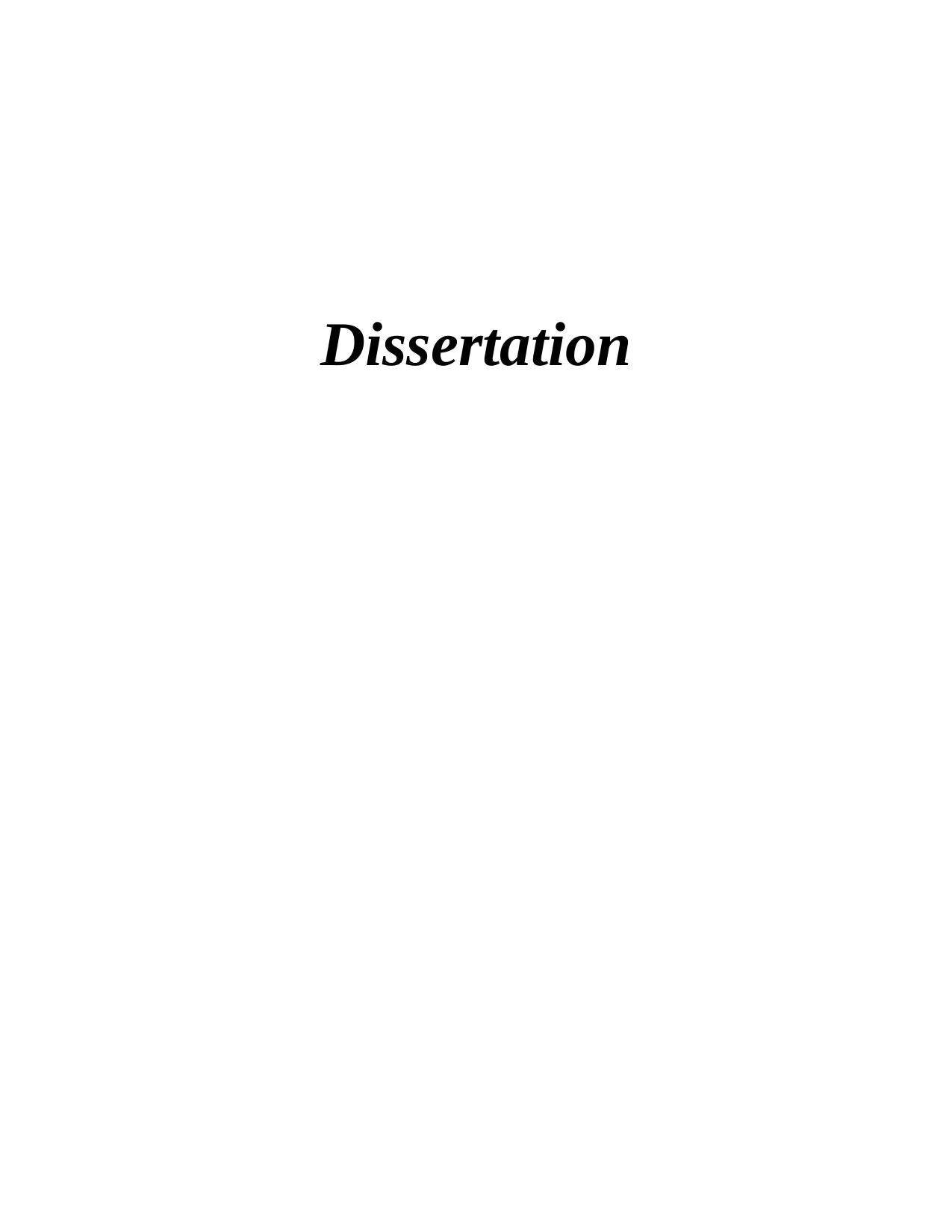
Dissertation
Secure Best Marks with AI Grader
Need help grading? Try our AI Grader for instant feedback on your assignments.
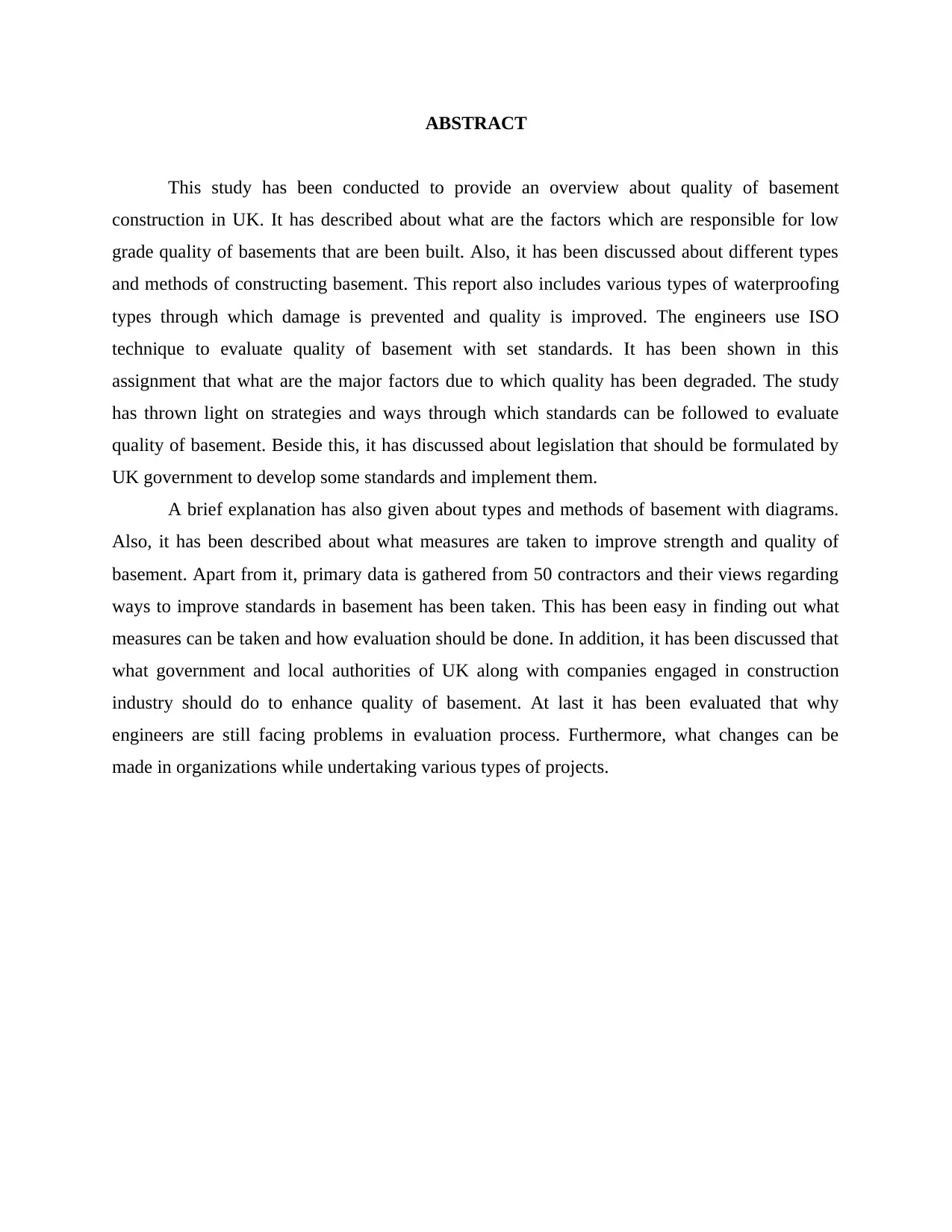
ABSTRACT
This study has been conducted to provide an overview about quality of basement
construction in UK. It has described about what are the factors which are responsible for low
grade quality of basements that are been built. Also, it has been discussed about different types
and methods of constructing basement. This report also includes various types of waterproofing
types through which damage is prevented and quality is improved. The engineers use ISO
technique to evaluate quality of basement with set standards. It has been shown in this
assignment that what are the major factors due to which quality has been degraded. The study
has thrown light on strategies and ways through which standards can be followed to evaluate
quality of basement. Beside this, it has discussed about legislation that should be formulated by
UK government to develop some standards and implement them.
A brief explanation has also given about types and methods of basement with diagrams.
Also, it has been described about what measures are taken to improve strength and quality of
basement. Apart from it, primary data is gathered from 50 contractors and their views regarding
ways to improve standards in basement has been taken. This has been easy in finding out what
measures can be taken and how evaluation should be done. In addition, it has been discussed that
what government and local authorities of UK along with companies engaged in construction
industry should do to enhance quality of basement. At last it has been evaluated that why
engineers are still facing problems in evaluation process. Furthermore, what changes can be
made in organizations while undertaking various types of projects.
This study has been conducted to provide an overview about quality of basement
construction in UK. It has described about what are the factors which are responsible for low
grade quality of basements that are been built. Also, it has been discussed about different types
and methods of constructing basement. This report also includes various types of waterproofing
types through which damage is prevented and quality is improved. The engineers use ISO
technique to evaluate quality of basement with set standards. It has been shown in this
assignment that what are the major factors due to which quality has been degraded. The study
has thrown light on strategies and ways through which standards can be followed to evaluate
quality of basement. Beside this, it has discussed about legislation that should be formulated by
UK government to develop some standards and implement them.
A brief explanation has also given about types and methods of basement with diagrams.
Also, it has been described about what measures are taken to improve strength and quality of
basement. Apart from it, primary data is gathered from 50 contractors and their views regarding
ways to improve standards in basement has been taken. This has been easy in finding out what
measures can be taken and how evaluation should be done. In addition, it has been discussed that
what government and local authorities of UK along with companies engaged in construction
industry should do to enhance quality of basement. At last it has been evaluated that why
engineers are still facing problems in evaluation process. Furthermore, what changes can be
made in organizations while undertaking various types of projects.
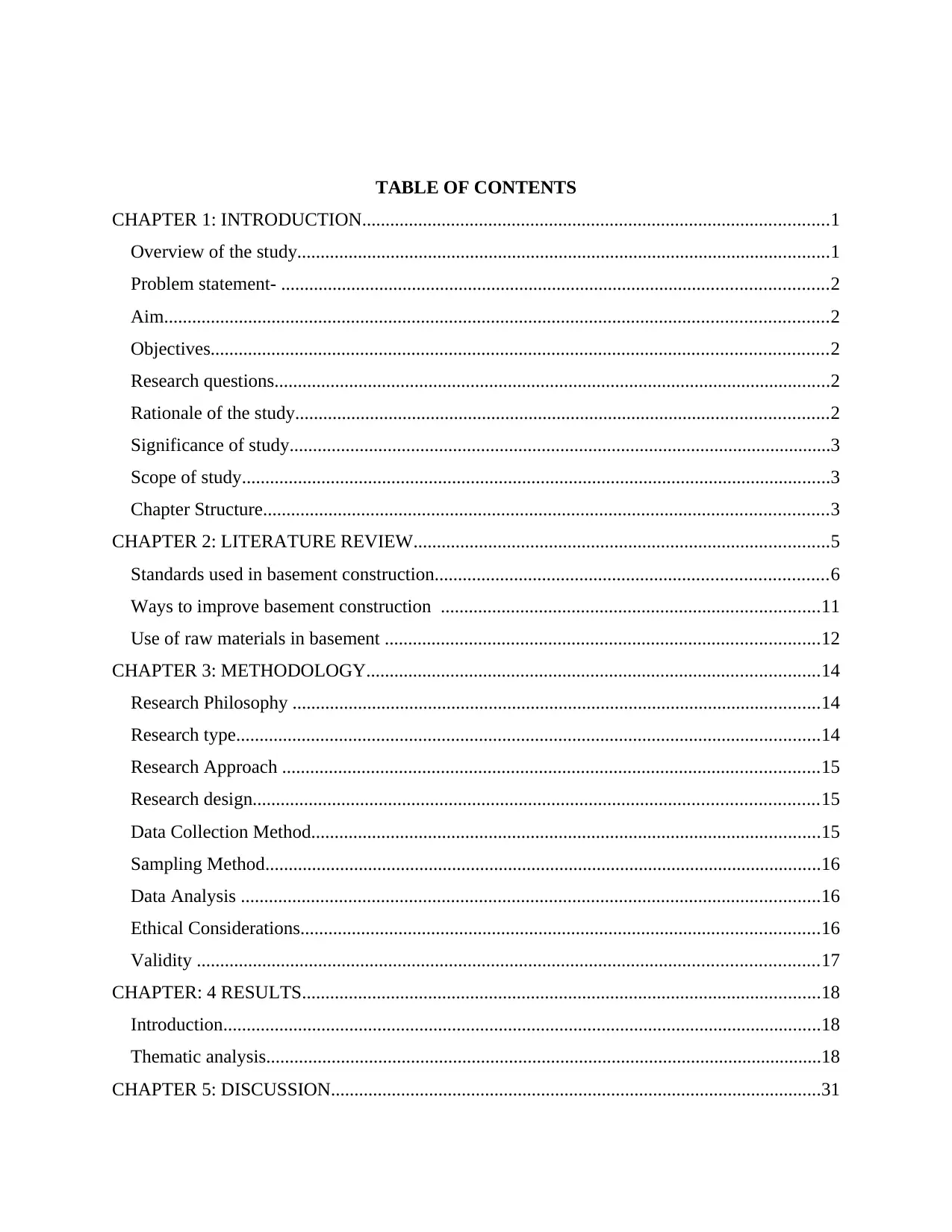
TABLE OF CONTENTS
CHAPTER 1: INTRODUCTION....................................................................................................1
Overview of the study..................................................................................................................1
Problem statement- .....................................................................................................................2
Aim..............................................................................................................................................2
Objectives....................................................................................................................................2
Research questions.......................................................................................................................2
Rationale of the study..................................................................................................................2
Significance of study....................................................................................................................3
Scope of study..............................................................................................................................3
Chapter Structure.........................................................................................................................3
CHAPTER 2: LITERATURE REVIEW.........................................................................................5
Standards used in basement construction....................................................................................6
Ways to improve basement construction .................................................................................11
Use of raw materials in basement .............................................................................................12
CHAPTER 3: METHODOLOGY.................................................................................................14
Research Philosophy .................................................................................................................14
Research type.............................................................................................................................14
Research Approach ...................................................................................................................15
Research design.........................................................................................................................15
Data Collection Method.............................................................................................................15
Sampling Method.......................................................................................................................16
Data Analysis ............................................................................................................................16
Ethical Considerations...............................................................................................................16
Validity .....................................................................................................................................17
CHAPTER: 4 RESULTS...............................................................................................................18
Introduction................................................................................................................................18
Thematic analysis.......................................................................................................................18
CHAPTER 5: DISCUSSION.........................................................................................................31
CHAPTER 1: INTRODUCTION....................................................................................................1
Overview of the study..................................................................................................................1
Problem statement- .....................................................................................................................2
Aim..............................................................................................................................................2
Objectives....................................................................................................................................2
Research questions.......................................................................................................................2
Rationale of the study..................................................................................................................2
Significance of study....................................................................................................................3
Scope of study..............................................................................................................................3
Chapter Structure.........................................................................................................................3
CHAPTER 2: LITERATURE REVIEW.........................................................................................5
Standards used in basement construction....................................................................................6
Ways to improve basement construction .................................................................................11
Use of raw materials in basement .............................................................................................12
CHAPTER 3: METHODOLOGY.................................................................................................14
Research Philosophy .................................................................................................................14
Research type.............................................................................................................................14
Research Approach ...................................................................................................................15
Research design.........................................................................................................................15
Data Collection Method.............................................................................................................15
Sampling Method.......................................................................................................................16
Data Analysis ............................................................................................................................16
Ethical Considerations...............................................................................................................16
Validity .....................................................................................................................................17
CHAPTER: 4 RESULTS...............................................................................................................18
Introduction................................................................................................................................18
Thematic analysis.......................................................................................................................18
CHAPTER 5: DISCUSSION.........................................................................................................31

CHAPTER 6 CONCLUSION........................................................................................................36
REFERENCES .............................................................................................................................39
APPENDIX....................................................................................................................................41
REFERENCES .............................................................................................................................39
APPENDIX....................................................................................................................................41
Secure Best Marks with AI Grader
Need help grading? Try our AI Grader for instant feedback on your assignments.
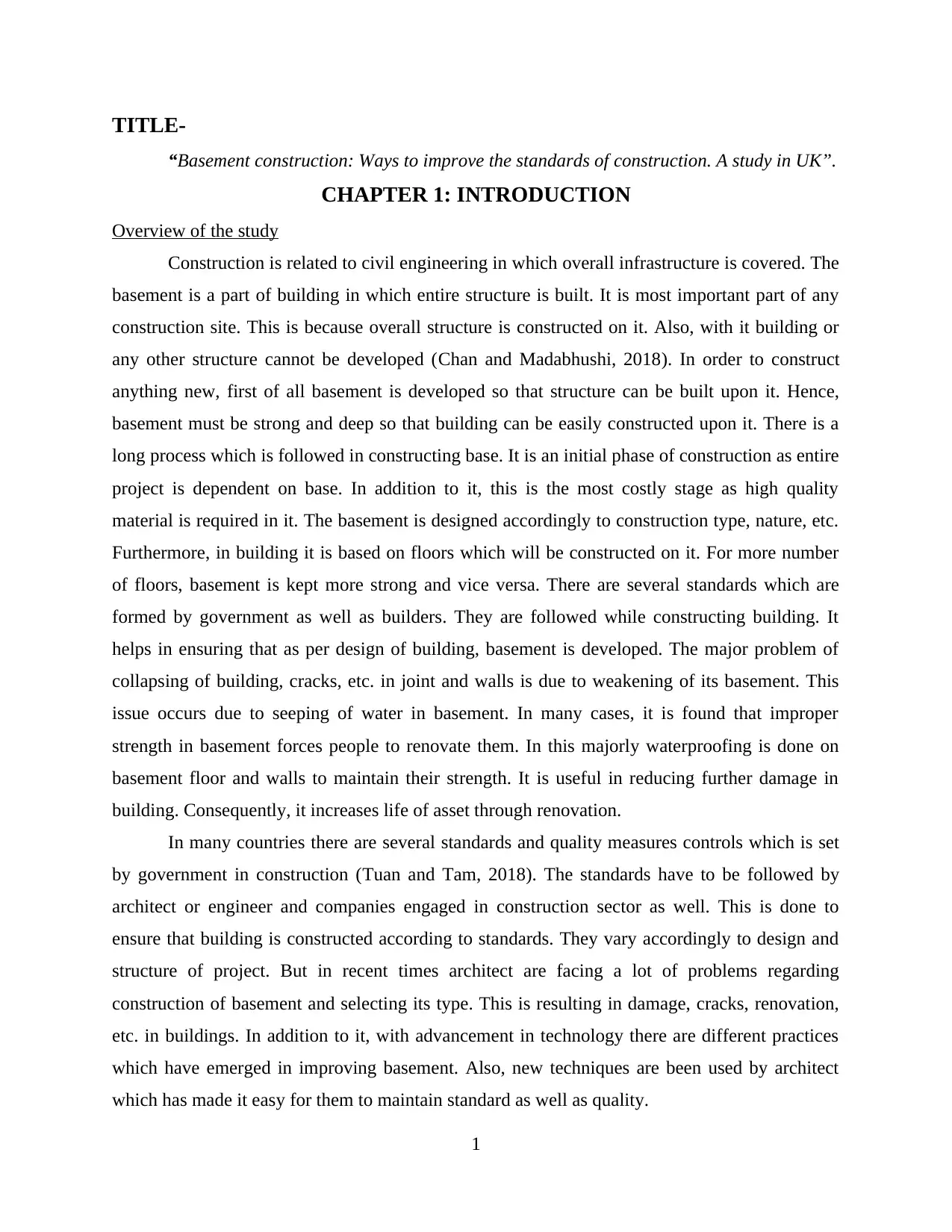
TITLE-
“Basement construction: Ways to improve the standards of construction. A study in UK”.
CHAPTER 1: INTRODUCTION
Overview of the study
Construction is related to civil engineering in which overall infrastructure is covered. The
basement is a part of building in which entire structure is built. It is most important part of any
construction site. This is because overall structure is constructed on it. Also, with it building or
any other structure cannot be developed (Chan and Madabhushi, 2018). In order to construct
anything new, first of all basement is developed so that structure can be built upon it. Hence,
basement must be strong and deep so that building can be easily constructed upon it. There is a
long process which is followed in constructing base. It is an initial phase of construction as entire
project is dependent on base. In addition to it, this is the most costly stage as high quality
material is required in it. The basement is designed accordingly to construction type, nature, etc.
Furthermore, in building it is based on floors which will be constructed on it. For more number
of floors, basement is kept more strong and vice versa. There are several standards which are
formed by government as well as builders. They are followed while constructing building. It
helps in ensuring that as per design of building, basement is developed. The major problem of
collapsing of building, cracks, etc. in joint and walls is due to weakening of its basement. This
issue occurs due to seeping of water in basement. In many cases, it is found that improper
strength in basement forces people to renovate them. In this majorly waterproofing is done on
basement floor and walls to maintain their strength. It is useful in reducing further damage in
building. Consequently, it increases life of asset through renovation.
In many countries there are several standards and quality measures controls which is set
by government in construction (Tuan and Tam, 2018). The standards have to be followed by
architect or engineer and companies engaged in construction sector as well. This is done to
ensure that building is constructed according to standards. They vary accordingly to design and
structure of project. But in recent times architect are facing a lot of problems regarding
construction of basement and selecting its type. This is resulting in damage, cracks, renovation,
etc. in buildings. In addition to it, with advancement in technology there are different practices
which have emerged in improving basement. Also, new techniques are been used by architect
which has made it easy for them to maintain standard as well as quality.
1
“Basement construction: Ways to improve the standards of construction. A study in UK”.
CHAPTER 1: INTRODUCTION
Overview of the study
Construction is related to civil engineering in which overall infrastructure is covered. The
basement is a part of building in which entire structure is built. It is most important part of any
construction site. This is because overall structure is constructed on it. Also, with it building or
any other structure cannot be developed (Chan and Madabhushi, 2018). In order to construct
anything new, first of all basement is developed so that structure can be built upon it. Hence,
basement must be strong and deep so that building can be easily constructed upon it. There is a
long process which is followed in constructing base. It is an initial phase of construction as entire
project is dependent on base. In addition to it, this is the most costly stage as high quality
material is required in it. The basement is designed accordingly to construction type, nature, etc.
Furthermore, in building it is based on floors which will be constructed on it. For more number
of floors, basement is kept more strong and vice versa. There are several standards which are
formed by government as well as builders. They are followed while constructing building. It
helps in ensuring that as per design of building, basement is developed. The major problem of
collapsing of building, cracks, etc. in joint and walls is due to weakening of its basement. This
issue occurs due to seeping of water in basement. In many cases, it is found that improper
strength in basement forces people to renovate them. In this majorly waterproofing is done on
basement floor and walls to maintain their strength. It is useful in reducing further damage in
building. Consequently, it increases life of asset through renovation.
In many countries there are several standards and quality measures controls which is set
by government in construction (Tuan and Tam, 2018). The standards have to be followed by
architect or engineer and companies engaged in construction sector as well. This is done to
ensure that building is constructed according to standards. They vary accordingly to design and
structure of project. But in recent times architect are facing a lot of problems regarding
construction of basement and selecting its type. This is resulting in damage, cracks, renovation,
etc. in buildings. In addition to it, with advancement in technology there are different practices
which have emerged in improving basement. Also, new techniques are been used by architect
which has made it easy for them to maintain standard as well as quality.
1
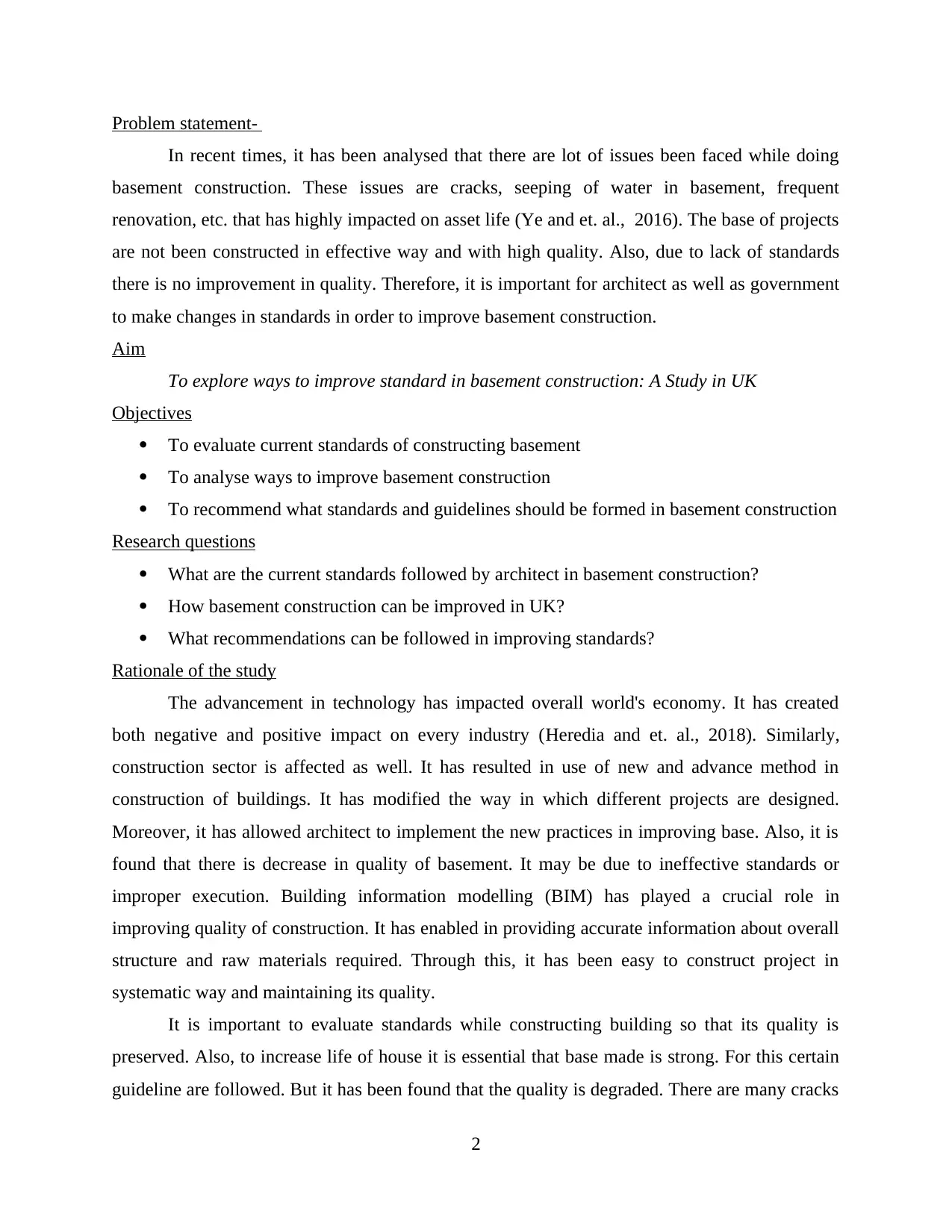
Problem statement-
In recent times, it has been analysed that there are lot of issues been faced while doing
basement construction. These issues are cracks, seeping of water in basement, frequent
renovation, etc. that has highly impacted on asset life (Ye and et. al., 2016). The base of projects
are not been constructed in effective way and with high quality. Also, due to lack of standards
there is no improvement in quality. Therefore, it is important for architect as well as government
to make changes in standards in order to improve basement construction.
Aim
To explore ways to improve standard in basement construction: A Study in UK
Objectives
To evaluate current standards of constructing basement
To analyse ways to improve basement construction
To recommend what standards and guidelines should be formed in basement construction
Research questions
What are the current standards followed by architect in basement construction?
How basement construction can be improved in UK?
What recommendations can be followed in improving standards?
Rationale of the study
The advancement in technology has impacted overall world's economy. It has created
both negative and positive impact on every industry (Heredia and et. al., 2018). Similarly,
construction sector is affected as well. It has resulted in use of new and advance method in
construction of buildings. It has modified the way in which different projects are designed.
Moreover, it has allowed architect to implement the new practices in improving base. Also, it is
found that there is decrease in quality of basement. It may be due to ineffective standards or
improper execution. Building information modelling (BIM) has played a crucial role in
improving quality of construction. It has enabled in providing accurate information about overall
structure and raw materials required. Through this, it has been easy to construct project in
systematic way and maintaining its quality.
It is important to evaluate standards while constructing building so that its quality is
preserved. Also, to increase life of house it is essential that base made is strong. For this certain
guideline are followed. But it has been found that the quality is degraded. There are many cracks
2
In recent times, it has been analysed that there are lot of issues been faced while doing
basement construction. These issues are cracks, seeping of water in basement, frequent
renovation, etc. that has highly impacted on asset life (Ye and et. al., 2016). The base of projects
are not been constructed in effective way and with high quality. Also, due to lack of standards
there is no improvement in quality. Therefore, it is important for architect as well as government
to make changes in standards in order to improve basement construction.
Aim
To explore ways to improve standard in basement construction: A Study in UK
Objectives
To evaluate current standards of constructing basement
To analyse ways to improve basement construction
To recommend what standards and guidelines should be formed in basement construction
Research questions
What are the current standards followed by architect in basement construction?
How basement construction can be improved in UK?
What recommendations can be followed in improving standards?
Rationale of the study
The advancement in technology has impacted overall world's economy. It has created
both negative and positive impact on every industry (Heredia and et. al., 2018). Similarly,
construction sector is affected as well. It has resulted in use of new and advance method in
construction of buildings. It has modified the way in which different projects are designed.
Moreover, it has allowed architect to implement the new practices in improving base. Also, it is
found that there is decrease in quality of basement. It may be due to ineffective standards or
improper execution. Building information modelling (BIM) has played a crucial role in
improving quality of construction. It has enabled in providing accurate information about overall
structure and raw materials required. Through this, it has been easy to construct project in
systematic way and maintaining its quality.
It is important to evaluate standards while constructing building so that its quality is
preserved. Also, to increase life of house it is essential that base made is strong. For this certain
guideline are followed. But it has been found that the quality is degraded. There are many cracks
2
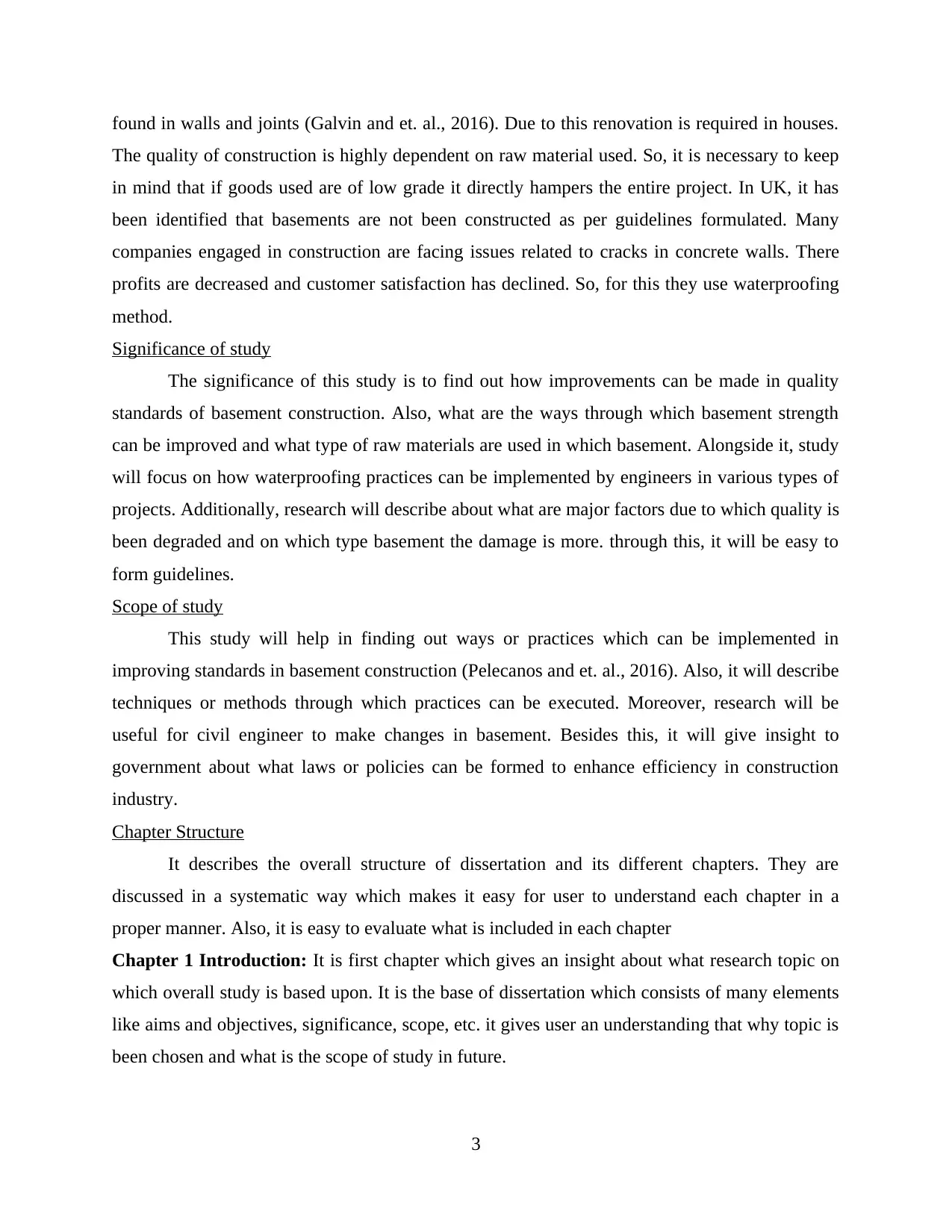
found in walls and joints (Galvin and et. al., 2016). Due to this renovation is required in houses.
The quality of construction is highly dependent on raw material used. So, it is necessary to keep
in mind that if goods used are of low grade it directly hampers the entire project. In UK, it has
been identified that basements are not been constructed as per guidelines formulated. Many
companies engaged in construction are facing issues related to cracks in concrete walls. There
profits are decreased and customer satisfaction has declined. So, for this they use waterproofing
method.
Significance of study
The significance of this study is to find out how improvements can be made in quality
standards of basement construction. Also, what are the ways through which basement strength
can be improved and what type of raw materials are used in which basement. Alongside it, study
will focus on how waterproofing practices can be implemented by engineers in various types of
projects. Additionally, research will describe about what are major factors due to which quality is
been degraded and on which type basement the damage is more. through this, it will be easy to
form guidelines.
Scope of study
This study will help in finding out ways or practices which can be implemented in
improving standards in basement construction (Pelecanos and et. al., 2016). Also, it will describe
techniques or methods through which practices can be executed. Moreover, research will be
useful for civil engineer to make changes in basement. Besides this, it will give insight to
government about what laws or policies can be formed to enhance efficiency in construction
industry.
Chapter Structure
It describes the overall structure of dissertation and its different chapters. They are
discussed in a systematic way which makes it easy for user to understand each chapter in a
proper manner. Also, it is easy to evaluate what is included in each chapter
Chapter 1 Introduction: It is first chapter which gives an insight about what research topic on
which overall study is based upon. It is the base of dissertation which consists of many elements
like aims and objectives, significance, scope, etc. it gives user an understanding that why topic is
been chosen and what is the scope of study in future.
3
The quality of construction is highly dependent on raw material used. So, it is necessary to keep
in mind that if goods used are of low grade it directly hampers the entire project. In UK, it has
been identified that basements are not been constructed as per guidelines formulated. Many
companies engaged in construction are facing issues related to cracks in concrete walls. There
profits are decreased and customer satisfaction has declined. So, for this they use waterproofing
method.
Significance of study
The significance of this study is to find out how improvements can be made in quality
standards of basement construction. Also, what are the ways through which basement strength
can be improved and what type of raw materials are used in which basement. Alongside it, study
will focus on how waterproofing practices can be implemented by engineers in various types of
projects. Additionally, research will describe about what are major factors due to which quality is
been degraded and on which type basement the damage is more. through this, it will be easy to
form guidelines.
Scope of study
This study will help in finding out ways or practices which can be implemented in
improving standards in basement construction (Pelecanos and et. al., 2016). Also, it will describe
techniques or methods through which practices can be executed. Moreover, research will be
useful for civil engineer to make changes in basement. Besides this, it will give insight to
government about what laws or policies can be formed to enhance efficiency in construction
industry.
Chapter Structure
It describes the overall structure of dissertation and its different chapters. They are
discussed in a systematic way which makes it easy for user to understand each chapter in a
proper manner. Also, it is easy to evaluate what is included in each chapter
Chapter 1 Introduction: It is first chapter which gives an insight about what research topic on
which overall study is based upon. It is the base of dissertation which consists of many elements
like aims and objectives, significance, scope, etc. it gives user an understanding that why topic is
been chosen and what is the scope of study in future.
3
Paraphrase This Document
Need a fresh take? Get an instant paraphrase of this document with our AI Paraphraser
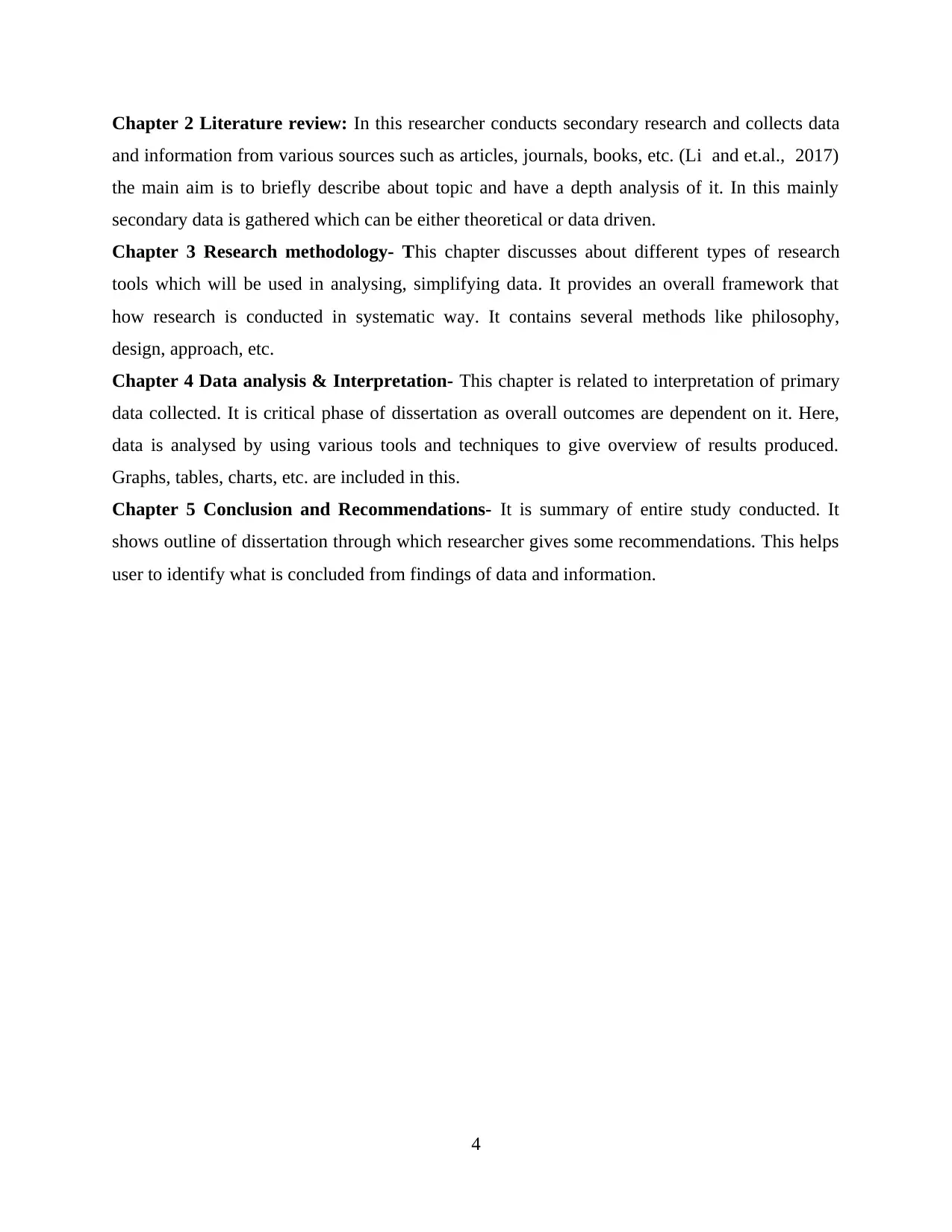
Chapter 2 Literature review: In this researcher conducts secondary research and collects data
and information from various sources such as articles, journals, books, etc. (Li and et.al., 2017)
the main aim is to briefly describe about topic and have a depth analysis of it. In this mainly
secondary data is gathered which can be either theoretical or data driven.
Chapter 3 Research methodology- This chapter discusses about different types of research
tools which will be used in analysing, simplifying data. It provides an overall framework that
how research is conducted in systematic way. It contains several methods like philosophy,
design, approach, etc.
Chapter 4 Data analysis & Interpretation- This chapter is related to interpretation of primary
data collected. It is critical phase of dissertation as overall outcomes are dependent on it. Here,
data is analysed by using various tools and techniques to give overview of results produced.
Graphs, tables, charts, etc. are included in this.
Chapter 5 Conclusion and Recommendations- It is summary of entire study conducted. It
shows outline of dissertation through which researcher gives some recommendations. This helps
user to identify what is concluded from findings of data and information.
4
and information from various sources such as articles, journals, books, etc. (Li and et.al., 2017)
the main aim is to briefly describe about topic and have a depth analysis of it. In this mainly
secondary data is gathered which can be either theoretical or data driven.
Chapter 3 Research methodology- This chapter discusses about different types of research
tools which will be used in analysing, simplifying data. It provides an overall framework that
how research is conducted in systematic way. It contains several methods like philosophy,
design, approach, etc.
Chapter 4 Data analysis & Interpretation- This chapter is related to interpretation of primary
data collected. It is critical phase of dissertation as overall outcomes are dependent on it. Here,
data is analysed by using various tools and techniques to give overview of results produced.
Graphs, tables, charts, etc. are included in this.
Chapter 5 Conclusion and Recommendations- It is summary of entire study conducted. It
shows outline of dissertation through which researcher gives some recommendations. This helps
user to identify what is concluded from findings of data and information.
4
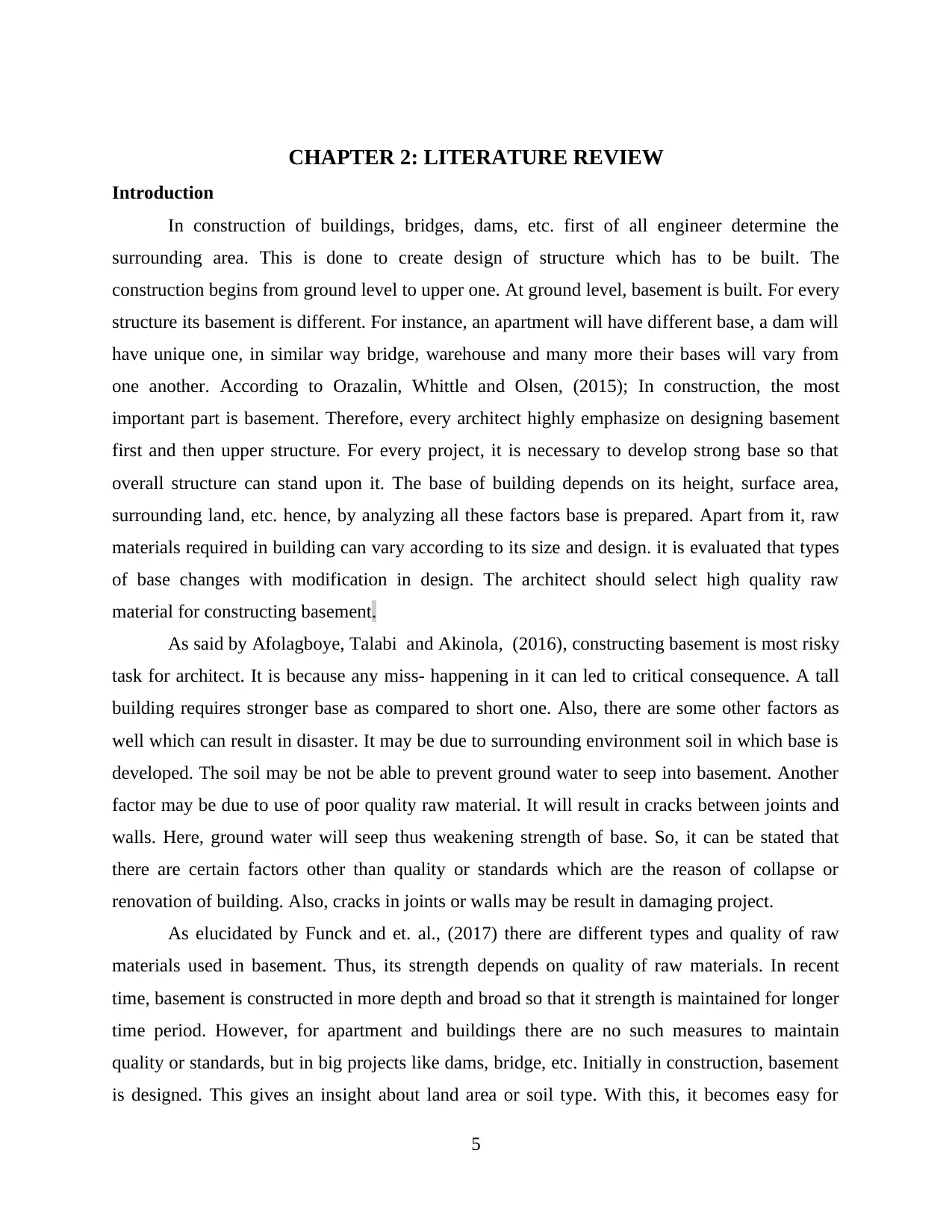
CHAPTER 2: LITERATURE REVIEW
Introduction
In construction of buildings, bridges, dams, etc. first of all engineer determine the
surrounding area. This is done to create design of structure which has to be built. The
construction begins from ground level to upper one. At ground level, basement is built. For every
structure its basement is different. For instance, an apartment will have different base, a dam will
have unique one, in similar way bridge, warehouse and many more their bases will vary from
one another. According to Orazalin, Whittle and Olsen, (2015); In construction, the most
important part is basement. Therefore, every architect highly emphasize on designing basement
first and then upper structure. For every project, it is necessary to develop strong base so that
overall structure can stand upon it. The base of building depends on its height, surface area,
surrounding land, etc. hence, by analyzing all these factors base is prepared. Apart from it, raw
materials required in building can vary according to its size and design. it is evaluated that types
of base changes with modification in design. The architect should select high quality raw
material for constructing basement.
As said by Afolagboye, Talabi and Akinola, (2016), constructing basement is most risky
task for architect. It is because any miss- happening in it can led to critical consequence. A tall
building requires stronger base as compared to short one. Also, there are some other factors as
well which can result in disaster. It may be due to surrounding environment soil in which base is
developed. The soil may be not be able to prevent ground water to seep into basement. Another
factor may be due to use of poor quality raw material. It will result in cracks between joints and
walls. Here, ground water will seep thus weakening strength of base. So, it can be stated that
there are certain factors other than quality or standards which are the reason of collapse or
renovation of building. Also, cracks in joints or walls may be result in damaging project.
As elucidated by Funck and et. al., (2017) there are different types and quality of raw
materials used in basement. Thus, its strength depends on quality of raw materials. In recent
time, basement is constructed in more depth and broad so that it strength is maintained for longer
time period. However, for apartment and buildings there are no such measures to maintain
quality or standards, but in big projects like dams, bridge, etc. Initially in construction, basement
is designed. This gives an insight about land area or soil type. With this, it becomes easy for
5
Introduction
In construction of buildings, bridges, dams, etc. first of all engineer determine the
surrounding area. This is done to create design of structure which has to be built. The
construction begins from ground level to upper one. At ground level, basement is built. For every
structure its basement is different. For instance, an apartment will have different base, a dam will
have unique one, in similar way bridge, warehouse and many more their bases will vary from
one another. According to Orazalin, Whittle and Olsen, (2015); In construction, the most
important part is basement. Therefore, every architect highly emphasize on designing basement
first and then upper structure. For every project, it is necessary to develop strong base so that
overall structure can stand upon it. The base of building depends on its height, surface area,
surrounding land, etc. hence, by analyzing all these factors base is prepared. Apart from it, raw
materials required in building can vary according to its size and design. it is evaluated that types
of base changes with modification in design. The architect should select high quality raw
material for constructing basement.
As said by Afolagboye, Talabi and Akinola, (2016), constructing basement is most risky
task for architect. It is because any miss- happening in it can led to critical consequence. A tall
building requires stronger base as compared to short one. Also, there are some other factors as
well which can result in disaster. It may be due to surrounding environment soil in which base is
developed. The soil may be not be able to prevent ground water to seep into basement. Another
factor may be due to use of poor quality raw material. It will result in cracks between joints and
walls. Here, ground water will seep thus weakening strength of base. So, it can be stated that
there are certain factors other than quality or standards which are the reason of collapse or
renovation of building. Also, cracks in joints or walls may be result in damaging project.
As elucidated by Funck and et. al., (2017) there are different types and quality of raw
materials used in basement. Thus, its strength depends on quality of raw materials. In recent
time, basement is constructed in more depth and broad so that it strength is maintained for longer
time period. However, for apartment and buildings there are no such measures to maintain
quality or standards, but in big projects like dams, bridge, etc. Initially in construction, basement
is designed. This gives an insight about land area or soil type. With this, it becomes easy for
5
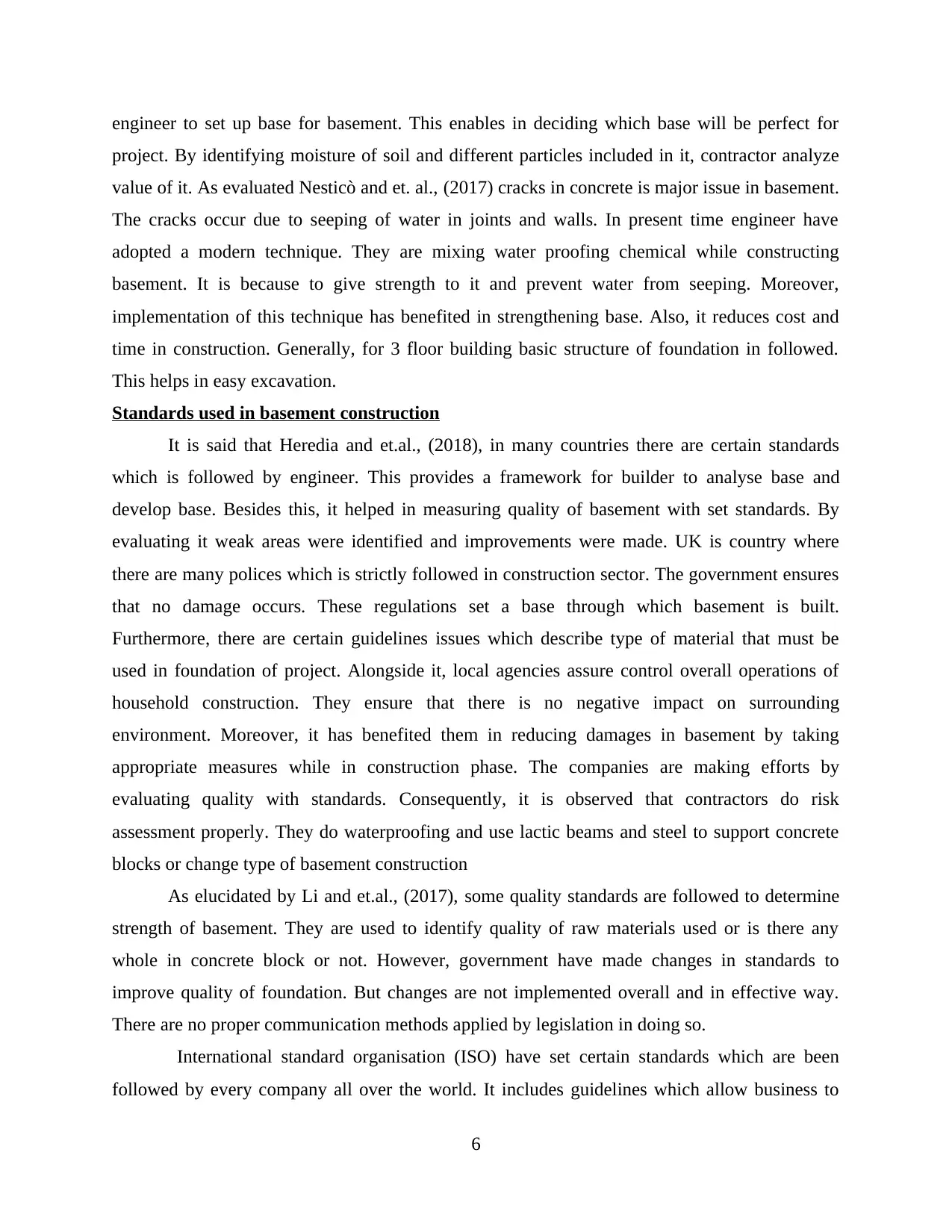
engineer to set up base for basement. This enables in deciding which base will be perfect for
project. By identifying moisture of soil and different particles included in it, contractor analyze
value of it. As evaluated Nesticò and et. al., (2017) cracks in concrete is major issue in basement.
The cracks occur due to seeping of water in joints and walls. In present time engineer have
adopted a modern technique. They are mixing water proofing chemical while constructing
basement. It is because to give strength to it and prevent water from seeping. Moreover,
implementation of this technique has benefited in strengthening base. Also, it reduces cost and
time in construction. Generally, for 3 floor building basic structure of foundation in followed.
This helps in easy excavation.
Standards used in basement construction
It is said that Heredia and et.al., (2018), in many countries there are certain standards
which is followed by engineer. This provides a framework for builder to analyse base and
develop base. Besides this, it helped in measuring quality of basement with set standards. By
evaluating it weak areas were identified and improvements were made. UK is country where
there are many polices which is strictly followed in construction sector. The government ensures
that no damage occurs. These regulations set a base through which basement is built.
Furthermore, there are certain guidelines issues which describe type of material that must be
used in foundation of project. Alongside it, local agencies assure control overall operations of
household construction. They ensure that there is no negative impact on surrounding
environment. Moreover, it has benefited them in reducing damages in basement by taking
appropriate measures while in construction phase. The companies are making efforts by
evaluating quality with standards. Consequently, it is observed that contractors do risk
assessment properly. They do waterproofing and use lactic beams and steel to support concrete
blocks or change type of basement construction
As elucidated by Li and et.al., (2017), some quality standards are followed to determine
strength of basement. They are used to identify quality of raw materials used or is there any
whole in concrete block or not. However, government have made changes in standards to
improve quality of foundation. But changes are not implemented overall and in effective way.
There are no proper communication methods applied by legislation in doing so.
International standard organisation (ISO) have set certain standards which are been
followed by every company all over the world. It includes guidelines which allow business to
6
project. By identifying moisture of soil and different particles included in it, contractor analyze
value of it. As evaluated Nesticò and et. al., (2017) cracks in concrete is major issue in basement.
The cracks occur due to seeping of water in joints and walls. In present time engineer have
adopted a modern technique. They are mixing water proofing chemical while constructing
basement. It is because to give strength to it and prevent water from seeping. Moreover,
implementation of this technique has benefited in strengthening base. Also, it reduces cost and
time in construction. Generally, for 3 floor building basic structure of foundation in followed.
This helps in easy excavation.
Standards used in basement construction
It is said that Heredia and et.al., (2018), in many countries there are certain standards
which is followed by engineer. This provides a framework for builder to analyse base and
develop base. Besides this, it helped in measuring quality of basement with set standards. By
evaluating it weak areas were identified and improvements were made. UK is country where
there are many polices which is strictly followed in construction sector. The government ensures
that no damage occurs. These regulations set a base through which basement is built.
Furthermore, there are certain guidelines issues which describe type of material that must be
used in foundation of project. Alongside it, local agencies assure control overall operations of
household construction. They ensure that there is no negative impact on surrounding
environment. Moreover, it has benefited them in reducing damages in basement by taking
appropriate measures while in construction phase. The companies are making efforts by
evaluating quality with standards. Consequently, it is observed that contractors do risk
assessment properly. They do waterproofing and use lactic beams and steel to support concrete
blocks or change type of basement construction
As elucidated by Li and et.al., (2017), some quality standards are followed to determine
strength of basement. They are used to identify quality of raw materials used or is there any
whole in concrete block or not. However, government have made changes in standards to
improve quality of foundation. But changes are not implemented overall and in effective way.
There are no proper communication methods applied by legislation in doing so.
International standard organisation (ISO) have set certain standards which are been
followed by every company all over the world. It includes guidelines which allow business to
6
Secure Best Marks with AI Grader
Need help grading? Try our AI Grader for instant feedback on your assignments.
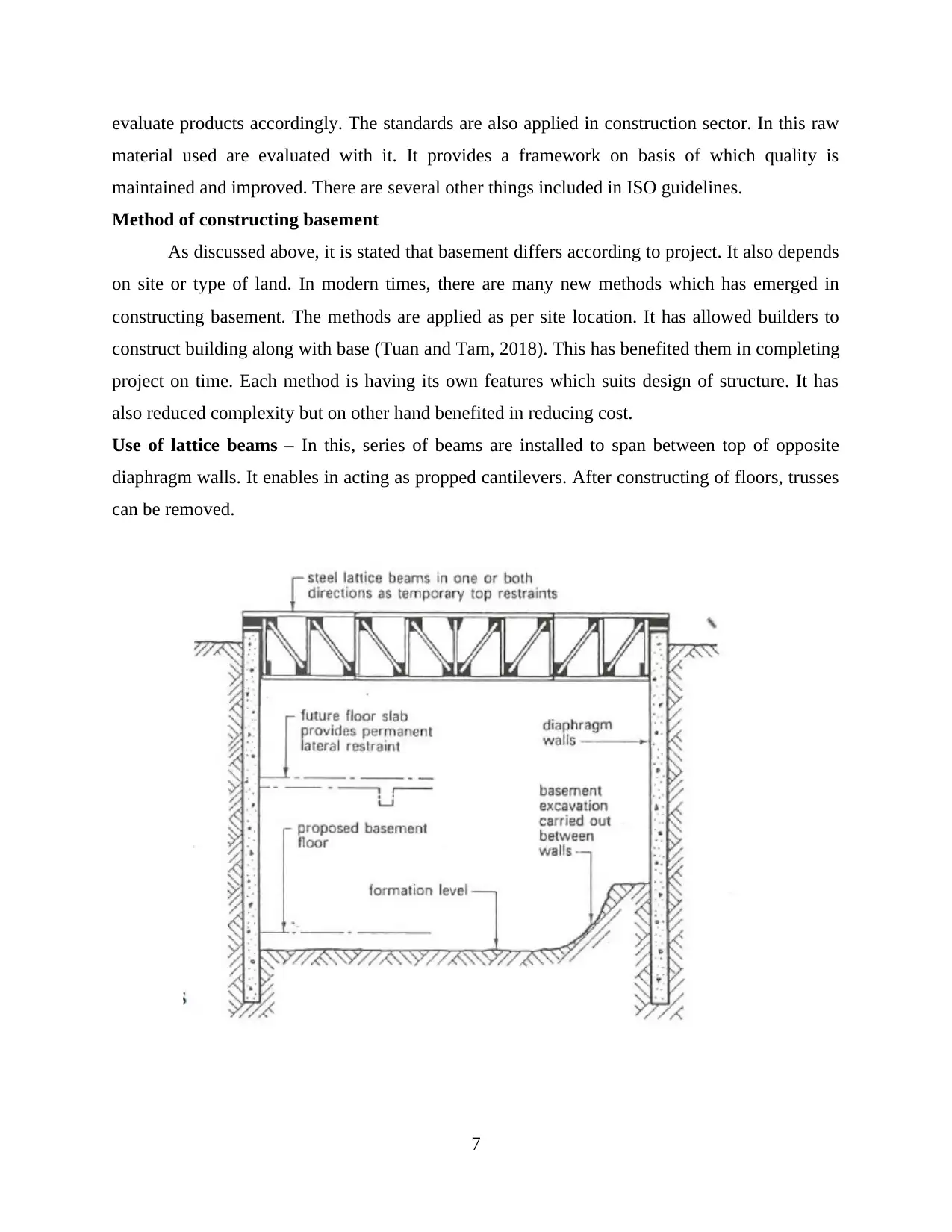
evaluate products accordingly. The standards are also applied in construction sector. In this raw
material used are evaluated with it. It provides a framework on basis of which quality is
maintained and improved. There are several other things included in ISO guidelines.
Method of constructing basement
As discussed above, it is stated that basement differs according to project. It also depends
on site or type of land. In modern times, there are many new methods which has emerged in
constructing basement. The methods are applied as per site location. It has allowed builders to
construct building along with base (Tuan and Tam, 2018). This has benefited them in completing
project on time. Each method is having its own features which suits design of structure. It has
also reduced complexity but on other hand benefited in reducing cost.
Use of lattice beams – In this, series of beams are installed to span between top of opposite
diaphragm walls. It enables in acting as propped cantilevers. After constructing of floors, trusses
can be removed.
7
material used are evaluated with it. It provides a framework on basis of which quality is
maintained and improved. There are several other things included in ISO guidelines.
Method of constructing basement
As discussed above, it is stated that basement differs according to project. It also depends
on site or type of land. In modern times, there are many new methods which has emerged in
constructing basement. The methods are applied as per site location. It has allowed builders to
construct building along with base (Tuan and Tam, 2018). This has benefited them in completing
project on time. Each method is having its own features which suits design of structure. It has
also reduced complexity but on other hand benefited in reducing cost.
Use of lattice beams – In this, series of beams are installed to span between top of opposite
diaphragm walls. It enables in acting as propped cantilevers. After constructing of floors, trusses
can be removed.
7
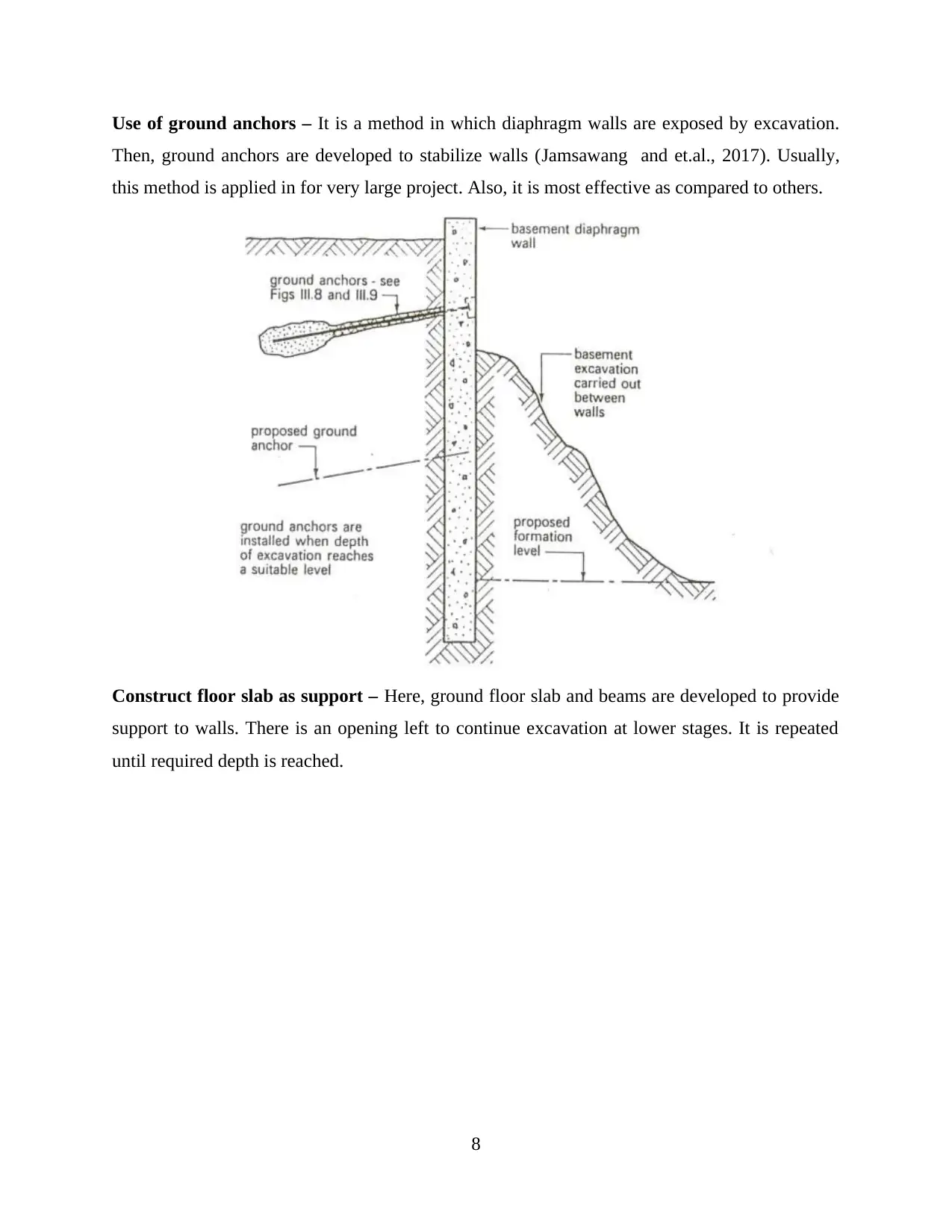
Use of ground anchors – It is a method in which diaphragm walls are exposed by excavation.
Then, ground anchors are developed to stabilize walls (Jamsawang and et.al., 2017). Usually,
this method is applied in for very large project. Also, it is most effective as compared to others.
Construct floor slab as support – Here, ground floor slab and beams are developed to provide
support to walls. There is an opening left to continue excavation at lower stages. It is repeated
until required depth is reached.
8
Then, ground anchors are developed to stabilize walls (Jamsawang and et.al., 2017). Usually,
this method is applied in for very large project. Also, it is most effective as compared to others.
Construct floor slab as support – Here, ground floor slab and beams are developed to provide
support to walls. There is an opening left to continue excavation at lower stages. It is repeated
until required depth is reached.
8
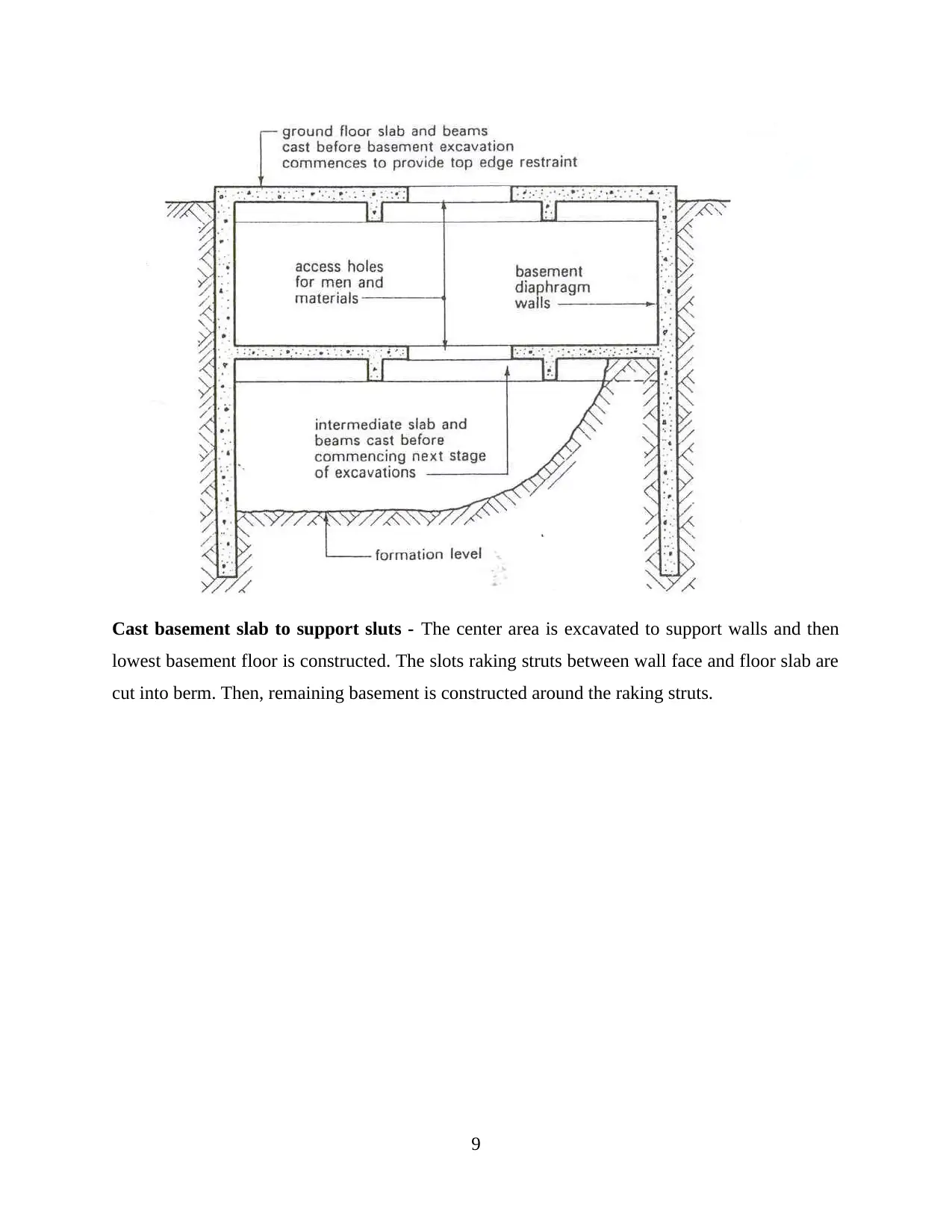
Cast basement slab to support sluts - The center area is excavated to support walls and then
lowest basement floor is constructed. The slots raking struts between wall face and floor slab are
cut into berm. Then, remaining basement is constructed around the raking struts.
9
lowest basement floor is constructed. The slots raking struts between wall face and floor slab are
cut into berm. Then, remaining basement is constructed around the raking struts.
9
Paraphrase This Document
Need a fresh take? Get an instant paraphrase of this document with our AI Paraphraser
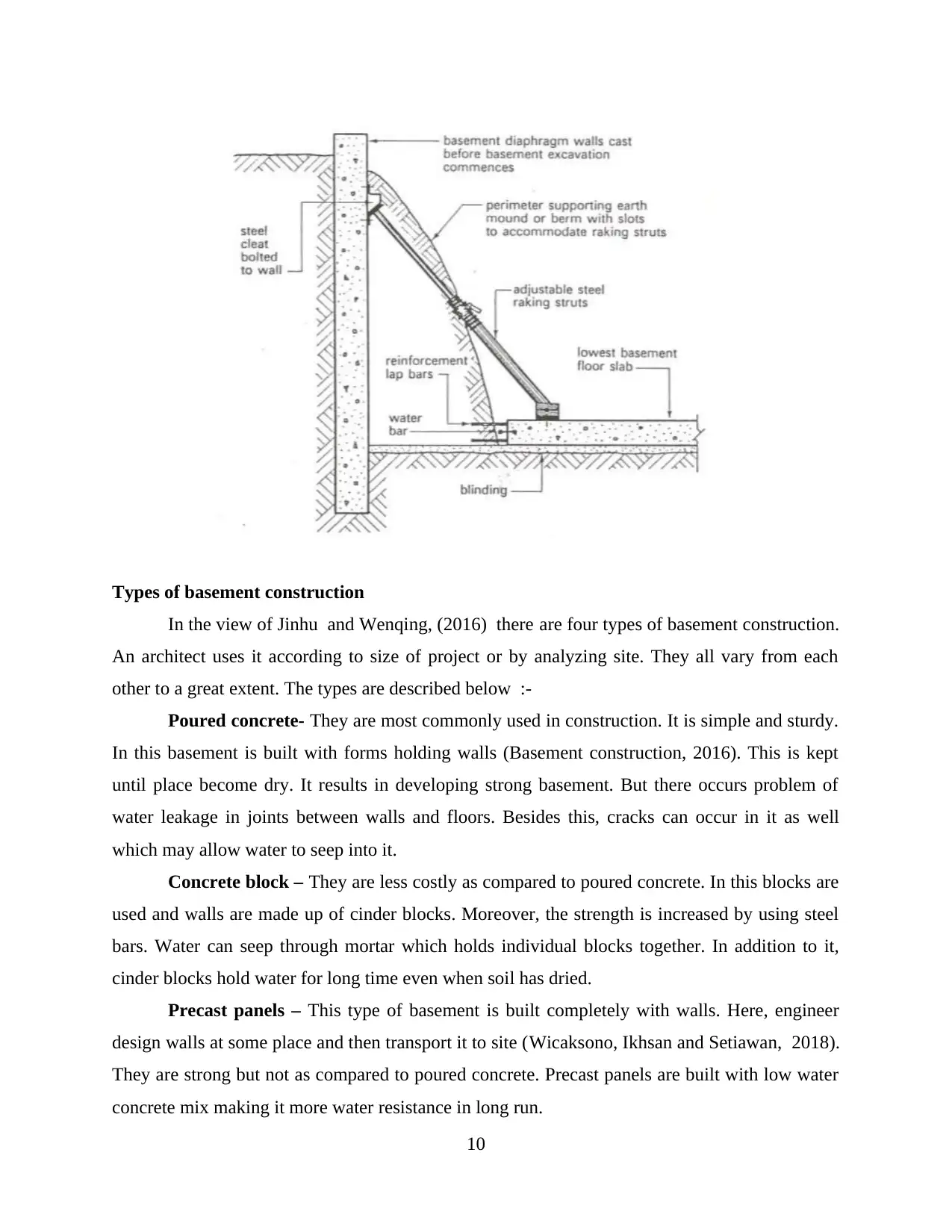
Types of basement construction
In the view of Jinhu and Wenqing, (2016) there are four types of basement construction.
An architect uses it according to size of project or by analyzing site. They all vary from each
other to a great extent. The types are described below :-
Poured concrete- They are most commonly used in construction. It is simple and sturdy.
In this basement is built with forms holding walls (Basement construction, 2016). This is kept
until place become dry. It results in developing strong basement. But there occurs problem of
water leakage in joints between walls and floors. Besides this, cracks can occur in it as well
which may allow water to seep into it.
Concrete block – They are less costly as compared to poured concrete. In this blocks are
used and walls are made up of cinder blocks. Moreover, the strength is increased by using steel
bars. Water can seep through mortar which holds individual blocks together. In addition to it,
cinder blocks hold water for long time even when soil has dried.
Precast panels – This type of basement is built completely with walls. Here, engineer
design walls at some place and then transport it to site (Wicaksono, Ikhsan and Setiawan, 2018).
They are strong but not as compared to poured concrete. Precast panels are built with low water
concrete mix making it more water resistance in long run.
10
In the view of Jinhu and Wenqing, (2016) there are four types of basement construction.
An architect uses it according to size of project or by analyzing site. They all vary from each
other to a great extent. The types are described below :-
Poured concrete- They are most commonly used in construction. It is simple and sturdy.
In this basement is built with forms holding walls (Basement construction, 2016). This is kept
until place become dry. It results in developing strong basement. But there occurs problem of
water leakage in joints between walls and floors. Besides this, cracks can occur in it as well
which may allow water to seep into it.
Concrete block – They are less costly as compared to poured concrete. In this blocks are
used and walls are made up of cinder blocks. Moreover, the strength is increased by using steel
bars. Water can seep through mortar which holds individual blocks together. In addition to it,
cinder blocks hold water for long time even when soil has dried.
Precast panels – This type of basement is built completely with walls. Here, engineer
design walls at some place and then transport it to site (Wicaksono, Ikhsan and Setiawan, 2018).
They are strong but not as compared to poured concrete. Precast panels are built with low water
concrete mix making it more water resistance in long run.
10
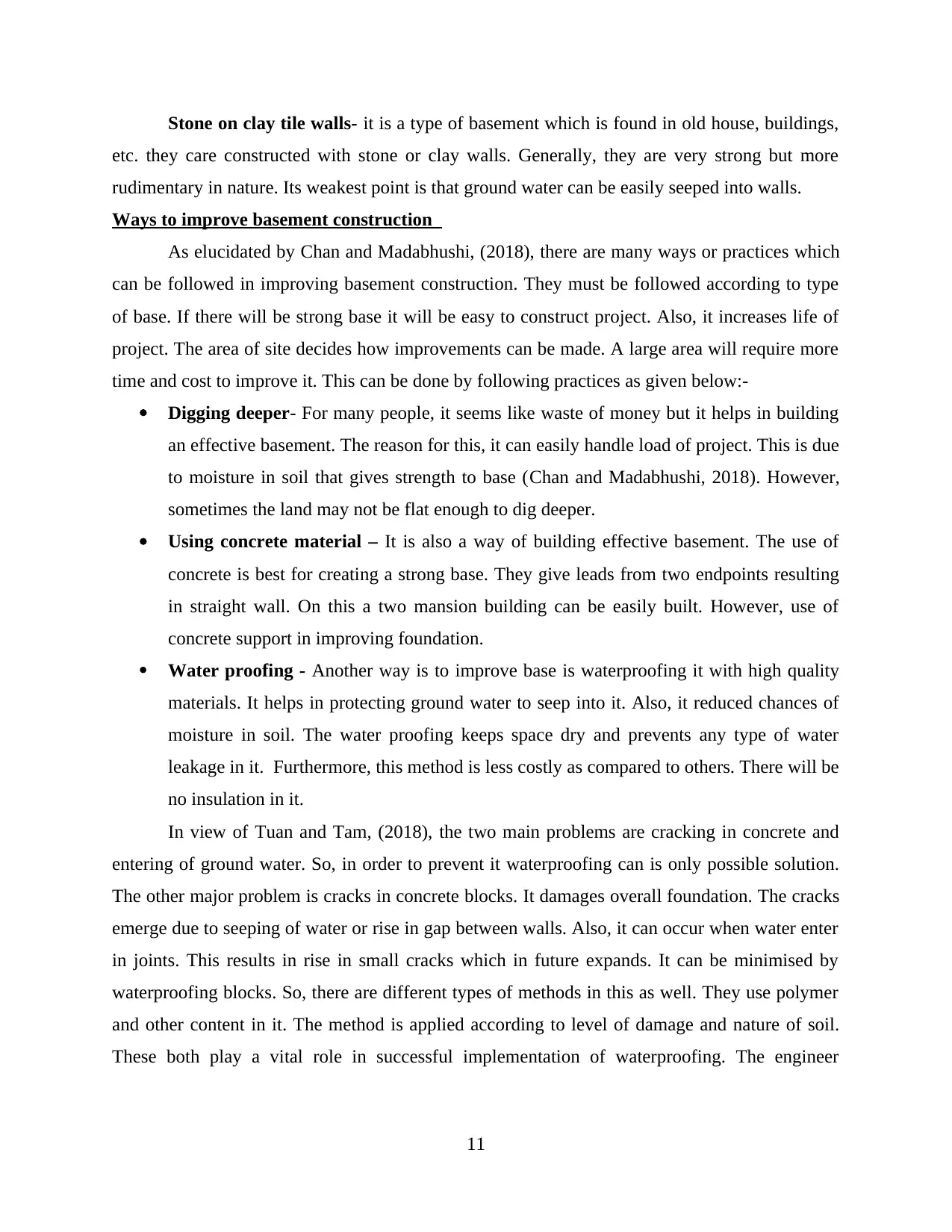
Stone on clay tile walls- it is a type of basement which is found in old house, buildings,
etc. they care constructed with stone or clay walls. Generally, they are very strong but more
rudimentary in nature. Its weakest point is that ground water can be easily seeped into walls.
Ways to improve basement construction
As elucidated by Chan and Madabhushi, (2018), there are many ways or practices which
can be followed in improving basement construction. They must be followed according to type
of base. If there will be strong base it will be easy to construct project. Also, it increases life of
project. The area of site decides how improvements can be made. A large area will require more
time and cost to improve it. This can be done by following practices as given below:-
Digging deeper- For many people, it seems like waste of money but it helps in building
an effective basement. The reason for this, it can easily handle load of project. This is due
to moisture in soil that gives strength to base (Chan and Madabhushi, 2018). However,
sometimes the land may not be flat enough to dig deeper.
Using concrete material – It is also a way of building effective basement. The use of
concrete is best for creating a strong base. They give leads from two endpoints resulting
in straight wall. On this a two mansion building can be easily built. However, use of
concrete support in improving foundation.
Water proofing - Another way is to improve base is waterproofing it with high quality
materials. It helps in protecting ground water to seep into it. Also, it reduced chances of
moisture in soil. The water proofing keeps space dry and prevents any type of water
leakage in it. Furthermore, this method is less costly as compared to others. There will be
no insulation in it.
In view of Tuan and Tam, (2018), the two main problems are cracking in concrete and
entering of ground water. So, in order to prevent it waterproofing can is only possible solution.
The other major problem is cracks in concrete blocks. It damages overall foundation. The cracks
emerge due to seeping of water or rise in gap between walls. Also, it can occur when water enter
in joints. This results in rise in small cracks which in future expands. It can be minimised by
waterproofing blocks. So, there are different types of methods in this as well. They use polymer
and other content in it. The method is applied according to level of damage and nature of soil.
These both play a vital role in successful implementation of waterproofing. The engineer
11
etc. they care constructed with stone or clay walls. Generally, they are very strong but more
rudimentary in nature. Its weakest point is that ground water can be easily seeped into walls.
Ways to improve basement construction
As elucidated by Chan and Madabhushi, (2018), there are many ways or practices which
can be followed in improving basement construction. They must be followed according to type
of base. If there will be strong base it will be easy to construct project. Also, it increases life of
project. The area of site decides how improvements can be made. A large area will require more
time and cost to improve it. This can be done by following practices as given below:-
Digging deeper- For many people, it seems like waste of money but it helps in building
an effective basement. The reason for this, it can easily handle load of project. This is due
to moisture in soil that gives strength to base (Chan and Madabhushi, 2018). However,
sometimes the land may not be flat enough to dig deeper.
Using concrete material – It is also a way of building effective basement. The use of
concrete is best for creating a strong base. They give leads from two endpoints resulting
in straight wall. On this a two mansion building can be easily built. However, use of
concrete support in improving foundation.
Water proofing - Another way is to improve base is waterproofing it with high quality
materials. It helps in protecting ground water to seep into it. Also, it reduced chances of
moisture in soil. The water proofing keeps space dry and prevents any type of water
leakage in it. Furthermore, this method is less costly as compared to others. There will be
no insulation in it.
In view of Tuan and Tam, (2018), the two main problems are cracking in concrete and
entering of ground water. So, in order to prevent it waterproofing can is only possible solution.
The other major problem is cracks in concrete blocks. It damages overall foundation. The cracks
emerge due to seeping of water or rise in gap between walls. Also, it can occur when water enter
in joints. This results in rise in small cracks which in future expands. It can be minimised by
waterproofing blocks. So, there are different types of methods in this as well. They use polymer
and other content in it. The method is applied according to level of damage and nature of soil.
These both play a vital role in successful implementation of waterproofing. The engineer
11
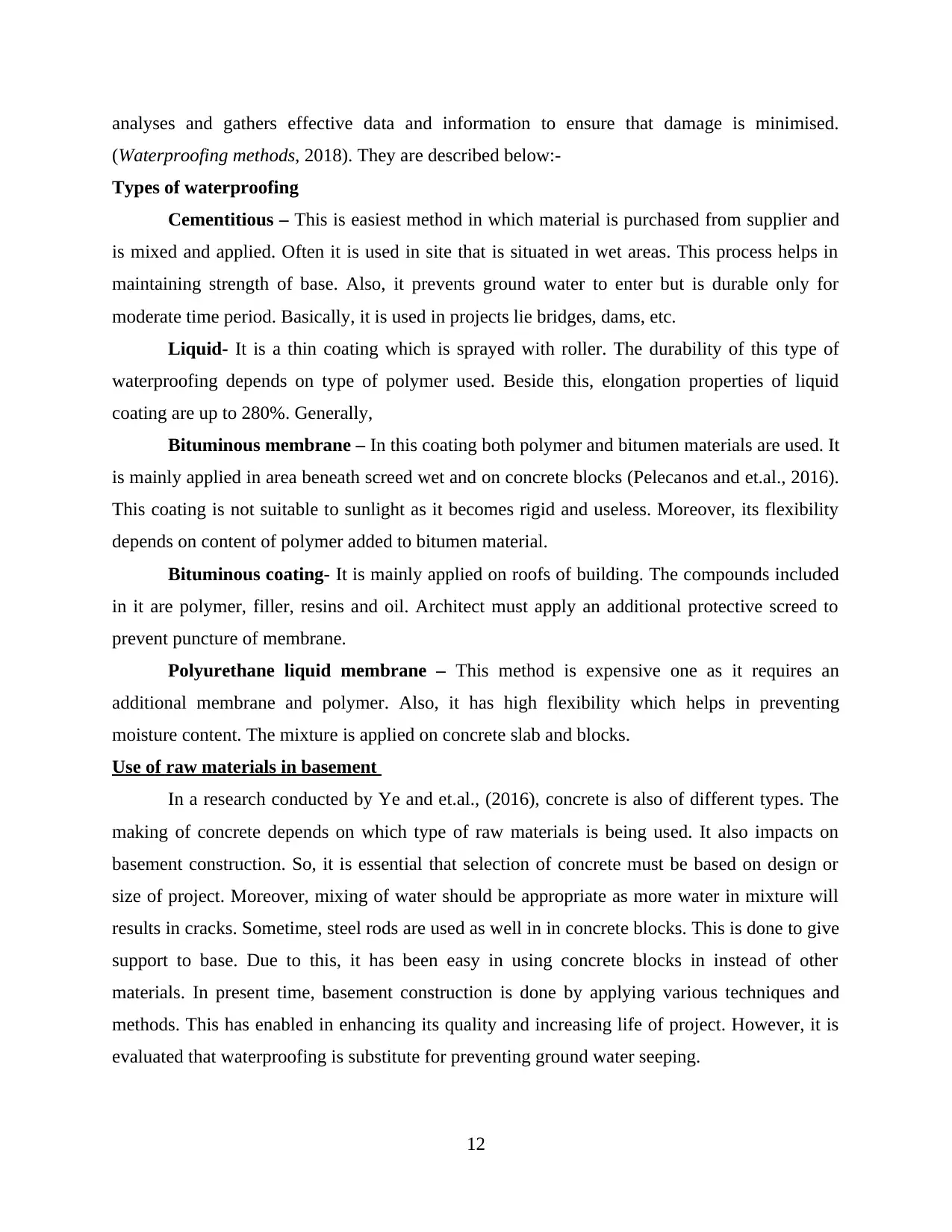
analyses and gathers effective data and information to ensure that damage is minimised.
(Waterproofing methods, 2018). They are described below:-
Types of waterproofing
Cementitious – This is easiest method in which material is purchased from supplier and
is mixed and applied. Often it is used in site that is situated in wet areas. This process helps in
maintaining strength of base. Also, it prevents ground water to enter but is durable only for
moderate time period. Basically, it is used in projects lie bridges, dams, etc.
Liquid- It is a thin coating which is sprayed with roller. The durability of this type of
waterproofing depends on type of polymer used. Beside this, elongation properties of liquid
coating are up to 280%. Generally,
Bituminous membrane – In this coating both polymer and bitumen materials are used. It
is mainly applied in area beneath screed wet and on concrete blocks (Pelecanos and et.al., 2016).
This coating is not suitable to sunlight as it becomes rigid and useless. Moreover, its flexibility
depends on content of polymer added to bitumen material.
Bituminous coating- It is mainly applied on roofs of building. The compounds included
in it are polymer, filler, resins and oil. Architect must apply an additional protective screed to
prevent puncture of membrane.
Polyurethane liquid membrane – This method is expensive one as it requires an
additional membrane and polymer. Also, it has high flexibility which helps in preventing
moisture content. The mixture is applied on concrete slab and blocks.
Use of raw materials in basement
In a research conducted by Ye and et.al., (2016), concrete is also of different types. The
making of concrete depends on which type of raw materials is being used. It also impacts on
basement construction. So, it is essential that selection of concrete must be based on design or
size of project. Moreover, mixing of water should be appropriate as more water in mixture will
results in cracks. Sometime, steel rods are used as well in in concrete blocks. This is done to give
support to base. Due to this, it has been easy in using concrete blocks in instead of other
materials. In present time, basement construction is done by applying various techniques and
methods. This has enabled in enhancing its quality and increasing life of project. However, it is
evaluated that waterproofing is substitute for preventing ground water seeping.
12
(Waterproofing methods, 2018). They are described below:-
Types of waterproofing
Cementitious – This is easiest method in which material is purchased from supplier and
is mixed and applied. Often it is used in site that is situated in wet areas. This process helps in
maintaining strength of base. Also, it prevents ground water to enter but is durable only for
moderate time period. Basically, it is used in projects lie bridges, dams, etc.
Liquid- It is a thin coating which is sprayed with roller. The durability of this type of
waterproofing depends on type of polymer used. Beside this, elongation properties of liquid
coating are up to 280%. Generally,
Bituminous membrane – In this coating both polymer and bitumen materials are used. It
is mainly applied in area beneath screed wet and on concrete blocks (Pelecanos and et.al., 2016).
This coating is not suitable to sunlight as it becomes rigid and useless. Moreover, its flexibility
depends on content of polymer added to bitumen material.
Bituminous coating- It is mainly applied on roofs of building. The compounds included
in it are polymer, filler, resins and oil. Architect must apply an additional protective screed to
prevent puncture of membrane.
Polyurethane liquid membrane – This method is expensive one as it requires an
additional membrane and polymer. Also, it has high flexibility which helps in preventing
moisture content. The mixture is applied on concrete slab and blocks.
Use of raw materials in basement
In a research conducted by Ye and et.al., (2016), concrete is also of different types. The
making of concrete depends on which type of raw materials is being used. It also impacts on
basement construction. So, it is essential that selection of concrete must be based on design or
size of project. Moreover, mixing of water should be appropriate as more water in mixture will
results in cracks. Sometime, steel rods are used as well in in concrete blocks. This is done to give
support to base. Due to this, it has been easy in using concrete blocks in instead of other
materials. In present time, basement construction is done by applying various techniques and
methods. This has enabled in enhancing its quality and increasing life of project. However, it is
evaluated that waterproofing is substitute for preventing ground water seeping.
12
Secure Best Marks with AI Grader
Need help grading? Try our AI Grader for instant feedback on your assignments.
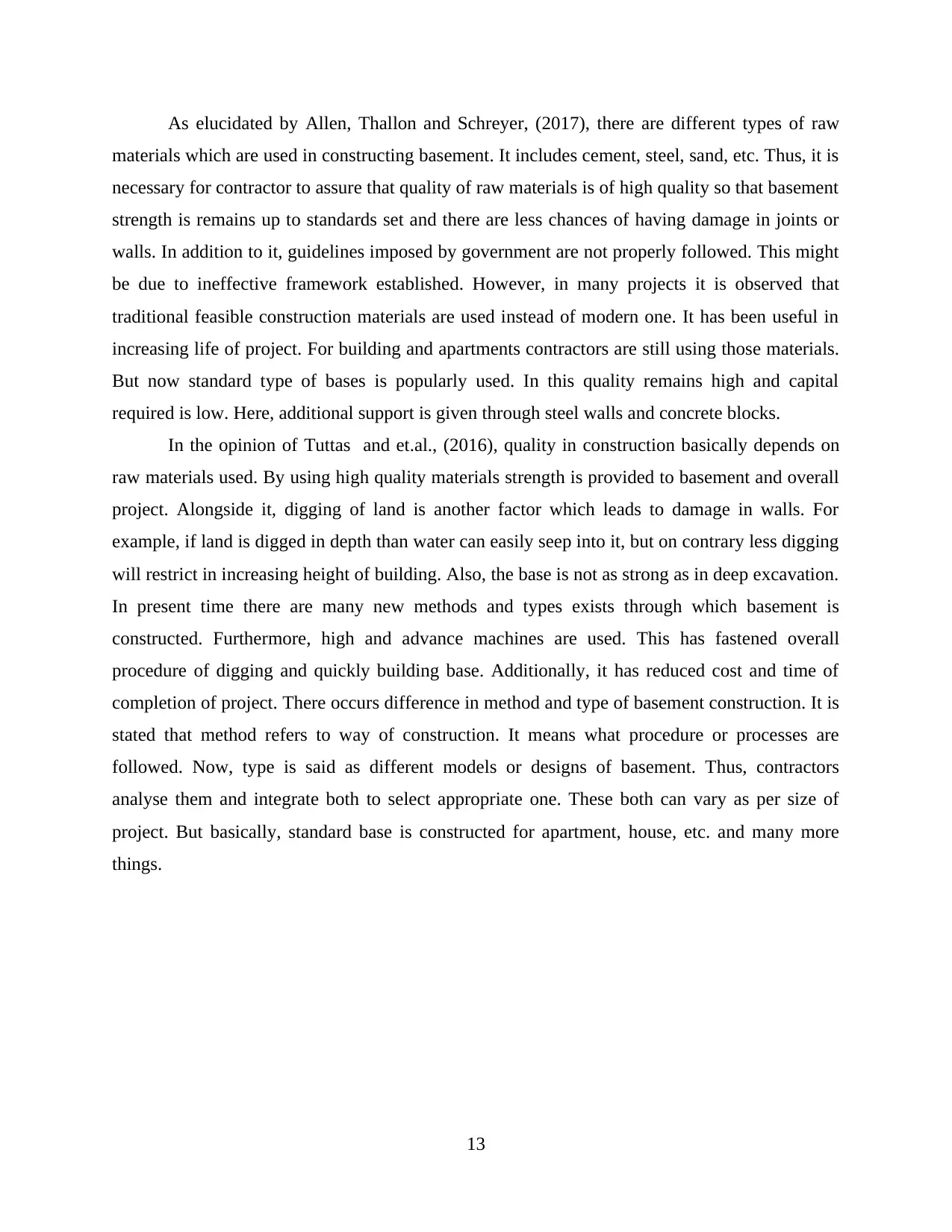
As elucidated by Allen, Thallon and Schreyer, (2017), there are different types of raw
materials which are used in constructing basement. It includes cement, steel, sand, etc. Thus, it is
necessary for contractor to assure that quality of raw materials is of high quality so that basement
strength is remains up to standards set and there are less chances of having damage in joints or
walls. In addition to it, guidelines imposed by government are not properly followed. This might
be due to ineffective framework established. However, in many projects it is observed that
traditional feasible construction materials are used instead of modern one. It has been useful in
increasing life of project. For building and apartments contractors are still using those materials.
But now standard type of bases is popularly used. In this quality remains high and capital
required is low. Here, additional support is given through steel walls and concrete blocks.
In the opinion of Tuttas and et.al., (2016), quality in construction basically depends on
raw materials used. By using high quality materials strength is provided to basement and overall
project. Alongside it, digging of land is another factor which leads to damage in walls. For
example, if land is digged in depth than water can easily seep into it, but on contrary less digging
will restrict in increasing height of building. Also, the base is not as strong as in deep excavation.
In present time there are many new methods and types exists through which basement is
constructed. Furthermore, high and advance machines are used. This has fastened overall
procedure of digging and quickly building base. Additionally, it has reduced cost and time of
completion of project. There occurs difference in method and type of basement construction. It is
stated that method refers to way of construction. It means what procedure or processes are
followed. Now, type is said as different models or designs of basement. Thus, contractors
analyse them and integrate both to select appropriate one. These both can vary as per size of
project. But basically, standard base is constructed for apartment, house, etc. and many more
things.
13
materials which are used in constructing basement. It includes cement, steel, sand, etc. Thus, it is
necessary for contractor to assure that quality of raw materials is of high quality so that basement
strength is remains up to standards set and there are less chances of having damage in joints or
walls. In addition to it, guidelines imposed by government are not properly followed. This might
be due to ineffective framework established. However, in many projects it is observed that
traditional feasible construction materials are used instead of modern one. It has been useful in
increasing life of project. For building and apartments contractors are still using those materials.
But now standard type of bases is popularly used. In this quality remains high and capital
required is low. Here, additional support is given through steel walls and concrete blocks.
In the opinion of Tuttas and et.al., (2016), quality in construction basically depends on
raw materials used. By using high quality materials strength is provided to basement and overall
project. Alongside it, digging of land is another factor which leads to damage in walls. For
example, if land is digged in depth than water can easily seep into it, but on contrary less digging
will restrict in increasing height of building. Also, the base is not as strong as in deep excavation.
In present time there are many new methods and types exists through which basement is
constructed. Furthermore, high and advance machines are used. This has fastened overall
procedure of digging and quickly building base. Additionally, it has reduced cost and time of
completion of project. There occurs difference in method and type of basement construction. It is
stated that method refers to way of construction. It means what procedure or processes are
followed. Now, type is said as different models or designs of basement. Thus, contractors
analyse them and integrate both to select appropriate one. These both can vary as per size of
project. But basically, standard base is constructed for apartment, house, etc. and many more
things.
13
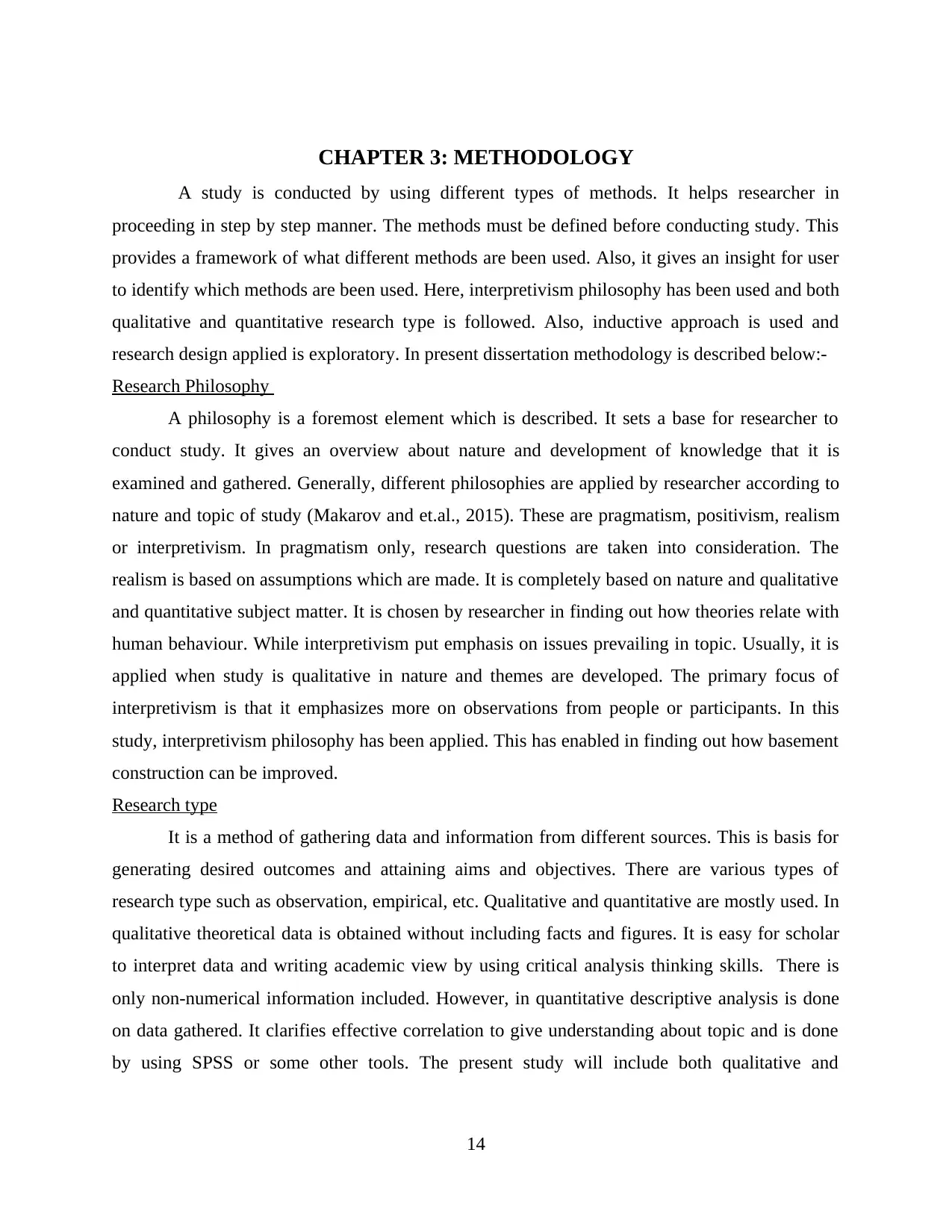
CHAPTER 3: METHODOLOGY
A study is conducted by using different types of methods. It helps researcher in
proceeding in step by step manner. The methods must be defined before conducting study. This
provides a framework of what different methods are been used. Also, it gives an insight for user
to identify which methods are been used. Here, interpretivism philosophy has been used and both
qualitative and quantitative research type is followed. Also, inductive approach is used and
research design applied is exploratory. In present dissertation methodology is described below:-
Research Philosophy
A philosophy is a foremost element which is described. It sets a base for researcher to
conduct study. It gives an overview about nature and development of knowledge that it is
examined and gathered. Generally, different philosophies are applied by researcher according to
nature and topic of study (Makarov and et.al., 2015). These are pragmatism, positivism, realism
or interpretivism. In pragmatism only, research questions are taken into consideration. The
realism is based on assumptions which are made. It is completely based on nature and qualitative
and quantitative subject matter. It is chosen by researcher in finding out how theories relate with
human behaviour. While interpretivism put emphasis on issues prevailing in topic. Usually, it is
applied when study is qualitative in nature and themes are developed. The primary focus of
interpretivism is that it emphasizes more on observations from people or participants. In this
study, interpretivism philosophy has been applied. This has enabled in finding out how basement
construction can be improved.
Research type
It is a method of gathering data and information from different sources. This is basis for
generating desired outcomes and attaining aims and objectives. There are various types of
research type such as observation, empirical, etc. Qualitative and quantitative are mostly used. In
qualitative theoretical data is obtained without including facts and figures. It is easy for scholar
to interpret data and writing academic view by using critical analysis thinking skills. There is
only non-numerical information included. However, in quantitative descriptive analysis is done
on data gathered. It clarifies effective correlation to give understanding about topic and is done
by using SPSS or some other tools. The present study will include both qualitative and
14
A study is conducted by using different types of methods. It helps researcher in
proceeding in step by step manner. The methods must be defined before conducting study. This
provides a framework of what different methods are been used. Also, it gives an insight for user
to identify which methods are been used. Here, interpretivism philosophy has been used and both
qualitative and quantitative research type is followed. Also, inductive approach is used and
research design applied is exploratory. In present dissertation methodology is described below:-
Research Philosophy
A philosophy is a foremost element which is described. It sets a base for researcher to
conduct study. It gives an overview about nature and development of knowledge that it is
examined and gathered. Generally, different philosophies are applied by researcher according to
nature and topic of study (Makarov and et.al., 2015). These are pragmatism, positivism, realism
or interpretivism. In pragmatism only, research questions are taken into consideration. The
realism is based on assumptions which are made. It is completely based on nature and qualitative
and quantitative subject matter. It is chosen by researcher in finding out how theories relate with
human behaviour. While interpretivism put emphasis on issues prevailing in topic. Usually, it is
applied when study is qualitative in nature and themes are developed. The primary focus of
interpretivism is that it emphasizes more on observations from people or participants. In this
study, interpretivism philosophy has been applied. This has enabled in finding out how basement
construction can be improved.
Research type
It is a method of gathering data and information from different sources. This is basis for
generating desired outcomes and attaining aims and objectives. There are various types of
research type such as observation, empirical, etc. Qualitative and quantitative are mostly used. In
qualitative theoretical data is obtained without including facts and figures. It is easy for scholar
to interpret data and writing academic view by using critical analysis thinking skills. There is
only non-numerical information included. However, in quantitative descriptive analysis is done
on data gathered. It clarifies effective correlation to give understanding about topic and is done
by using SPSS or some other tools. The present study will include both qualitative and
14
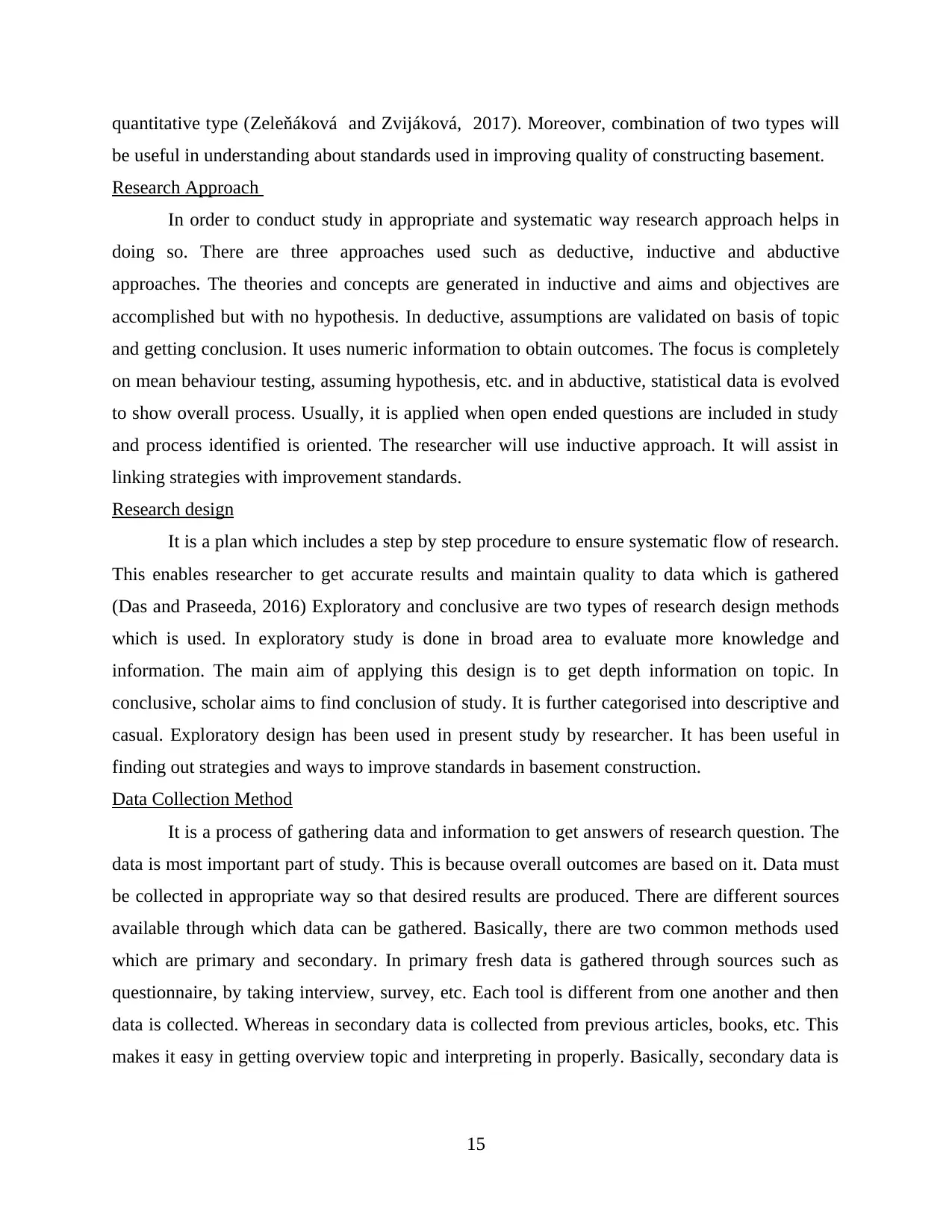
quantitative type (Zeleňáková and Zvijáková, 2017). Moreover, combination of two types will
be useful in understanding about standards used in improving quality of constructing basement.
Research Approach
In order to conduct study in appropriate and systematic way research approach helps in
doing so. There are three approaches used such as deductive, inductive and abductive
approaches. The theories and concepts are generated in inductive and aims and objectives are
accomplished but with no hypothesis. In deductive, assumptions are validated on basis of topic
and getting conclusion. It uses numeric information to obtain outcomes. The focus is completely
on mean behaviour testing, assuming hypothesis, etc. and in abductive, statistical data is evolved
to show overall process. Usually, it is applied when open ended questions are included in study
and process identified is oriented. The researcher will use inductive approach. It will assist in
linking strategies with improvement standards.
Research design
It is a plan which includes a step by step procedure to ensure systematic flow of research.
This enables researcher to get accurate results and maintain quality to data which is gathered
(Das and Praseeda, 2016) Exploratory and conclusive are two types of research design methods
which is used. In exploratory study is done in broad area to evaluate more knowledge and
information. The main aim of applying this design is to get depth information on topic. In
conclusive, scholar aims to find conclusion of study. It is further categorised into descriptive and
casual. Exploratory design has been used in present study by researcher. It has been useful in
finding out strategies and ways to improve standards in basement construction.
Data Collection Method
It is a process of gathering data and information to get answers of research question. The
data is most important part of study. This is because overall outcomes are based on it. Data must
be collected in appropriate way so that desired results are produced. There are different sources
available through which data can be gathered. Basically, there are two common methods used
which are primary and secondary. In primary fresh data is gathered through sources such as
questionnaire, by taking interview, survey, etc. Each tool is different from one another and then
data is collected. Whereas in secondary data is collected from previous articles, books, etc. This
makes it easy in getting overview topic and interpreting in properly. Basically, secondary data is
15
be useful in understanding about standards used in improving quality of constructing basement.
Research Approach
In order to conduct study in appropriate and systematic way research approach helps in
doing so. There are three approaches used such as deductive, inductive and abductive
approaches. The theories and concepts are generated in inductive and aims and objectives are
accomplished but with no hypothesis. In deductive, assumptions are validated on basis of topic
and getting conclusion. It uses numeric information to obtain outcomes. The focus is completely
on mean behaviour testing, assuming hypothesis, etc. and in abductive, statistical data is evolved
to show overall process. Usually, it is applied when open ended questions are included in study
and process identified is oriented. The researcher will use inductive approach. It will assist in
linking strategies with improvement standards.
Research design
It is a plan which includes a step by step procedure to ensure systematic flow of research.
This enables researcher to get accurate results and maintain quality to data which is gathered
(Das and Praseeda, 2016) Exploratory and conclusive are two types of research design methods
which is used. In exploratory study is done in broad area to evaluate more knowledge and
information. The main aim of applying this design is to get depth information on topic. In
conclusive, scholar aims to find conclusion of study. It is further categorised into descriptive and
casual. Exploratory design has been used in present study by researcher. It has been useful in
finding out strategies and ways to improve standards in basement construction.
Data Collection Method
It is a process of gathering data and information to get answers of research question. The
data is most important part of study. This is because overall outcomes are based on it. Data must
be collected in appropriate way so that desired results are produced. There are different sources
available through which data can be gathered. Basically, there are two common methods used
which are primary and secondary. In primary fresh data is gathered through sources such as
questionnaire, by taking interview, survey, etc. Each tool is different from one another and then
data is collected. Whereas in secondary data is collected from previous articles, books, etc. This
makes it easy in getting overview topic and interpreting in properly. Basically, secondary data is
15
Paraphrase This Document
Need a fresh take? Get an instant paraphrase of this document with our AI Paraphraser
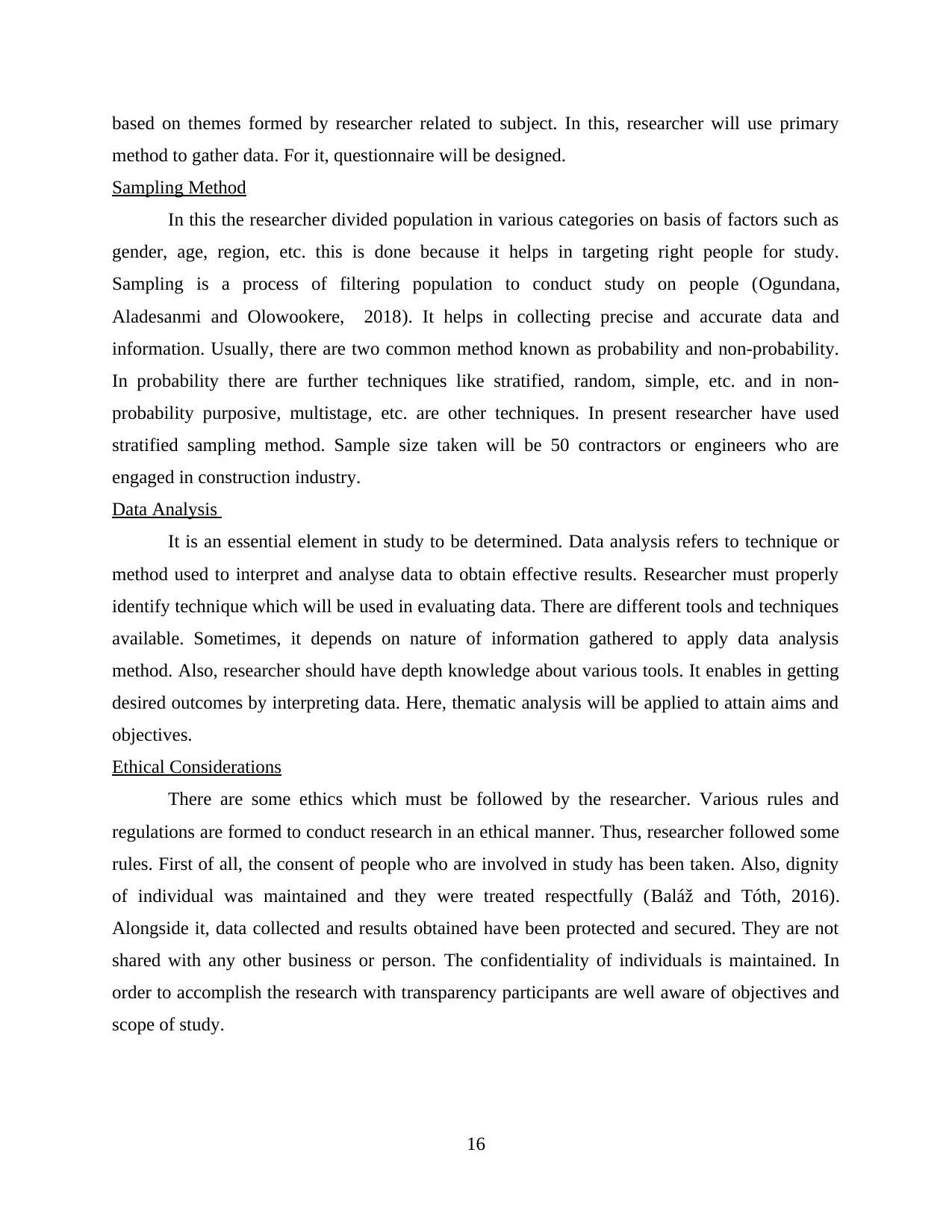
based on themes formed by researcher related to subject. In this, researcher will use primary
method to gather data. For it, questionnaire will be designed.
Sampling Method
In this the researcher divided population in various categories on basis of factors such as
gender, age, region, etc. this is done because it helps in targeting right people for study.
Sampling is a process of filtering population to conduct study on people (Ogundana,
Aladesanmi and Olowookere, 2018). It helps in collecting precise and accurate data and
information. Usually, there are two common method known as probability and non-probability.
In probability there are further techniques like stratified, random, simple, etc. and in non-
probability purposive, multistage, etc. are other techniques. In present researcher have used
stratified sampling method. Sample size taken will be 50 contractors or engineers who are
engaged in construction industry.
Data Analysis
It is an essential element in study to be determined. Data analysis refers to technique or
method used to interpret and analyse data to obtain effective results. Researcher must properly
identify technique which will be used in evaluating data. There are different tools and techniques
available. Sometimes, it depends on nature of information gathered to apply data analysis
method. Also, researcher should have depth knowledge about various tools. It enables in getting
desired outcomes by interpreting data. Here, thematic analysis will be applied to attain aims and
objectives.
Ethical Considerations
There are some ethics which must be followed by the researcher. Various rules and
regulations are formed to conduct research in an ethical manner. Thus, researcher followed some
rules. First of all, the consent of people who are involved in study has been taken. Also, dignity
of individual was maintained and they were treated respectfully (Baláž and Tóth, 2016).
Alongside it, data collected and results obtained have been protected and secured. They are not
shared with any other business or person. The confidentiality of individuals is maintained. In
order to accomplish the research with transparency participants are well aware of objectives and
scope of study.
16
method to gather data. For it, questionnaire will be designed.
Sampling Method
In this the researcher divided population in various categories on basis of factors such as
gender, age, region, etc. this is done because it helps in targeting right people for study.
Sampling is a process of filtering population to conduct study on people (Ogundana,
Aladesanmi and Olowookere, 2018). It helps in collecting precise and accurate data and
information. Usually, there are two common method known as probability and non-probability.
In probability there are further techniques like stratified, random, simple, etc. and in non-
probability purposive, multistage, etc. are other techniques. In present researcher have used
stratified sampling method. Sample size taken will be 50 contractors or engineers who are
engaged in construction industry.
Data Analysis
It is an essential element in study to be determined. Data analysis refers to technique or
method used to interpret and analyse data to obtain effective results. Researcher must properly
identify technique which will be used in evaluating data. There are different tools and techniques
available. Sometimes, it depends on nature of information gathered to apply data analysis
method. Also, researcher should have depth knowledge about various tools. It enables in getting
desired outcomes by interpreting data. Here, thematic analysis will be applied to attain aims and
objectives.
Ethical Considerations
There are some ethics which must be followed by the researcher. Various rules and
regulations are formed to conduct research in an ethical manner. Thus, researcher followed some
rules. First of all, the consent of people who are involved in study has been taken. Also, dignity
of individual was maintained and they were treated respectfully (Baláž and Tóth, 2016).
Alongside it, data collected and results obtained have been protected and secured. They are not
shared with any other business or person. The confidentiality of individuals is maintained. In
order to accomplish the research with transparency participants are well aware of objectives and
scope of study.
16
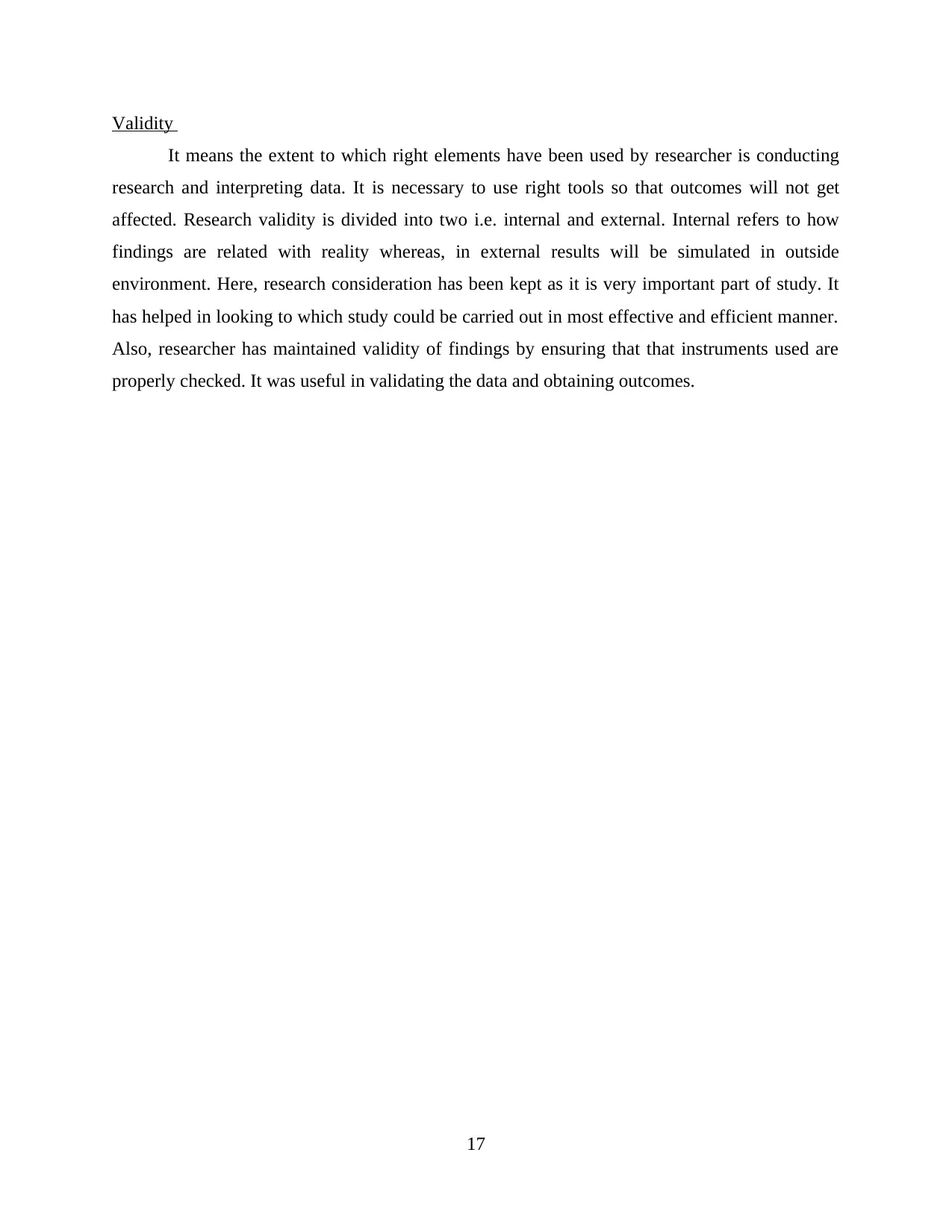
Validity
It means the extent to which right elements have been used by researcher is conducting
research and interpreting data. It is necessary to use right tools so that outcomes will not get
affected. Research validity is divided into two i.e. internal and external. Internal refers to how
findings are related with reality whereas, in external results will be simulated in outside
environment. Here, research consideration has been kept as it is very important part of study. It
has helped in looking to which study could be carried out in most effective and efficient manner.
Also, researcher has maintained validity of findings by ensuring that that instruments used are
properly checked. It was useful in validating the data and obtaining outcomes.
17
It means the extent to which right elements have been used by researcher is conducting
research and interpreting data. It is necessary to use right tools so that outcomes will not get
affected. Research validity is divided into two i.e. internal and external. Internal refers to how
findings are related with reality whereas, in external results will be simulated in outside
environment. Here, research consideration has been kept as it is very important part of study. It
has helped in looking to which study could be carried out in most effective and efficient manner.
Also, researcher has maintained validity of findings by ensuring that that instruments used are
properly checked. It was useful in validating the data and obtaining outcomes.
17
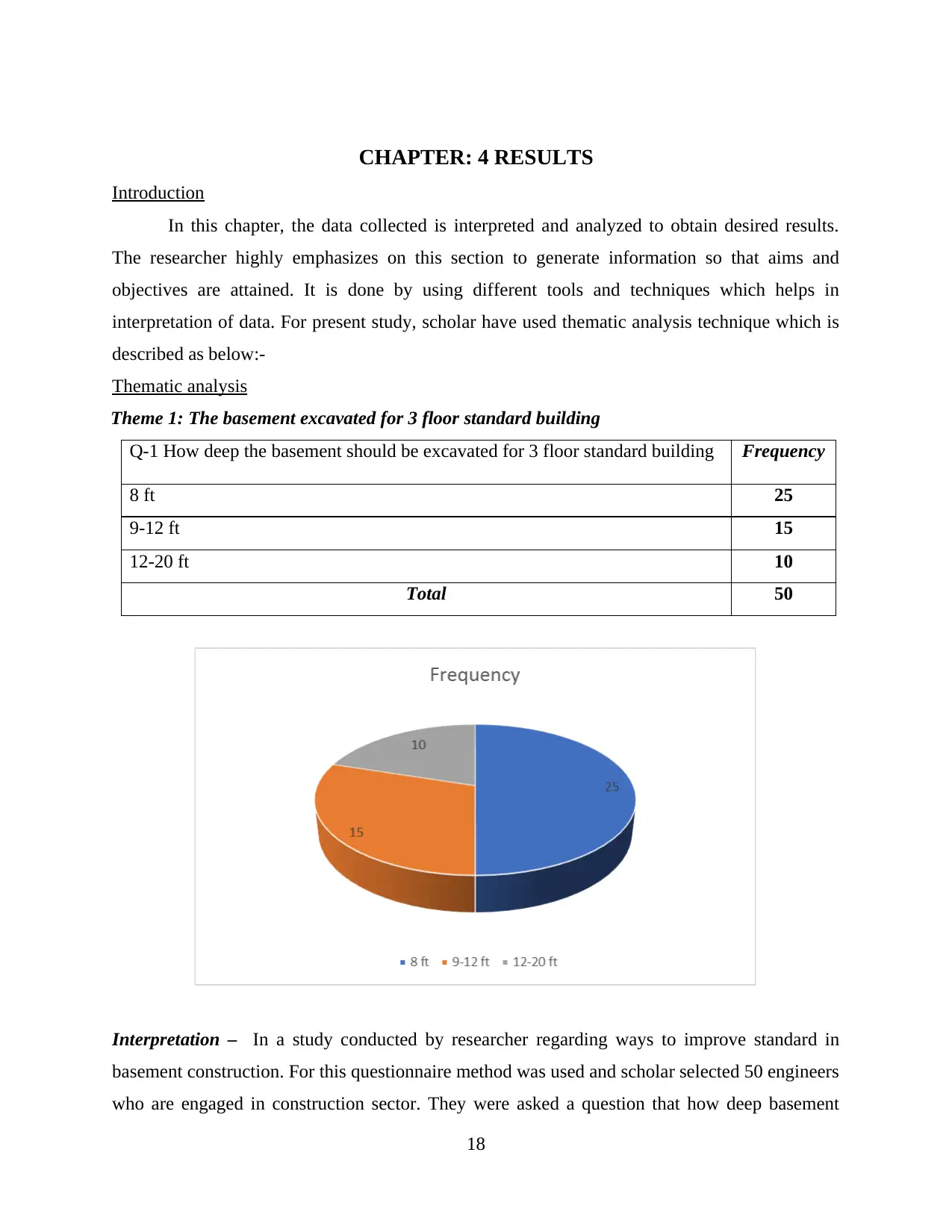
CHAPTER: 4 RESULTS
Introduction
In this chapter, the data collected is interpreted and analyzed to obtain desired results.
The researcher highly emphasizes on this section to generate information so that aims and
objectives are attained. It is done by using different tools and techniques which helps in
interpretation of data. For present study, scholar have used thematic analysis technique which is
described as below:-
Thematic analysis
Theme 1: The basement excavated for 3 floor standard building
Q-1 How deep the basement should be excavated for 3 floor standard building Frequency
8 ft 25
9-12 ft 15
12-20 ft 10
Total 50
Interpretation – In a study conducted by researcher regarding ways to improve standard in
basement construction. For this questionnaire method was used and scholar selected 50 engineers
who are engaged in construction sector. They were asked a question that how deep basement
18
Introduction
In this chapter, the data collected is interpreted and analyzed to obtain desired results.
The researcher highly emphasizes on this section to generate information so that aims and
objectives are attained. It is done by using different tools and techniques which helps in
interpretation of data. For present study, scholar have used thematic analysis technique which is
described as below:-
Thematic analysis
Theme 1: The basement excavated for 3 floor standard building
Q-1 How deep the basement should be excavated for 3 floor standard building Frequency
8 ft 25
9-12 ft 15
12-20 ft 10
Total 50
Interpretation – In a study conducted by researcher regarding ways to improve standard in
basement construction. For this questionnaire method was used and scholar selected 50 engineers
who are engaged in construction sector. They were asked a question that how deep basement
18
Secure Best Marks with AI Grader
Need help grading? Try our AI Grader for instant feedback on your assignments.
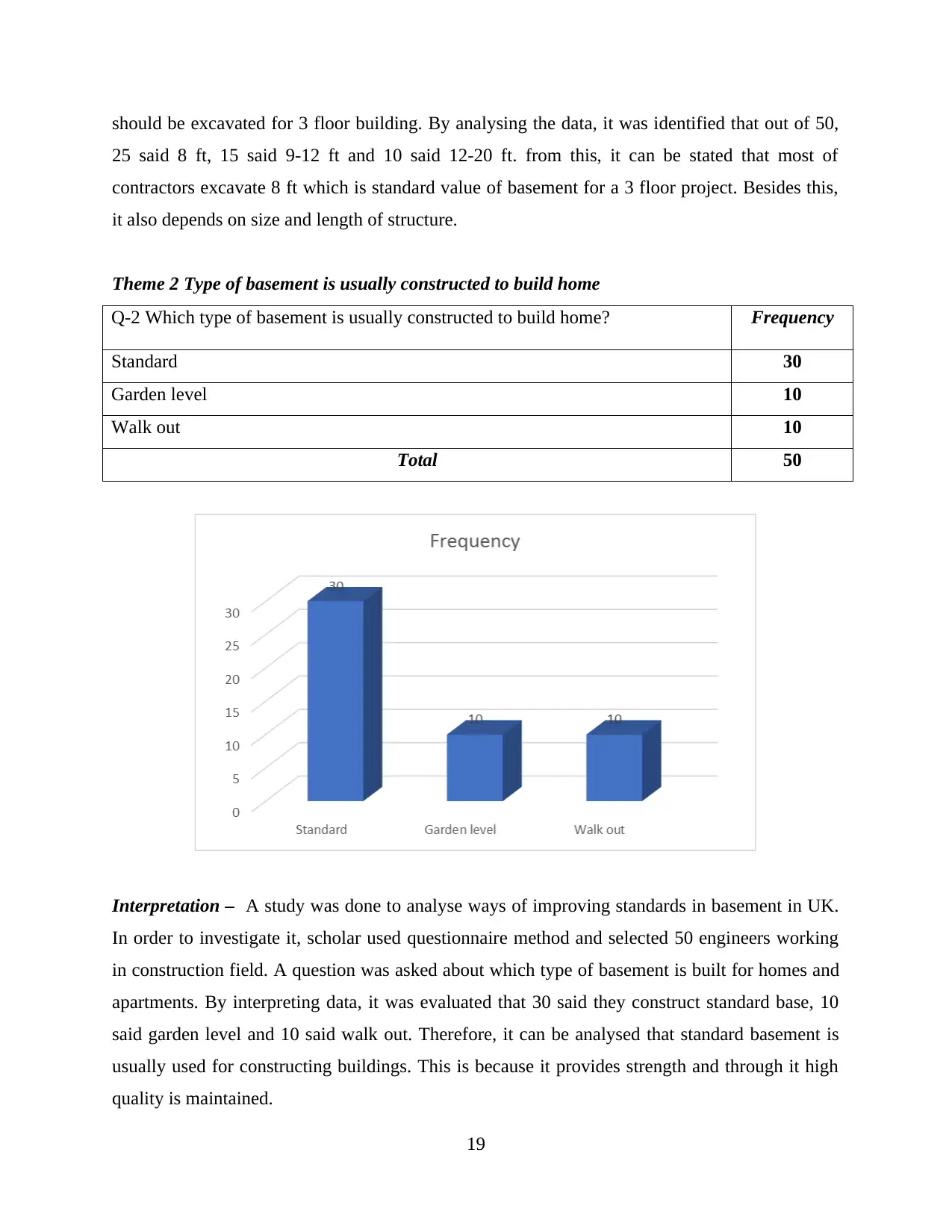
should be excavated for 3 floor building. By analysing the data, it was identified that out of 50,
25 said 8 ft, 15 said 9-12 ft and 10 said 12-20 ft. from this, it can be stated that most of
contractors excavate 8 ft which is standard value of basement for a 3 floor project. Besides this,
it also depends on size and length of structure.
Theme 2 Type of basement is usually constructed to build home
Q-2 Which type of basement is usually constructed to build home? Frequency
Standard 30
Garden level 10
Walk out 10
Total 50
Interpretation – A study was done to analyse ways of improving standards in basement in UK.
In order to investigate it, scholar used questionnaire method and selected 50 engineers working
in construction field. A question was asked about which type of basement is built for homes and
apartments. By interpreting data, it was evaluated that 30 said they construct standard base, 10
said garden level and 10 said walk out. Therefore, it can be analysed that standard basement is
usually used for constructing buildings. This is because it provides strength and through it high
quality is maintained.
19
25 said 8 ft, 15 said 9-12 ft and 10 said 12-20 ft. from this, it can be stated that most of
contractors excavate 8 ft which is standard value of basement for a 3 floor project. Besides this,
it also depends on size and length of structure.
Theme 2 Type of basement is usually constructed to build home
Q-2 Which type of basement is usually constructed to build home? Frequency
Standard 30
Garden level 10
Walk out 10
Total 50
Interpretation – A study was done to analyse ways of improving standards in basement in UK.
In order to investigate it, scholar used questionnaire method and selected 50 engineers working
in construction field. A question was asked about which type of basement is built for homes and
apartments. By interpreting data, it was evaluated that 30 said they construct standard base, 10
said garden level and 10 said walk out. Therefore, it can be analysed that standard basement is
usually used for constructing buildings. This is because it provides strength and through it high
quality is maintained.
19
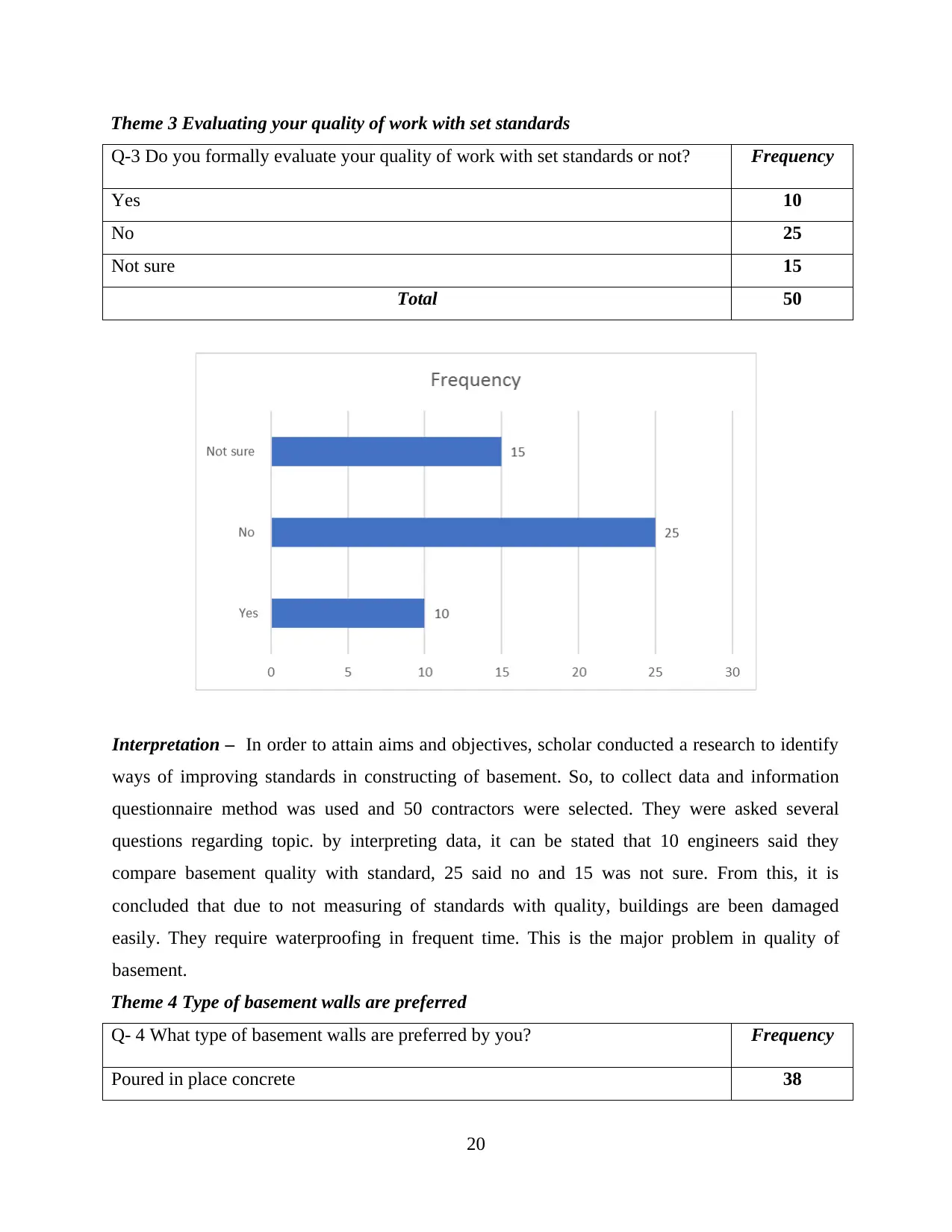
Theme 3 Evaluating your quality of work with set standards
Q-3 Do you formally evaluate your quality of work with set standards or not? Frequency
Yes 10
No 25
Not sure 15
Total 50
Interpretation – In order to attain aims and objectives, scholar conducted a research to identify
ways of improving standards in constructing of basement. So, to collect data and information
questionnaire method was used and 50 contractors were selected. They were asked several
questions regarding topic. by interpreting data, it can be stated that 10 engineers said they
compare basement quality with standard, 25 said no and 15 was not sure. From this, it is
concluded that due to not measuring of standards with quality, buildings are been damaged
easily. They require waterproofing in frequent time. This is the major problem in quality of
basement.
Theme 4 Type of basement walls are preferred
Q- 4 What type of basement walls are preferred by you? Frequency
Poured in place concrete 38
20
Q-3 Do you formally evaluate your quality of work with set standards or not? Frequency
Yes 10
No 25
Not sure 15
Total 50
Interpretation – In order to attain aims and objectives, scholar conducted a research to identify
ways of improving standards in constructing of basement. So, to collect data and information
questionnaire method was used and 50 contractors were selected. They were asked several
questions regarding topic. by interpreting data, it can be stated that 10 engineers said they
compare basement quality with standard, 25 said no and 15 was not sure. From this, it is
concluded that due to not measuring of standards with quality, buildings are been damaged
easily. They require waterproofing in frequent time. This is the major problem in quality of
basement.
Theme 4 Type of basement walls are preferred
Q- 4 What type of basement walls are preferred by you? Frequency
Poured in place concrete 38
20
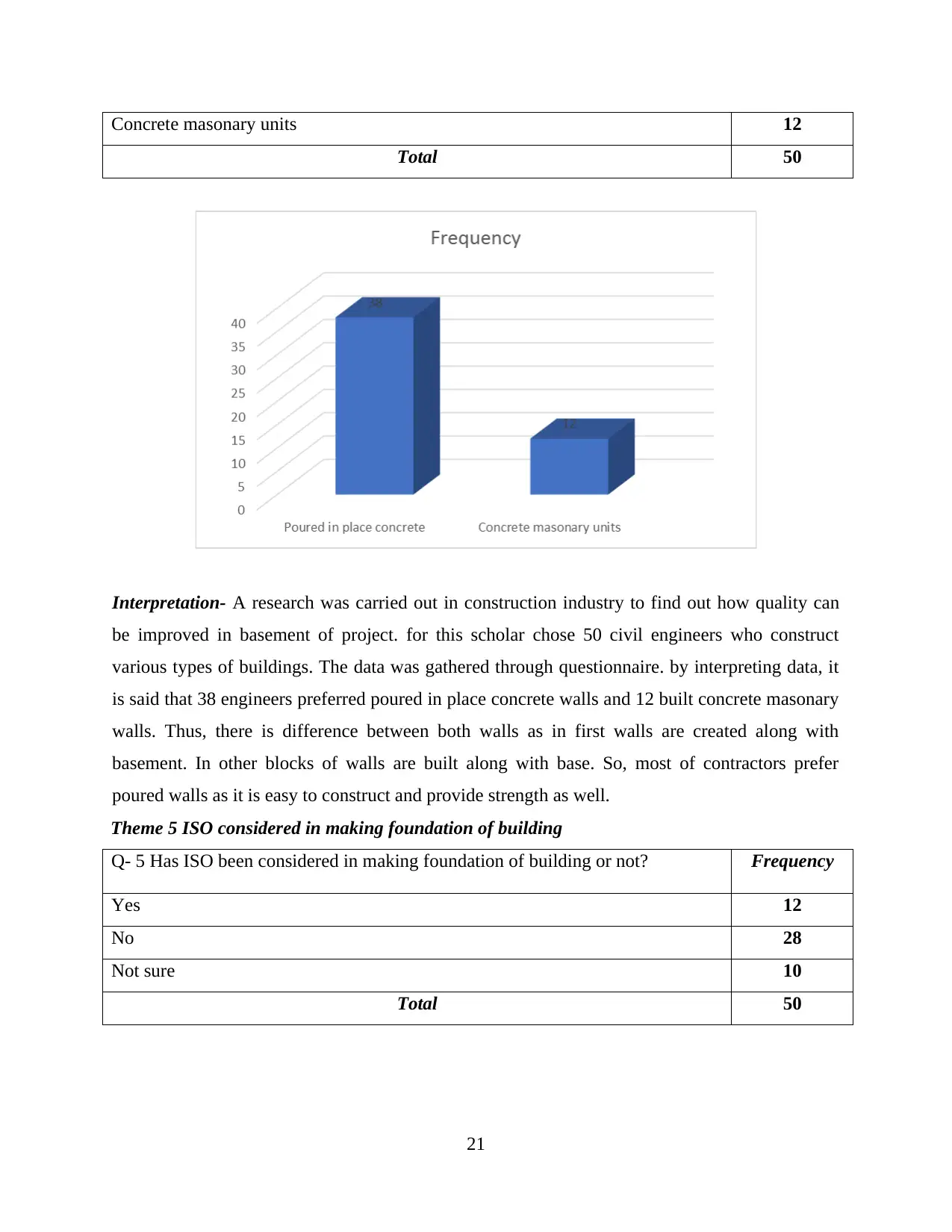
Concrete masonary units 12
Total 50
Interpretation- A research was carried out in construction industry to find out how quality can
be improved in basement of project. for this scholar chose 50 civil engineers who construct
various types of buildings. The data was gathered through questionnaire. by interpreting data, it
is said that 38 engineers preferred poured in place concrete walls and 12 built concrete masonary
walls. Thus, there is difference between both walls as in first walls are created along with
basement. In other blocks of walls are built along with base. So, most of contractors prefer
poured walls as it is easy to construct and provide strength as well.
Theme 5 ISO considered in making foundation of building
Q- 5 Has ISO been considered in making foundation of building or not? Frequency
Yes 12
No 28
Not sure 10
Total 50
21
Total 50
Interpretation- A research was carried out in construction industry to find out how quality can
be improved in basement of project. for this scholar chose 50 civil engineers who construct
various types of buildings. The data was gathered through questionnaire. by interpreting data, it
is said that 38 engineers preferred poured in place concrete walls and 12 built concrete masonary
walls. Thus, there is difference between both walls as in first walls are created along with
basement. In other blocks of walls are built along with base. So, most of contractors prefer
poured walls as it is easy to construct and provide strength as well.
Theme 5 ISO considered in making foundation of building
Q- 5 Has ISO been considered in making foundation of building or not? Frequency
Yes 12
No 28
Not sure 10
Total 50
21
Paraphrase This Document
Need a fresh take? Get an instant paraphrase of this document with our AI Paraphraser
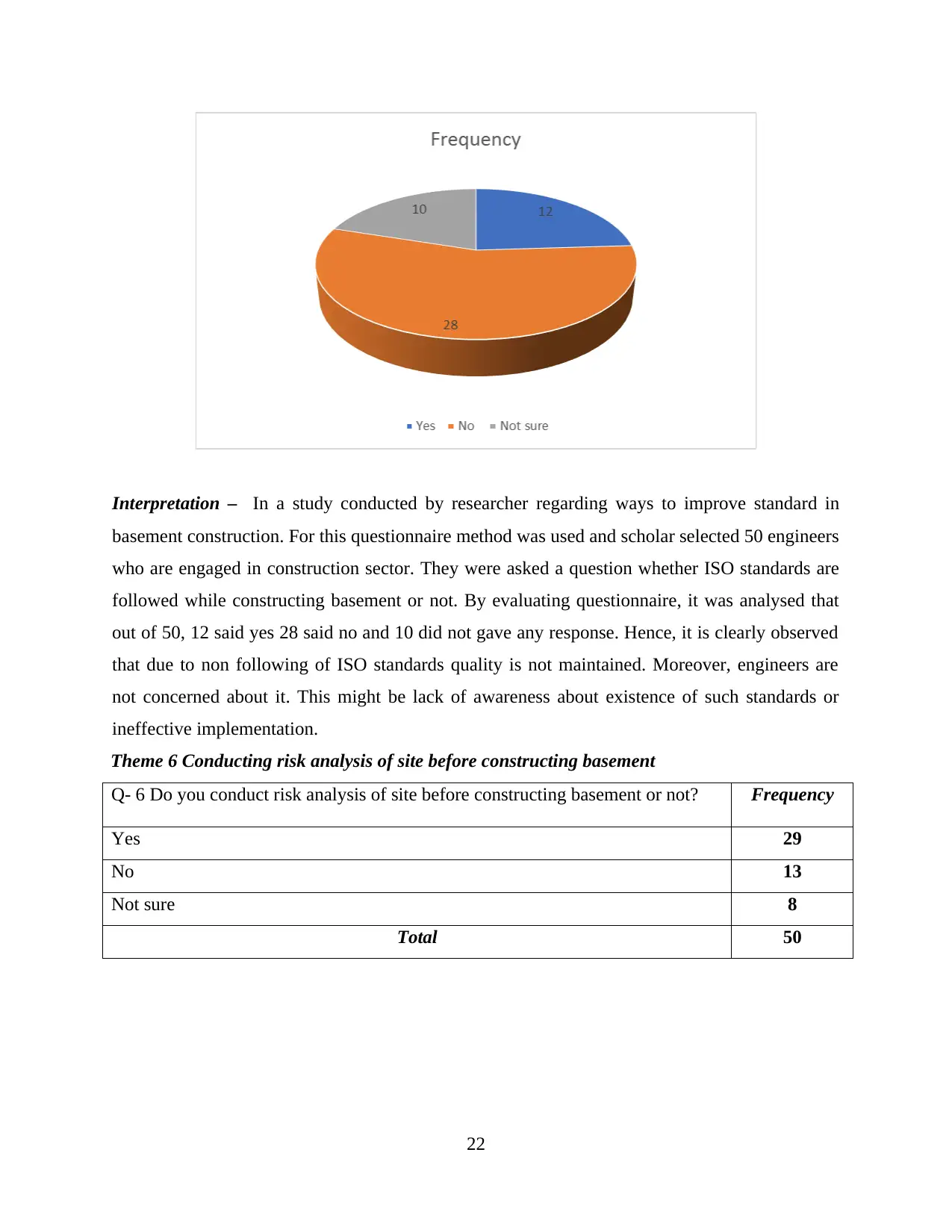
Interpretation – In a study conducted by researcher regarding ways to improve standard in
basement construction. For this questionnaire method was used and scholar selected 50 engineers
who are engaged in construction sector. They were asked a question whether ISO standards are
followed while constructing basement or not. By evaluating questionnaire, it was analysed that
out of 50, 12 said yes 28 said no and 10 did not gave any response. Hence, it is clearly observed
that due to non following of ISO standards quality is not maintained. Moreover, engineers are
not concerned about it. This might be lack of awareness about existence of such standards or
ineffective implementation.
Theme 6 Conducting risk analysis of site before constructing basement
Q- 6 Do you conduct risk analysis of site before constructing basement or not? Frequency
Yes 29
No 13
Not sure 8
Total 50
22
basement construction. For this questionnaire method was used and scholar selected 50 engineers
who are engaged in construction sector. They were asked a question whether ISO standards are
followed while constructing basement or not. By evaluating questionnaire, it was analysed that
out of 50, 12 said yes 28 said no and 10 did not gave any response. Hence, it is clearly observed
that due to non following of ISO standards quality is not maintained. Moreover, engineers are
not concerned about it. This might be lack of awareness about existence of such standards or
ineffective implementation.
Theme 6 Conducting risk analysis of site before constructing basement
Q- 6 Do you conduct risk analysis of site before constructing basement or not? Frequency
Yes 29
No 13
Not sure 8
Total 50
22
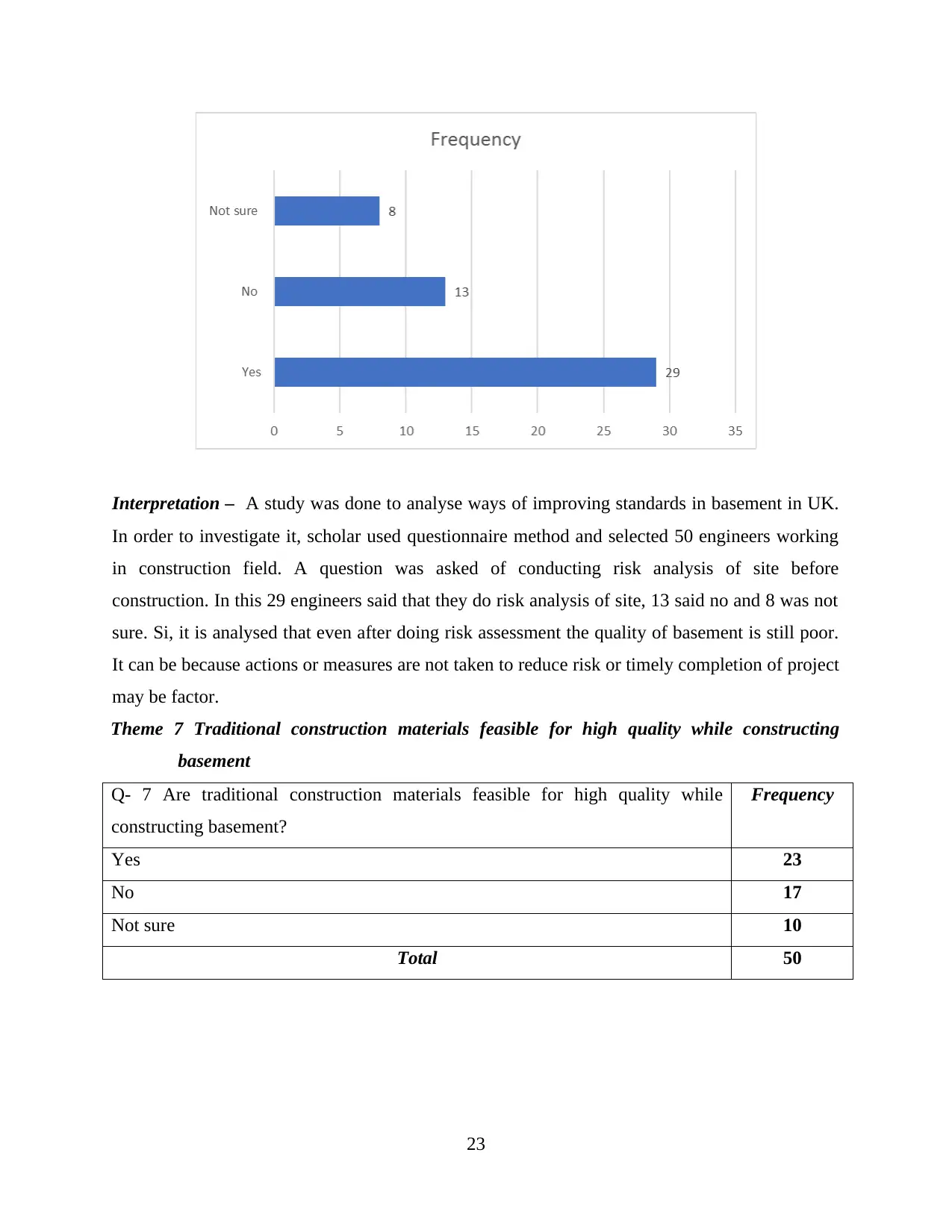
Interpretation – A study was done to analyse ways of improving standards in basement in UK.
In order to investigate it, scholar used questionnaire method and selected 50 engineers working
in construction field. A question was asked of conducting risk analysis of site before
construction. In this 29 engineers said that they do risk analysis of site, 13 said no and 8 was not
sure. Si, it is analysed that even after doing risk assessment the quality of basement is still poor.
It can be because actions or measures are not taken to reduce risk or timely completion of project
may be factor.
Theme 7 Traditional construction materials feasible for high quality while constructing
basement
Q- 7 Are traditional construction materials feasible for high quality while
constructing basement?
Frequency
Yes 23
No 17
Not sure 10
Total 50
23
In order to investigate it, scholar used questionnaire method and selected 50 engineers working
in construction field. A question was asked of conducting risk analysis of site before
construction. In this 29 engineers said that they do risk analysis of site, 13 said no and 8 was not
sure. Si, it is analysed that even after doing risk assessment the quality of basement is still poor.
It can be because actions or measures are not taken to reduce risk or timely completion of project
may be factor.
Theme 7 Traditional construction materials feasible for high quality while constructing
basement
Q- 7 Are traditional construction materials feasible for high quality while
constructing basement?
Frequency
Yes 23
No 17
Not sure 10
Total 50
23
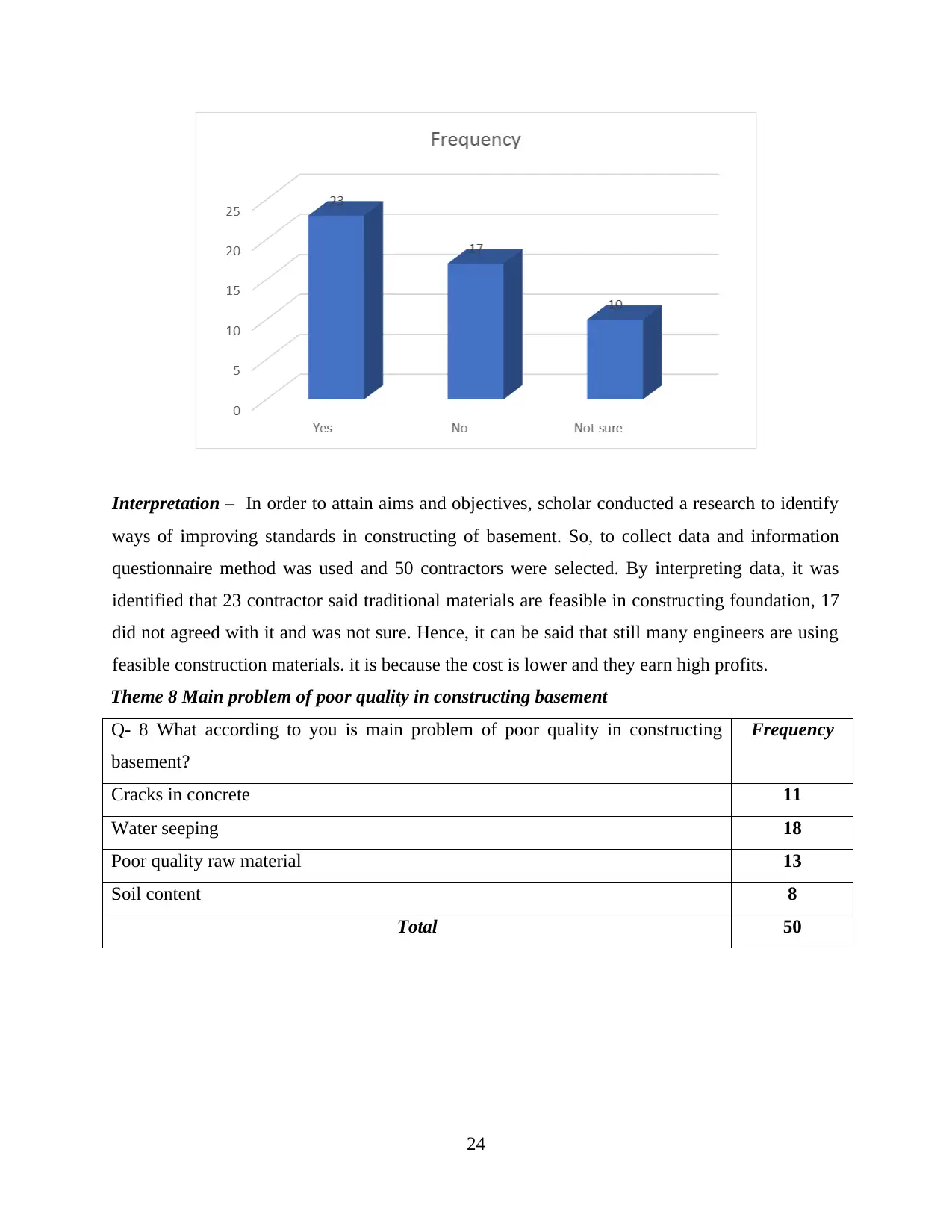
Interpretation – In order to attain aims and objectives, scholar conducted a research to identify
ways of improving standards in constructing of basement. So, to collect data and information
questionnaire method was used and 50 contractors were selected. By interpreting data, it was
identified that 23 contractor said traditional materials are feasible in constructing foundation, 17
did not agreed with it and was not sure. Hence, it can be said that still many engineers are using
feasible construction materials. it is because the cost is lower and they earn high profits.
Theme 8 Main problem of poor quality in constructing basement
Q- 8 What according to you is main problem of poor quality in constructing
basement?
Frequency
Cracks in concrete 11
Water seeping 18
Poor quality raw material 13
Soil content 8
Total 50
24
ways of improving standards in constructing of basement. So, to collect data and information
questionnaire method was used and 50 contractors were selected. By interpreting data, it was
identified that 23 contractor said traditional materials are feasible in constructing foundation, 17
did not agreed with it and was not sure. Hence, it can be said that still many engineers are using
feasible construction materials. it is because the cost is lower and they earn high profits.
Theme 8 Main problem of poor quality in constructing basement
Q- 8 What according to you is main problem of poor quality in constructing
basement?
Frequency
Cracks in concrete 11
Water seeping 18
Poor quality raw material 13
Soil content 8
Total 50
24
Secure Best Marks with AI Grader
Need help grading? Try our AI Grader for instant feedback on your assignments.
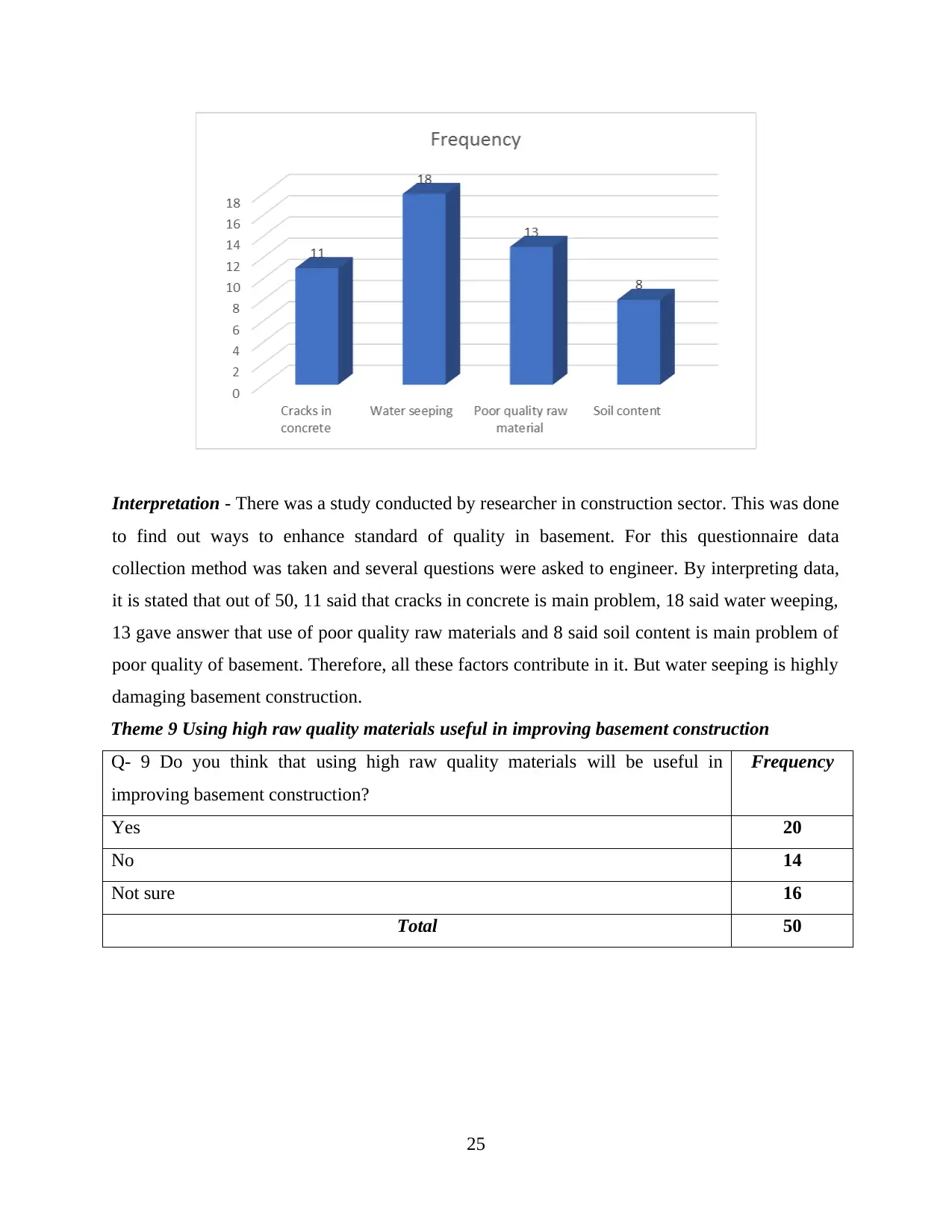
Interpretation - There was a study conducted by researcher in construction sector. This was done
to find out ways to enhance standard of quality in basement. For this questionnaire data
collection method was taken and several questions were asked to engineer. By interpreting data,
it is stated that out of 50, 11 said that cracks in concrete is main problem, 18 said water weeping,
13 gave answer that use of poor quality raw materials and 8 said soil content is main problem of
poor quality of basement. Therefore, all these factors contribute in it. But water seeping is highly
damaging basement construction.
Theme 9 Using high raw quality materials useful in improving basement construction
Q- 9 Do you think that using high raw quality materials will be useful in
improving basement construction?
Frequency
Yes 20
No 14
Not sure 16
Total 50
25
to find out ways to enhance standard of quality in basement. For this questionnaire data
collection method was taken and several questions were asked to engineer. By interpreting data,
it is stated that out of 50, 11 said that cracks in concrete is main problem, 18 said water weeping,
13 gave answer that use of poor quality raw materials and 8 said soil content is main problem of
poor quality of basement. Therefore, all these factors contribute in it. But water seeping is highly
damaging basement construction.
Theme 9 Using high raw quality materials useful in improving basement construction
Q- 9 Do you think that using high raw quality materials will be useful in
improving basement construction?
Frequency
Yes 20
No 14
Not sure 16
Total 50
25
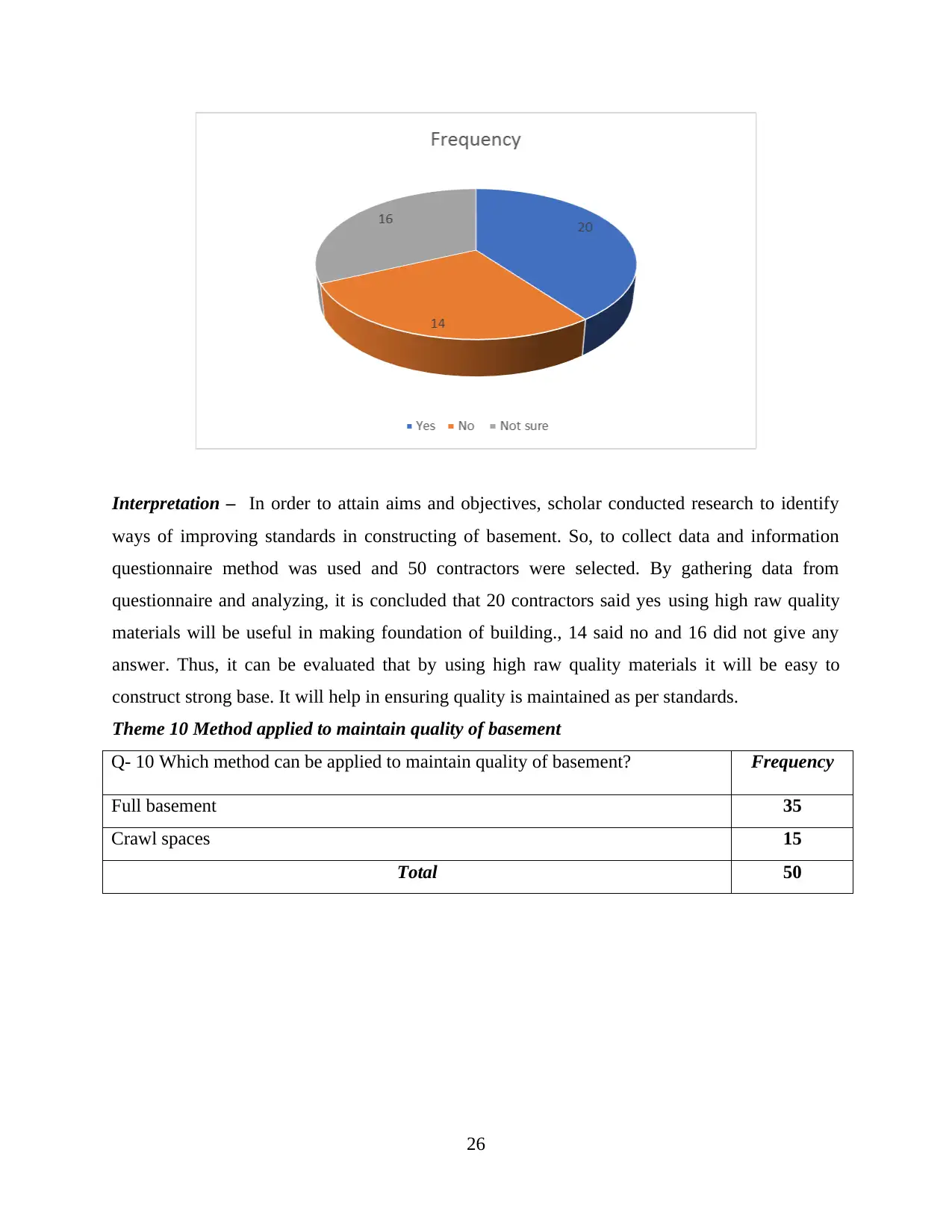
Interpretation – In order to attain aims and objectives, scholar conducted research to identify
ways of improving standards in constructing of basement. So, to collect data and information
questionnaire method was used and 50 contractors were selected. By gathering data from
questionnaire and analyzing, it is concluded that 20 contractors said yes using high raw quality
materials will be useful in making foundation of building., 14 said no and 16 did not give any
answer. Thus, it can be evaluated that by using high raw quality materials it will be easy to
construct strong base. It will help in ensuring quality is maintained as per standards.
Theme 10 Method applied to maintain quality of basement
Q- 10 Which method can be applied to maintain quality of basement? Frequency
Full basement 35
Crawl spaces 15
Total 50
26
ways of improving standards in constructing of basement. So, to collect data and information
questionnaire method was used and 50 contractors were selected. By gathering data from
questionnaire and analyzing, it is concluded that 20 contractors said yes using high raw quality
materials will be useful in making foundation of building., 14 said no and 16 did not give any
answer. Thus, it can be evaluated that by using high raw quality materials it will be easy to
construct strong base. It will help in ensuring quality is maintained as per standards.
Theme 10 Method applied to maintain quality of basement
Q- 10 Which method can be applied to maintain quality of basement? Frequency
Full basement 35
Crawl spaces 15
Total 50
26
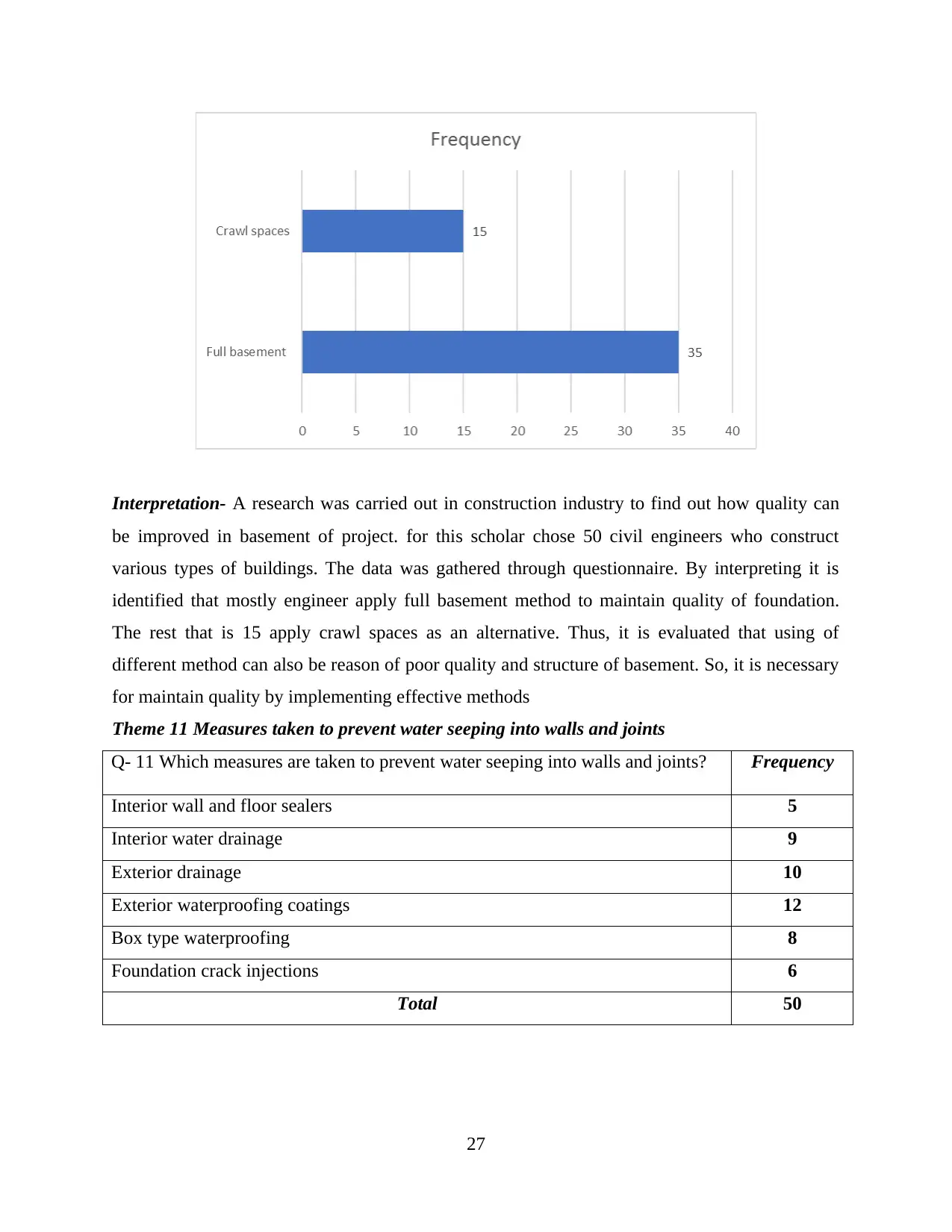
Interpretation- A research was carried out in construction industry to find out how quality can
be improved in basement of project. for this scholar chose 50 civil engineers who construct
various types of buildings. The data was gathered through questionnaire. By interpreting it is
identified that mostly engineer apply full basement method to maintain quality of foundation.
The rest that is 15 apply crawl spaces as an alternative. Thus, it is evaluated that using of
different method can also be reason of poor quality and structure of basement. So, it is necessary
for maintain quality by implementing effective methods
Theme 11 Measures taken to prevent water seeping into walls and joints
Q- 11 Which measures are taken to prevent water seeping into walls and joints? Frequency
Interior wall and floor sealers 5
Interior water drainage 9
Exterior drainage 10
Exterior waterproofing coatings 12
Box type waterproofing 8
Foundation crack injections 6
Total 50
27
be improved in basement of project. for this scholar chose 50 civil engineers who construct
various types of buildings. The data was gathered through questionnaire. By interpreting it is
identified that mostly engineer apply full basement method to maintain quality of foundation.
The rest that is 15 apply crawl spaces as an alternative. Thus, it is evaluated that using of
different method can also be reason of poor quality and structure of basement. So, it is necessary
for maintain quality by implementing effective methods
Theme 11 Measures taken to prevent water seeping into walls and joints
Q- 11 Which measures are taken to prevent water seeping into walls and joints? Frequency
Interior wall and floor sealers 5
Interior water drainage 9
Exterior drainage 10
Exterior waterproofing coatings 12
Box type waterproofing 8
Foundation crack injections 6
Total 50
27
Paraphrase This Document
Need a fresh take? Get an instant paraphrase of this document with our AI Paraphraser
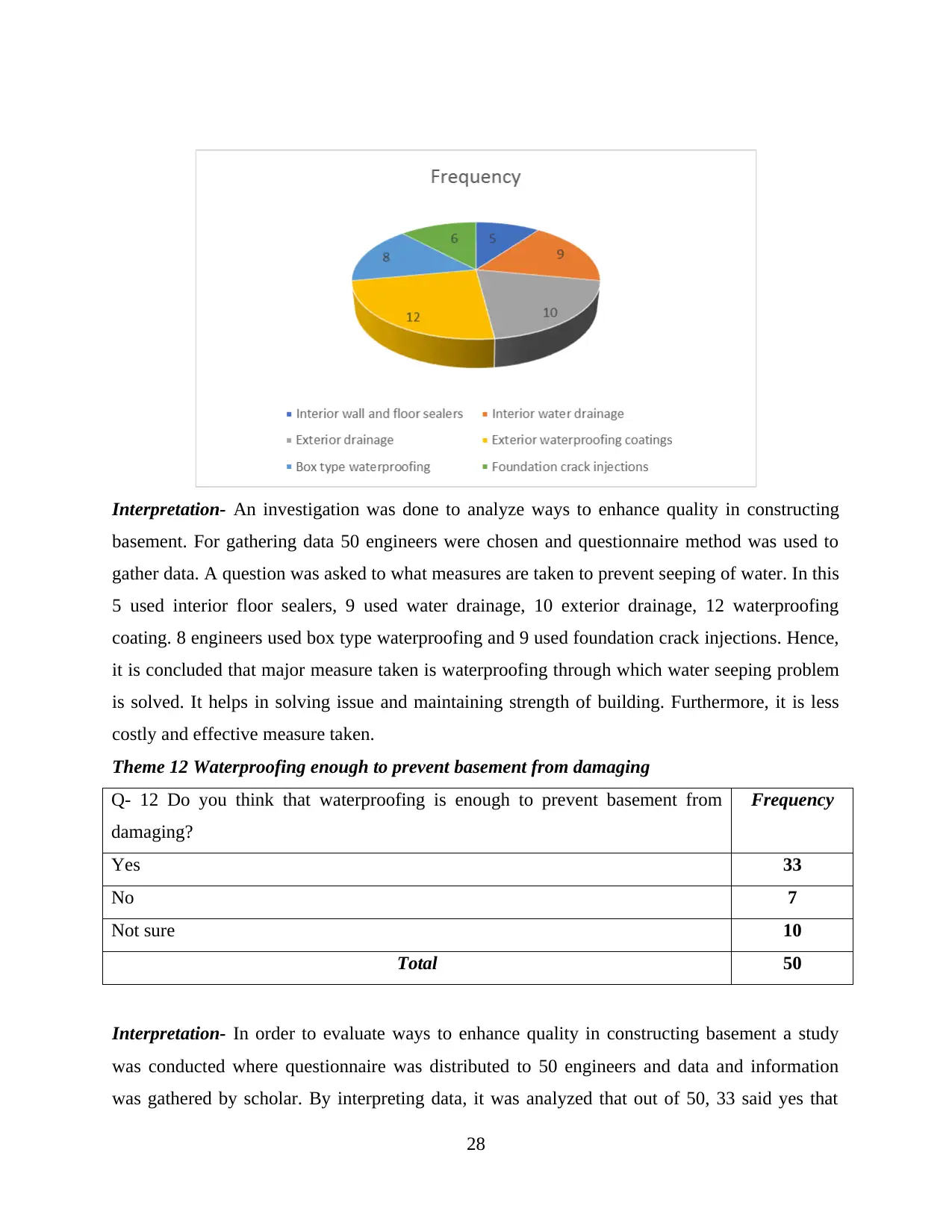
Interpretation- An investigation was done to analyze ways to enhance quality in constructing
basement. For gathering data 50 engineers were chosen and questionnaire method was used to
gather data. A question was asked to what measures are taken to prevent seeping of water. In this
5 used interior floor sealers, 9 used water drainage, 10 exterior drainage, 12 waterproofing
coating. 8 engineers used box type waterproofing and 9 used foundation crack injections. Hence,
it is concluded that major measure taken is waterproofing through which water seeping problem
is solved. It helps in solving issue and maintaining strength of building. Furthermore, it is less
costly and effective measure taken.
Theme 12 Waterproofing enough to prevent basement from damaging
Q- 12 Do you think that waterproofing is enough to prevent basement from
damaging?
Frequency
Yes 33
No 7
Not sure 10
Total 50
Interpretation- In order to evaluate ways to enhance quality in constructing basement a study
was conducted where questionnaire was distributed to 50 engineers and data and information
was gathered by scholar. By interpreting data, it was analyzed that out of 50, 33 said yes that
28
basement. For gathering data 50 engineers were chosen and questionnaire method was used to
gather data. A question was asked to what measures are taken to prevent seeping of water. In this
5 used interior floor sealers, 9 used water drainage, 10 exterior drainage, 12 waterproofing
coating. 8 engineers used box type waterproofing and 9 used foundation crack injections. Hence,
it is concluded that major measure taken is waterproofing through which water seeping problem
is solved. It helps in solving issue and maintaining strength of building. Furthermore, it is less
costly and effective measure taken.
Theme 12 Waterproofing enough to prevent basement from damaging
Q- 12 Do you think that waterproofing is enough to prevent basement from
damaging?
Frequency
Yes 33
No 7
Not sure 10
Total 50
Interpretation- In order to evaluate ways to enhance quality in constructing basement a study
was conducted where questionnaire was distributed to 50 engineers and data and information
was gathered by scholar. By interpreting data, it was analyzed that out of 50, 33 said yes that
28
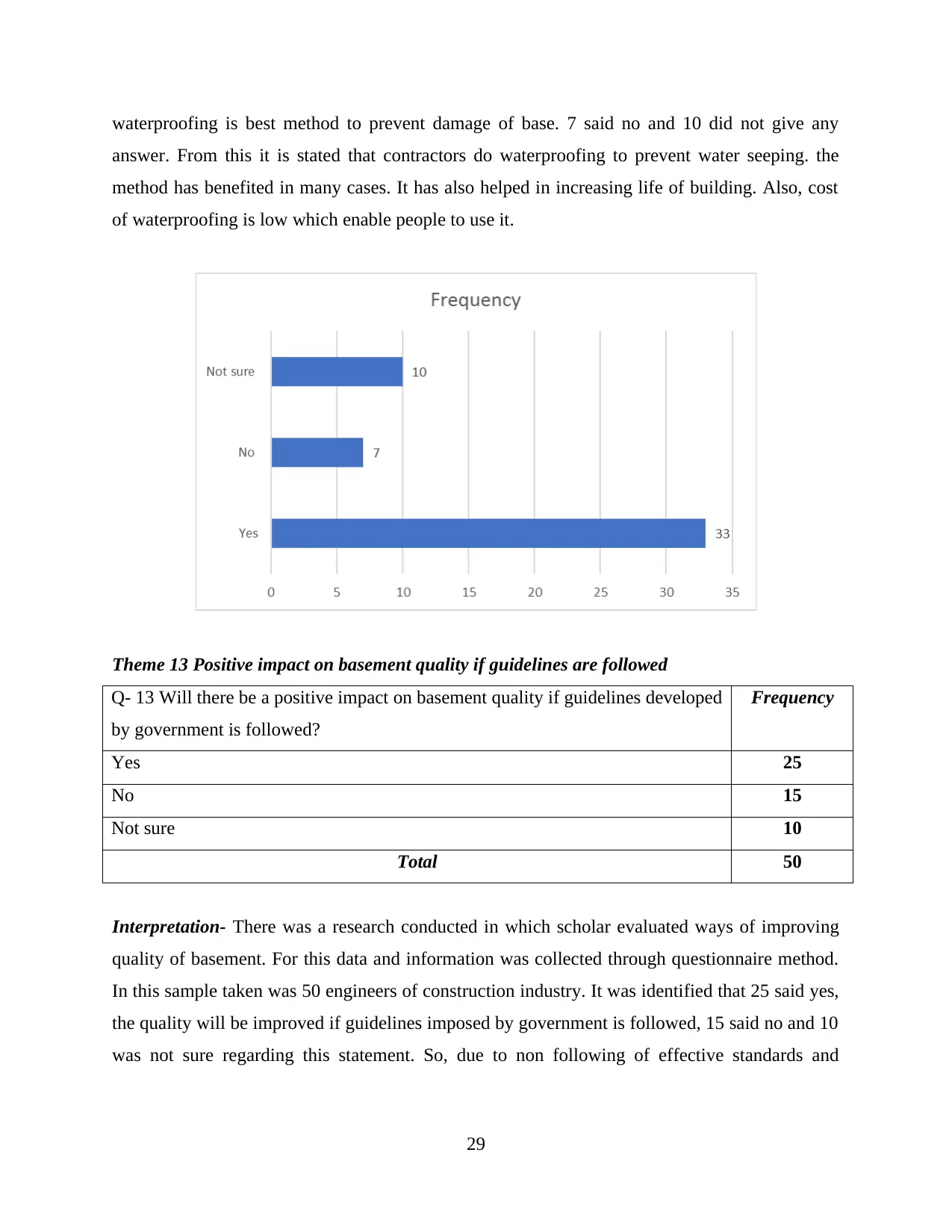
waterproofing is best method to prevent damage of base. 7 said no and 10 did not give any
answer. From this it is stated that contractors do waterproofing to prevent water seeping. the
method has benefited in many cases. It has also helped in increasing life of building. Also, cost
of waterproofing is low which enable people to use it.
Theme 13 Positive impact on basement quality if guidelines are followed
Q- 13 Will there be a positive impact on basement quality if guidelines developed
by government is followed?
Frequency
Yes 25
No 15
Not sure 10
Total 50
Interpretation- There was a research conducted in which scholar evaluated ways of improving
quality of basement. For this data and information was collected through questionnaire method.
In this sample taken was 50 engineers of construction industry. It was identified that 25 said yes,
the quality will be improved if guidelines imposed by government is followed, 15 said no and 10
was not sure regarding this statement. So, due to non following of effective standards and
29
answer. From this it is stated that contractors do waterproofing to prevent water seeping. the
method has benefited in many cases. It has also helped in increasing life of building. Also, cost
of waterproofing is low which enable people to use it.
Theme 13 Positive impact on basement quality if guidelines are followed
Q- 13 Will there be a positive impact on basement quality if guidelines developed
by government is followed?
Frequency
Yes 25
No 15
Not sure 10
Total 50
Interpretation- There was a research conducted in which scholar evaluated ways of improving
quality of basement. For this data and information was collected through questionnaire method.
In this sample taken was 50 engineers of construction industry. It was identified that 25 said yes,
the quality will be improved if guidelines imposed by government is followed, 15 said no and 10
was not sure regarding this statement. So, due to non following of effective standards and
29
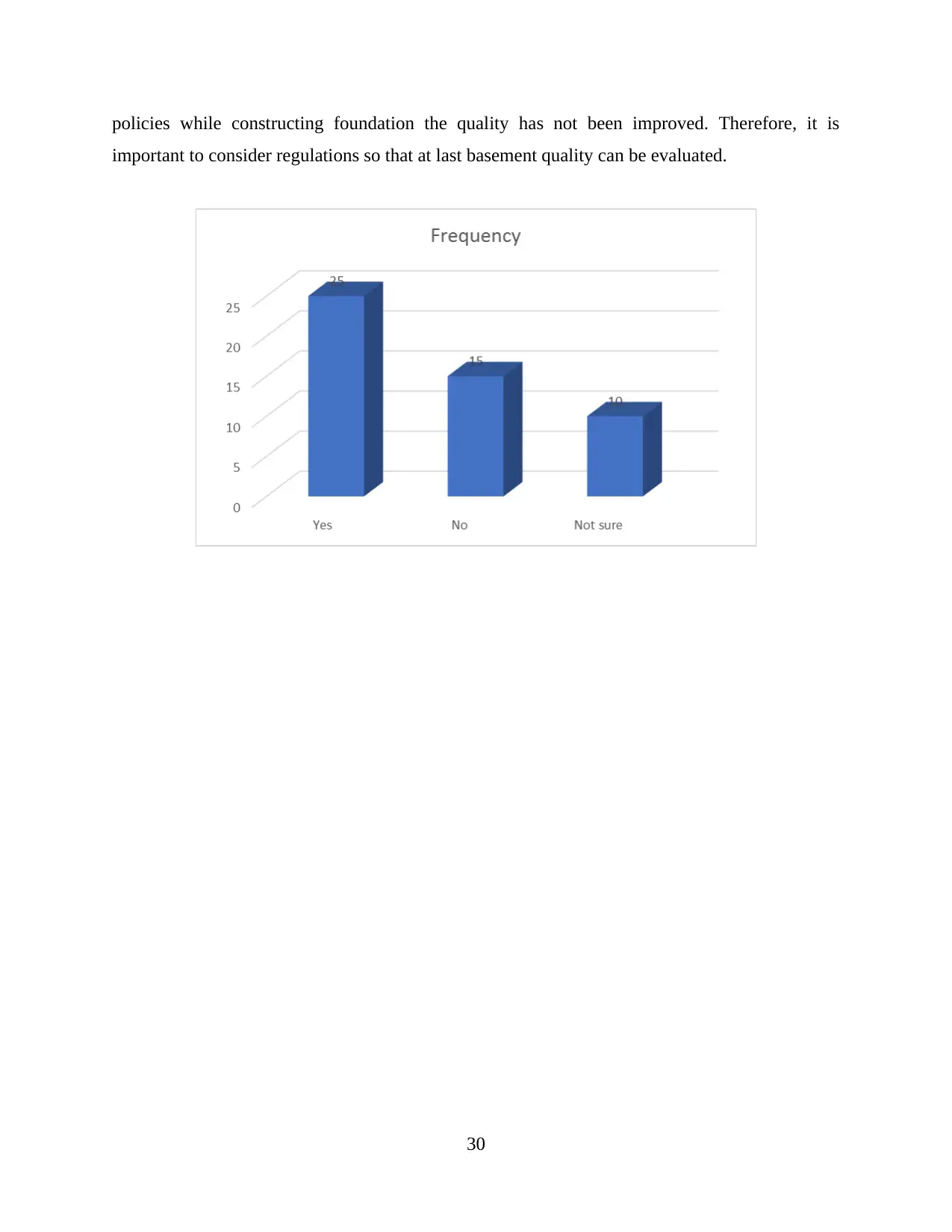
policies while constructing foundation the quality has not been improved. Therefore, it is
important to consider regulations so that at last basement quality can be evaluated.
30
important to consider regulations so that at last basement quality can be evaluated.
30
Secure Best Marks with AI Grader
Need help grading? Try our AI Grader for instant feedback on your assignments.
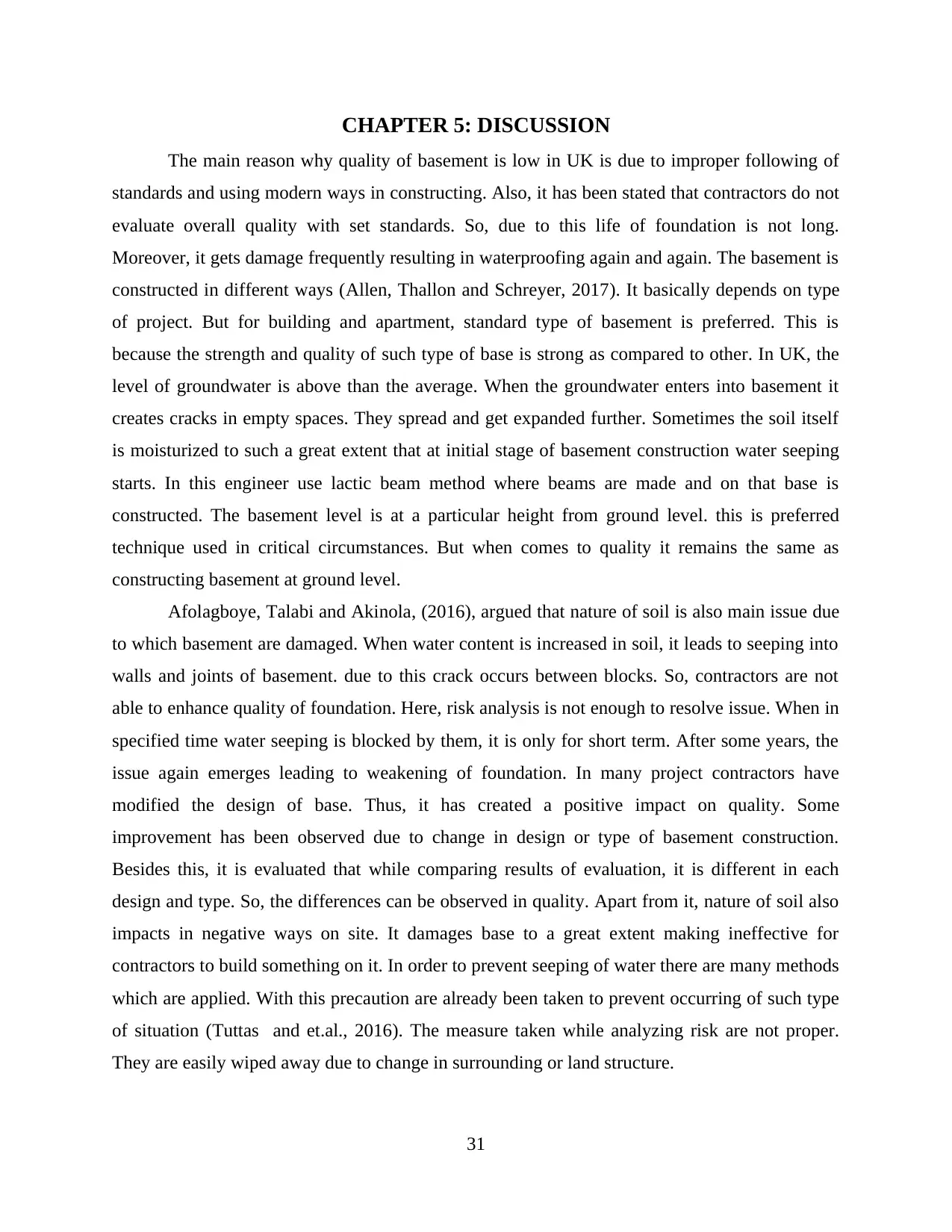
CHAPTER 5: DISCUSSION
The main reason why quality of basement is low in UK is due to improper following of
standards and using modern ways in constructing. Also, it has been stated that contractors do not
evaluate overall quality with set standards. So, due to this life of foundation is not long.
Moreover, it gets damage frequently resulting in waterproofing again and again. The basement is
constructed in different ways (Allen, Thallon and Schreyer, 2017). It basically depends on type
of project. But for building and apartment, standard type of basement is preferred. This is
because the strength and quality of such type of base is strong as compared to other. In UK, the
level of groundwater is above than the average. When the groundwater enters into basement it
creates cracks in empty spaces. They spread and get expanded further. Sometimes the soil itself
is moisturized to such a great extent that at initial stage of basement construction water seeping
starts. In this engineer use lactic beam method where beams are made and on that base is
constructed. The basement level is at a particular height from ground level. this is preferred
technique used in critical circumstances. But when comes to quality it remains the same as
constructing basement at ground level.
Afolagboye, Talabi and Akinola, (2016), argued that nature of soil is also main issue due
to which basement are damaged. When water content is increased in soil, it leads to seeping into
walls and joints of basement. due to this crack occurs between blocks. So, contractors are not
able to enhance quality of foundation. Here, risk analysis is not enough to resolve issue. When in
specified time water seeping is blocked by them, it is only for short term. After some years, the
issue again emerges leading to weakening of foundation. In many project contractors have
modified the design of base. Thus, it has created a positive impact on quality. Some
improvement has been observed due to change in design or type of basement construction.
Besides this, it is evaluated that while comparing results of evaluation, it is different in each
design and type. So, the differences can be observed in quality. Apart from it, nature of soil also
impacts in negative ways on site. It damages base to a great extent making ineffective for
contractors to build something on it. In order to prevent seeping of water there are many methods
which are applied. With this precaution are already been taken to prevent occurring of such type
of situation (Tuttas and et.al., 2016). The measure taken while analyzing risk are not proper.
They are easily wiped away due to change in surrounding or land structure.
31
The main reason why quality of basement is low in UK is due to improper following of
standards and using modern ways in constructing. Also, it has been stated that contractors do not
evaluate overall quality with set standards. So, due to this life of foundation is not long.
Moreover, it gets damage frequently resulting in waterproofing again and again. The basement is
constructed in different ways (Allen, Thallon and Schreyer, 2017). It basically depends on type
of project. But for building and apartment, standard type of basement is preferred. This is
because the strength and quality of such type of base is strong as compared to other. In UK, the
level of groundwater is above than the average. When the groundwater enters into basement it
creates cracks in empty spaces. They spread and get expanded further. Sometimes the soil itself
is moisturized to such a great extent that at initial stage of basement construction water seeping
starts. In this engineer use lactic beam method where beams are made and on that base is
constructed. The basement level is at a particular height from ground level. this is preferred
technique used in critical circumstances. But when comes to quality it remains the same as
constructing basement at ground level.
Afolagboye, Talabi and Akinola, (2016), argued that nature of soil is also main issue due
to which basement are damaged. When water content is increased in soil, it leads to seeping into
walls and joints of basement. due to this crack occurs between blocks. So, contractors are not
able to enhance quality of foundation. Here, risk analysis is not enough to resolve issue. When in
specified time water seeping is blocked by them, it is only for short term. After some years, the
issue again emerges leading to weakening of foundation. In many project contractors have
modified the design of base. Thus, it has created a positive impact on quality. Some
improvement has been observed due to change in design or type of basement construction.
Besides this, it is evaluated that while comparing results of evaluation, it is different in each
design and type. So, the differences can be observed in quality. Apart from it, nature of soil also
impacts in negative ways on site. It damages base to a great extent making ineffective for
contractors to build something on it. In order to prevent seeping of water there are many methods
which are applied. With this precaution are already been taken to prevent occurring of such type
of situation (Tuttas and et.al., 2016). The measure taken while analyzing risk are not proper.
They are easily wiped away due to change in surrounding or land structure.
31
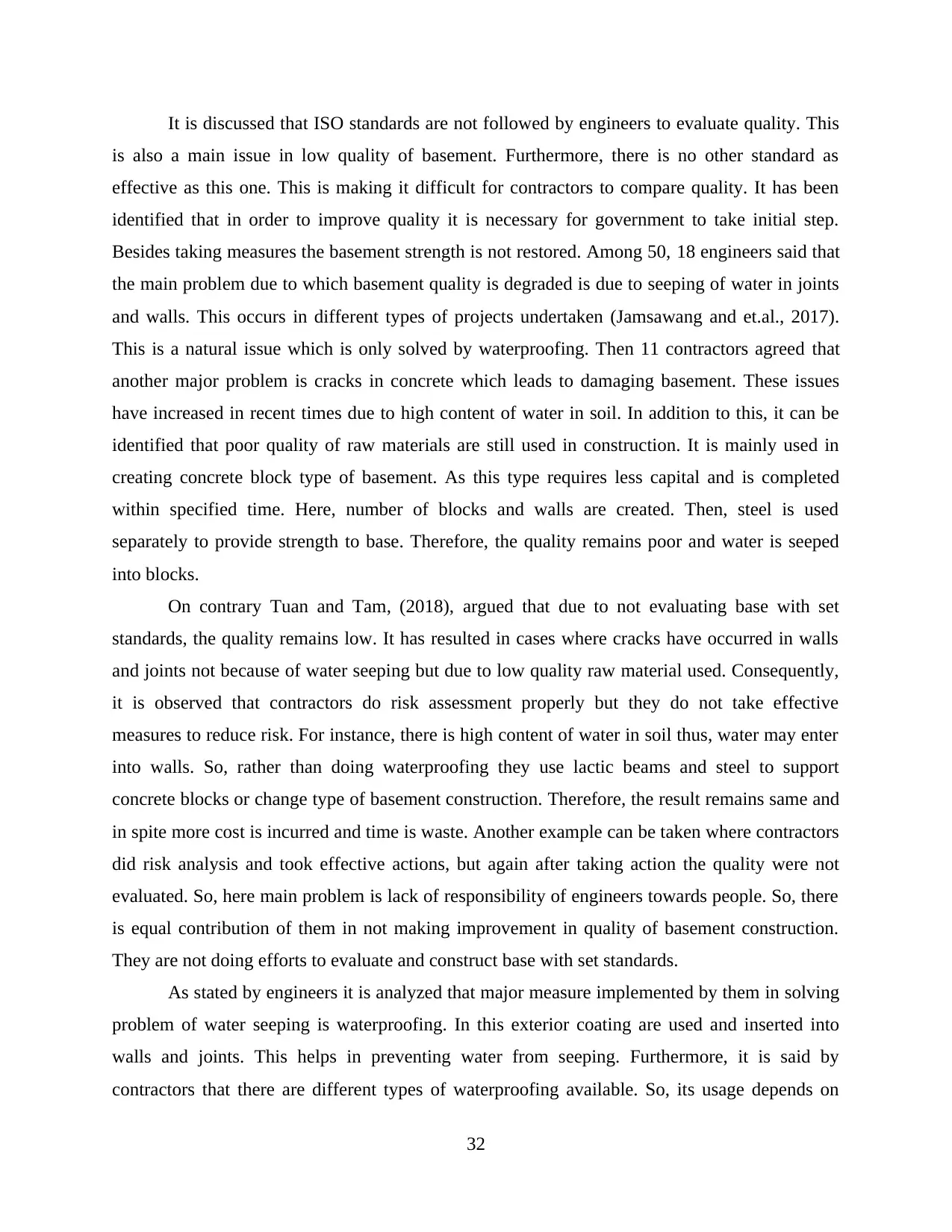
It is discussed that ISO standards are not followed by engineers to evaluate quality. This
is also a main issue in low quality of basement. Furthermore, there is no other standard as
effective as this one. This is making it difficult for contractors to compare quality. It has been
identified that in order to improve quality it is necessary for government to take initial step.
Besides taking measures the basement strength is not restored. Among 50, 18 engineers said that
the main problem due to which basement quality is degraded is due to seeping of water in joints
and walls. This occurs in different types of projects undertaken (Jamsawang and et.al., 2017).
This is a natural issue which is only solved by waterproofing. Then 11 contractors agreed that
another major problem is cracks in concrete which leads to damaging basement. These issues
have increased in recent times due to high content of water in soil. In addition to this, it can be
identified that poor quality of raw materials are still used in construction. It is mainly used in
creating concrete block type of basement. As this type requires less capital and is completed
within specified time. Here, number of blocks and walls are created. Then, steel is used
separately to provide strength to base. Therefore, the quality remains poor and water is seeped
into blocks.
On contrary Tuan and Tam, (2018), argued that due to not evaluating base with set
standards, the quality remains low. It has resulted in cases where cracks have occurred in walls
and joints not because of water seeping but due to low quality raw material used. Consequently,
it is observed that contractors do risk assessment properly but they do not take effective
measures to reduce risk. For instance, there is high content of water in soil thus, water may enter
into walls. So, rather than doing waterproofing they use lactic beams and steel to support
concrete blocks or change type of basement construction. Therefore, the result remains same and
in spite more cost is incurred and time is waste. Another example can be taken where contractors
did risk analysis and took effective actions, but again after taking action the quality were not
evaluated. So, here main problem is lack of responsibility of engineers towards people. So, there
is equal contribution of them in not making improvement in quality of basement construction.
They are not doing efforts to evaluate and construct base with set standards.
As stated by engineers it is analyzed that major measure implemented by them in solving
problem of water seeping is waterproofing. In this exterior coating are used and inserted into
walls and joints. This helps in preventing water from seeping. Furthermore, it is said by
contractors that there are different types of waterproofing available. So, its usage depends on
32
is also a main issue in low quality of basement. Furthermore, there is no other standard as
effective as this one. This is making it difficult for contractors to compare quality. It has been
identified that in order to improve quality it is necessary for government to take initial step.
Besides taking measures the basement strength is not restored. Among 50, 18 engineers said that
the main problem due to which basement quality is degraded is due to seeping of water in joints
and walls. This occurs in different types of projects undertaken (Jamsawang and et.al., 2017).
This is a natural issue which is only solved by waterproofing. Then 11 contractors agreed that
another major problem is cracks in concrete which leads to damaging basement. These issues
have increased in recent times due to high content of water in soil. In addition to this, it can be
identified that poor quality of raw materials are still used in construction. It is mainly used in
creating concrete block type of basement. As this type requires less capital and is completed
within specified time. Here, number of blocks and walls are created. Then, steel is used
separately to provide strength to base. Therefore, the quality remains poor and water is seeped
into blocks.
On contrary Tuan and Tam, (2018), argued that due to not evaluating base with set
standards, the quality remains low. It has resulted in cases where cracks have occurred in walls
and joints not because of water seeping but due to low quality raw material used. Consequently,
it is observed that contractors do risk assessment properly but they do not take effective
measures to reduce risk. For instance, there is high content of water in soil thus, water may enter
into walls. So, rather than doing waterproofing they use lactic beams and steel to support
concrete blocks or change type of basement construction. Therefore, the result remains same and
in spite more cost is incurred and time is waste. Another example can be taken where contractors
did risk analysis and took effective actions, but again after taking action the quality were not
evaluated. So, here main problem is lack of responsibility of engineers towards people. So, there
is equal contribution of them in not making improvement in quality of basement construction.
They are not doing efforts to evaluate and construct base with set standards.
As stated by engineers it is analyzed that major measure implemented by them in solving
problem of water seeping is waterproofing. In this exterior coating are used and inserted into
walls and joints. This helps in preventing water from seeping. Furthermore, it is said by
contractors that there are different types of waterproofing available. So, its usage depends on
32
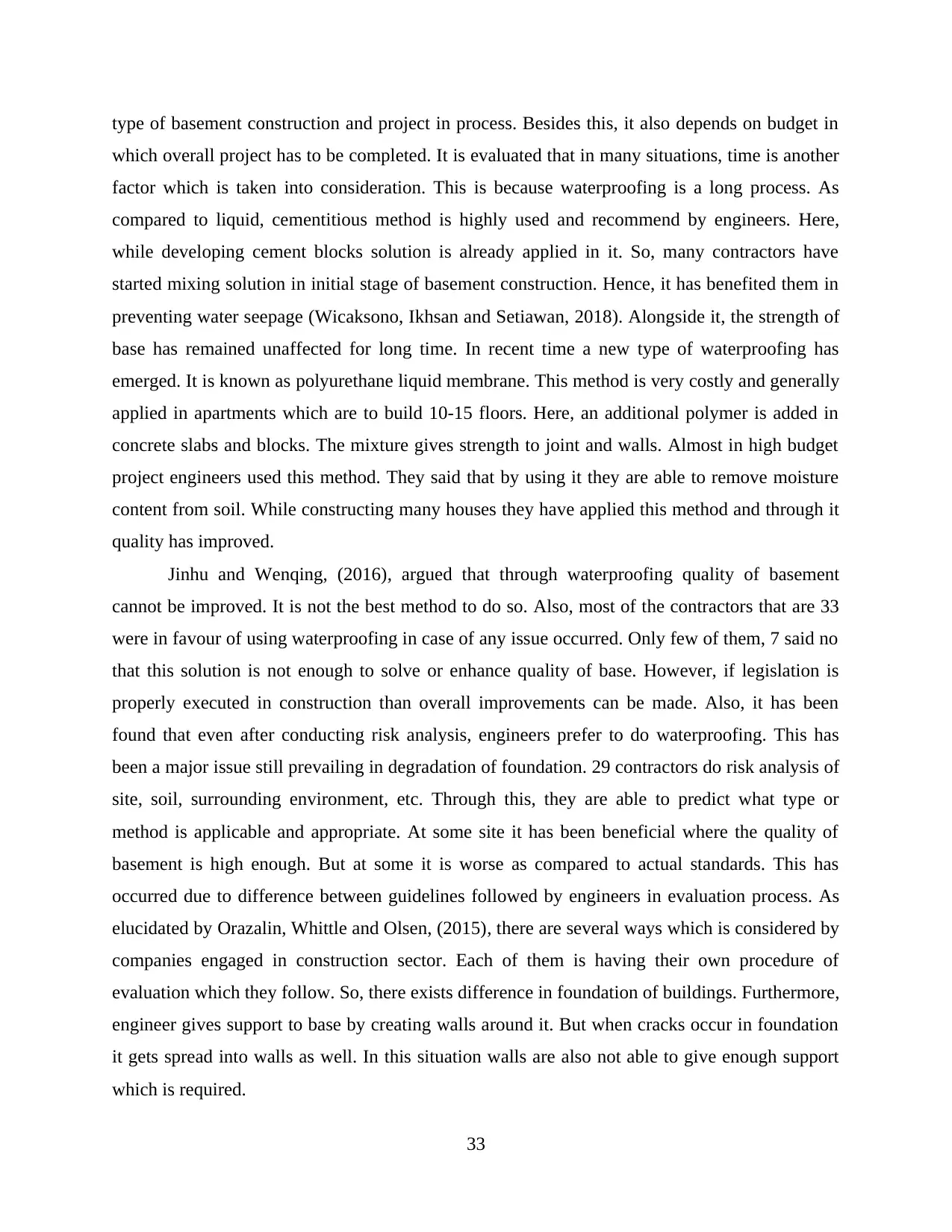
type of basement construction and project in process. Besides this, it also depends on budget in
which overall project has to be completed. It is evaluated that in many situations, time is another
factor which is taken into consideration. This is because waterproofing is a long process. As
compared to liquid, cementitious method is highly used and recommend by engineers. Here,
while developing cement blocks solution is already applied in it. So, many contractors have
started mixing solution in initial stage of basement construction. Hence, it has benefited them in
preventing water seepage (Wicaksono, Ikhsan and Setiawan, 2018). Alongside it, the strength of
base has remained unaffected for long time. In recent time a new type of waterproofing has
emerged. It is known as polyurethane liquid membrane. This method is very costly and generally
applied in apartments which are to build 10-15 floors. Here, an additional polymer is added in
concrete slabs and blocks. The mixture gives strength to joint and walls. Almost in high budget
project engineers used this method. They said that by using it they are able to remove moisture
content from soil. While constructing many houses they have applied this method and through it
quality has improved.
Jinhu and Wenqing, (2016), argued that through waterproofing quality of basement
cannot be improved. It is not the best method to do so. Also, most of the contractors that are 33
were in favour of using waterproofing in case of any issue occurred. Only few of them, 7 said no
that this solution is not enough to solve or enhance quality of base. However, if legislation is
properly executed in construction than overall improvements can be made. Also, it has been
found that even after conducting risk analysis, engineers prefer to do waterproofing. This has
been a major issue still prevailing in degradation of foundation. 29 contractors do risk analysis of
site, soil, surrounding environment, etc. Through this, they are able to predict what type or
method is applicable and appropriate. At some site it has been beneficial where the quality of
basement is high enough. But at some it is worse as compared to actual standards. This has
occurred due to difference between guidelines followed by engineers in evaluation process. As
elucidated by Orazalin, Whittle and Olsen, (2015), there are several ways which is considered by
companies engaged in construction sector. Each of them is having their own procedure of
evaluation which they follow. So, there exists difference in foundation of buildings. Furthermore,
engineer gives support to base by creating walls around it. But when cracks occur in foundation
it gets spread into walls as well. In this situation walls are also not able to give enough support
which is required.
33
which overall project has to be completed. It is evaluated that in many situations, time is another
factor which is taken into consideration. This is because waterproofing is a long process. As
compared to liquid, cementitious method is highly used and recommend by engineers. Here,
while developing cement blocks solution is already applied in it. So, many contractors have
started mixing solution in initial stage of basement construction. Hence, it has benefited them in
preventing water seepage (Wicaksono, Ikhsan and Setiawan, 2018). Alongside it, the strength of
base has remained unaffected for long time. In recent time a new type of waterproofing has
emerged. It is known as polyurethane liquid membrane. This method is very costly and generally
applied in apartments which are to build 10-15 floors. Here, an additional polymer is added in
concrete slabs and blocks. The mixture gives strength to joint and walls. Almost in high budget
project engineers used this method. They said that by using it they are able to remove moisture
content from soil. While constructing many houses they have applied this method and through it
quality has improved.
Jinhu and Wenqing, (2016), argued that through waterproofing quality of basement
cannot be improved. It is not the best method to do so. Also, most of the contractors that are 33
were in favour of using waterproofing in case of any issue occurred. Only few of them, 7 said no
that this solution is not enough to solve or enhance quality of base. However, if legislation is
properly executed in construction than overall improvements can be made. Also, it has been
found that even after conducting risk analysis, engineers prefer to do waterproofing. This has
been a major issue still prevailing in degradation of foundation. 29 contractors do risk analysis of
site, soil, surrounding environment, etc. Through this, they are able to predict what type or
method is applicable and appropriate. At some site it has been beneficial where the quality of
basement is high enough. But at some it is worse as compared to actual standards. This has
occurred due to difference between guidelines followed by engineers in evaluation process. As
elucidated by Orazalin, Whittle and Olsen, (2015), there are several ways which is considered by
companies engaged in construction sector. Each of them is having their own procedure of
evaluation which they follow. So, there exists difference in foundation of buildings. Furthermore,
engineer gives support to base by creating walls around it. But when cracks occur in foundation
it gets spread into walls as well. In this situation walls are also not able to give enough support
which is required.
33
Paraphrase This Document
Need a fresh take? Get an instant paraphrase of this document with our AI Paraphraser
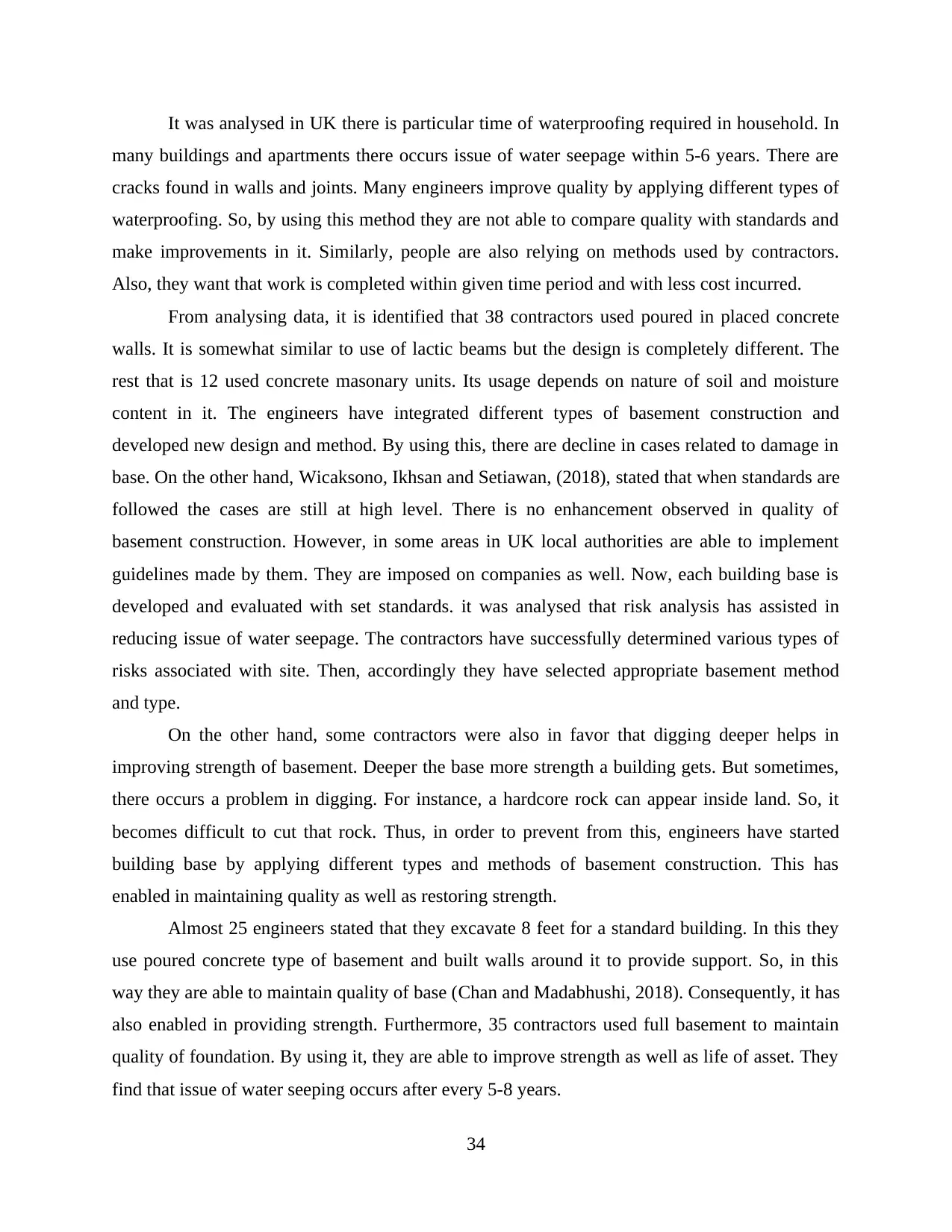
It was analysed in UK there is particular time of waterproofing required in household. In
many buildings and apartments there occurs issue of water seepage within 5-6 years. There are
cracks found in walls and joints. Many engineers improve quality by applying different types of
waterproofing. So, by using this method they are not able to compare quality with standards and
make improvements in it. Similarly, people are also relying on methods used by contractors.
Also, they want that work is completed within given time period and with less cost incurred.
From analysing data, it is identified that 38 contractors used poured in placed concrete
walls. It is somewhat similar to use of lactic beams but the design is completely different. The
rest that is 12 used concrete masonary units. Its usage depends on nature of soil and moisture
content in it. The engineers have integrated different types of basement construction and
developed new design and method. By using this, there are decline in cases related to damage in
base. On the other hand, Wicaksono, Ikhsan and Setiawan, (2018), stated that when standards are
followed the cases are still at high level. There is no enhancement observed in quality of
basement construction. However, in some areas in UK local authorities are able to implement
guidelines made by them. They are imposed on companies as well. Now, each building base is
developed and evaluated with set standards. it was analysed that risk analysis has assisted in
reducing issue of water seepage. The contractors have successfully determined various types of
risks associated with site. Then, accordingly they have selected appropriate basement method
and type.
On the other hand, some contractors were also in favor that digging deeper helps in
improving strength of basement. Deeper the base more strength a building gets. But sometimes,
there occurs a problem in digging. For instance, a hardcore rock can appear inside land. So, it
becomes difficult to cut that rock. Thus, in order to prevent from this, engineers have started
building base by applying different types and methods of basement construction. This has
enabled in maintaining quality as well as restoring strength.
Almost 25 engineers stated that they excavate 8 feet for a standard building. In this they
use poured concrete type of basement and built walls around it to provide support. So, in this
way they are able to maintain quality of base (Chan and Madabhushi, 2018). Consequently, it has
also enabled in providing strength. Furthermore, 35 contractors used full basement to maintain
quality of foundation. By using it, they are able to improve strength as well as life of asset. They
find that issue of water seeping occurs after every 5-8 years.
34
many buildings and apartments there occurs issue of water seepage within 5-6 years. There are
cracks found in walls and joints. Many engineers improve quality by applying different types of
waterproofing. So, by using this method they are not able to compare quality with standards and
make improvements in it. Similarly, people are also relying on methods used by contractors.
Also, they want that work is completed within given time period and with less cost incurred.
From analysing data, it is identified that 38 contractors used poured in placed concrete
walls. It is somewhat similar to use of lactic beams but the design is completely different. The
rest that is 12 used concrete masonary units. Its usage depends on nature of soil and moisture
content in it. The engineers have integrated different types of basement construction and
developed new design and method. By using this, there are decline in cases related to damage in
base. On the other hand, Wicaksono, Ikhsan and Setiawan, (2018), stated that when standards are
followed the cases are still at high level. There is no enhancement observed in quality of
basement construction. However, in some areas in UK local authorities are able to implement
guidelines made by them. They are imposed on companies as well. Now, each building base is
developed and evaluated with set standards. it was analysed that risk analysis has assisted in
reducing issue of water seepage. The contractors have successfully determined various types of
risks associated with site. Then, accordingly they have selected appropriate basement method
and type.
On the other hand, some contractors were also in favor that digging deeper helps in
improving strength of basement. Deeper the base more strength a building gets. But sometimes,
there occurs a problem in digging. For instance, a hardcore rock can appear inside land. So, it
becomes difficult to cut that rock. Thus, in order to prevent from this, engineers have started
building base by applying different types and methods of basement construction. This has
enabled in maintaining quality as well as restoring strength.
Almost 25 engineers stated that they excavate 8 feet for a standard building. In this they
use poured concrete type of basement and built walls around it to provide support. So, in this
way they are able to maintain quality of base (Chan and Madabhushi, 2018). Consequently, it has
also enabled in providing strength. Furthermore, 35 contractors used full basement to maintain
quality of foundation. By using it, they are able to improve strength as well as life of asset. They
find that issue of water seeping occurs after every 5-8 years.
34
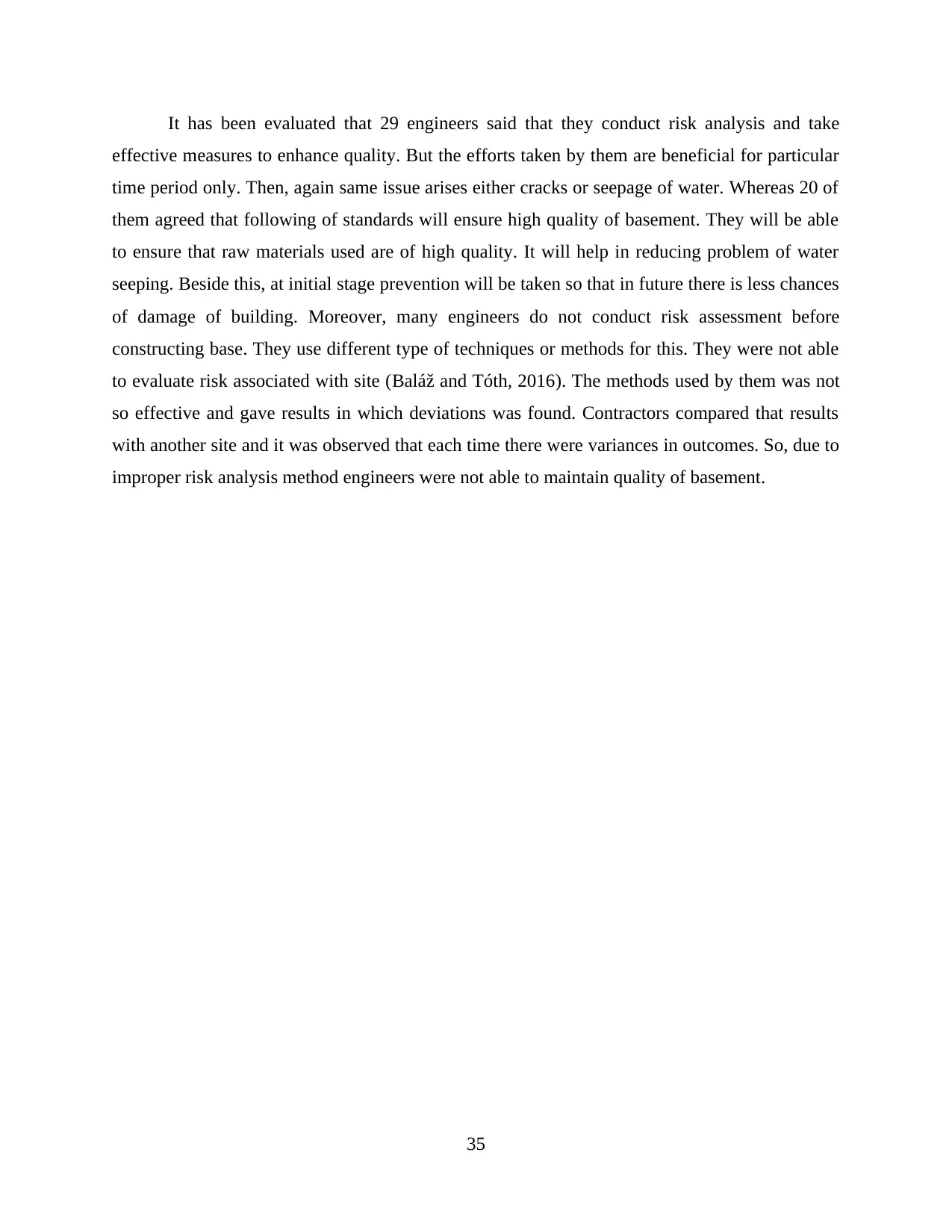
It has been evaluated that 29 engineers said that they conduct risk analysis and take
effective measures to enhance quality. But the efforts taken by them are beneficial for particular
time period only. Then, again same issue arises either cracks or seepage of water. Whereas 20 of
them agreed that following of standards will ensure high quality of basement. They will be able
to ensure that raw materials used are of high quality. It will help in reducing problem of water
seeping. Beside this, at initial stage prevention will be taken so that in future there is less chances
of damage of building. Moreover, many engineers do not conduct risk assessment before
constructing base. They use different type of techniques or methods for this. They were not able
to evaluate risk associated with site (Baláž and Tóth, 2016). The methods used by them was not
so effective and gave results in which deviations was found. Contractors compared that results
with another site and it was observed that each time there were variances in outcomes. So, due to
improper risk analysis method engineers were not able to maintain quality of basement.
35
effective measures to enhance quality. But the efforts taken by them are beneficial for particular
time period only. Then, again same issue arises either cracks or seepage of water. Whereas 20 of
them agreed that following of standards will ensure high quality of basement. They will be able
to ensure that raw materials used are of high quality. It will help in reducing problem of water
seeping. Beside this, at initial stage prevention will be taken so that in future there is less chances
of damage of building. Moreover, many engineers do not conduct risk assessment before
constructing base. They use different type of techniques or methods for this. They were not able
to evaluate risk associated with site (Baláž and Tóth, 2016). The methods used by them was not
so effective and gave results in which deviations was found. Contractors compared that results
with another site and it was observed that each time there were variances in outcomes. So, due to
improper risk analysis method engineers were not able to maintain quality of basement.
35
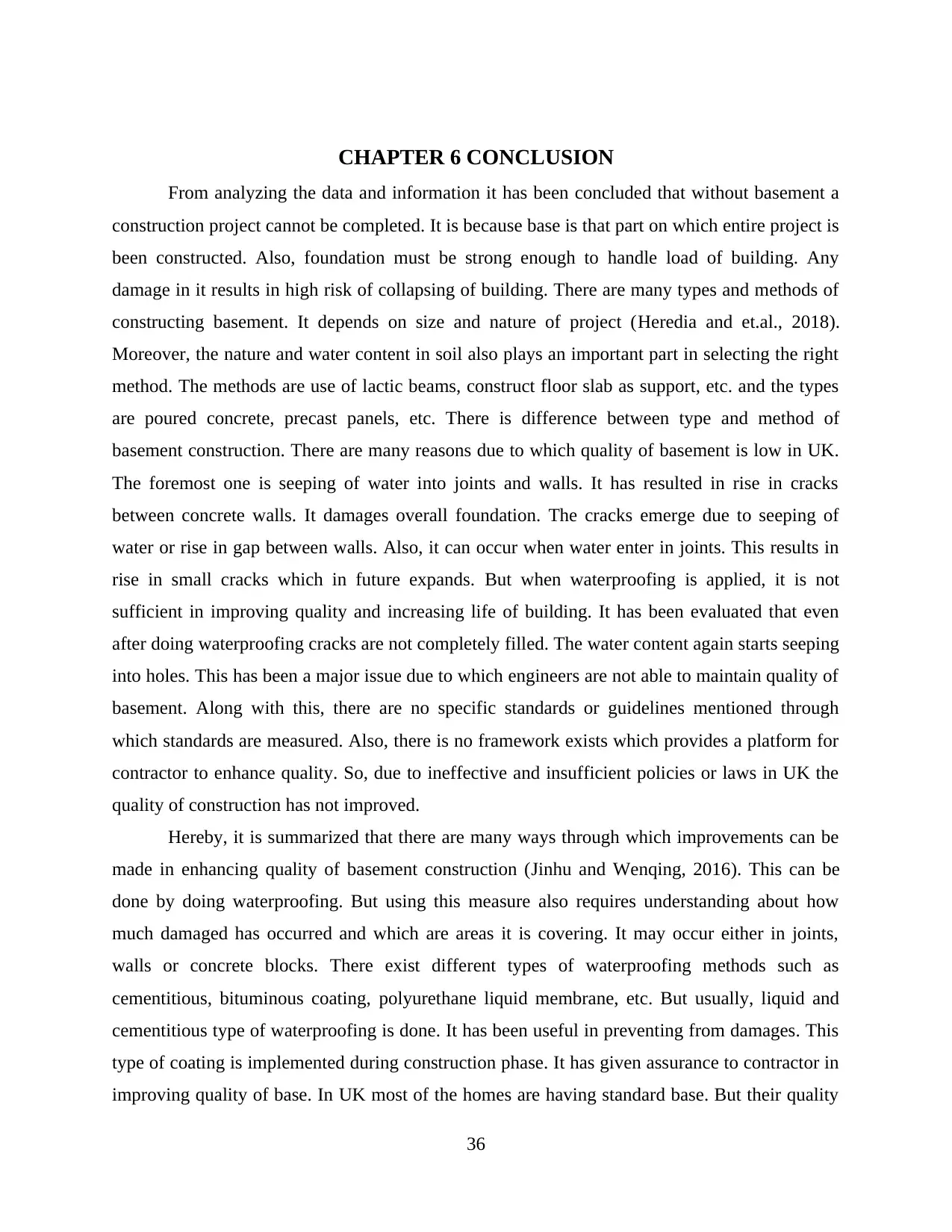
CHAPTER 6 CONCLUSION
From analyzing the data and information it has been concluded that without basement a
construction project cannot be completed. It is because base is that part on which entire project is
been constructed. Also, foundation must be strong enough to handle load of building. Any
damage in it results in high risk of collapsing of building. There are many types and methods of
constructing basement. It depends on size and nature of project (Heredia and et.al., 2018).
Moreover, the nature and water content in soil also plays an important part in selecting the right
method. The methods are use of lactic beams, construct floor slab as support, etc. and the types
are poured concrete, precast panels, etc. There is difference between type and method of
basement construction. There are many reasons due to which quality of basement is low in UK.
The foremost one is seeping of water into joints and walls. It has resulted in rise in cracks
between concrete walls. It damages overall foundation. The cracks emerge due to seeping of
water or rise in gap between walls. Also, it can occur when water enter in joints. This results in
rise in small cracks which in future expands. But when waterproofing is applied, it is not
sufficient in improving quality and increasing life of building. It has been evaluated that even
after doing waterproofing cracks are not completely filled. The water content again starts seeping
into holes. This has been a major issue due to which engineers are not able to maintain quality of
basement. Along with this, there are no specific standards or guidelines mentioned through
which standards are measured. Also, there is no framework exists which provides a platform for
contractor to enhance quality. So, due to ineffective and insufficient policies or laws in UK the
quality of construction has not improved.
Hereby, it is summarized that there are many ways through which improvements can be
made in enhancing quality of basement construction (Jinhu and Wenqing, 2016). This can be
done by doing waterproofing. But using this measure also requires understanding about how
much damaged has occurred and which are areas it is covering. It may occur either in joints,
walls or concrete blocks. There exist different types of waterproofing methods such as
cementitious, bituminous coating, polyurethane liquid membrane, etc. But usually, liquid and
cementitious type of waterproofing is done. It has been useful in preventing from damages. This
type of coating is implemented during construction phase. It has given assurance to contractor in
improving quality of base. In UK most of the homes are having standard base. But their quality
36
From analyzing the data and information it has been concluded that without basement a
construction project cannot be completed. It is because base is that part on which entire project is
been constructed. Also, foundation must be strong enough to handle load of building. Any
damage in it results in high risk of collapsing of building. There are many types and methods of
constructing basement. It depends on size and nature of project (Heredia and et.al., 2018).
Moreover, the nature and water content in soil also plays an important part in selecting the right
method. The methods are use of lactic beams, construct floor slab as support, etc. and the types
are poured concrete, precast panels, etc. There is difference between type and method of
basement construction. There are many reasons due to which quality of basement is low in UK.
The foremost one is seeping of water into joints and walls. It has resulted in rise in cracks
between concrete walls. It damages overall foundation. The cracks emerge due to seeping of
water or rise in gap between walls. Also, it can occur when water enter in joints. This results in
rise in small cracks which in future expands. But when waterproofing is applied, it is not
sufficient in improving quality and increasing life of building. It has been evaluated that even
after doing waterproofing cracks are not completely filled. The water content again starts seeping
into holes. This has been a major issue due to which engineers are not able to maintain quality of
basement. Along with this, there are no specific standards or guidelines mentioned through
which standards are measured. Also, there is no framework exists which provides a platform for
contractor to enhance quality. So, due to ineffective and insufficient policies or laws in UK the
quality of construction has not improved.
Hereby, it is summarized that there are many ways through which improvements can be
made in enhancing quality of basement construction (Jinhu and Wenqing, 2016). This can be
done by doing waterproofing. But using this measure also requires understanding about how
much damaged has occurred and which are areas it is covering. It may occur either in joints,
walls or concrete blocks. There exist different types of waterproofing methods such as
cementitious, bituminous coating, polyurethane liquid membrane, etc. But usually, liquid and
cementitious type of waterproofing is done. It has been useful in preventing from damages. This
type of coating is implemented during construction phase. It has given assurance to contractor in
improving quality of base. In UK most of the homes are having standard base. But their quality
36
Secure Best Marks with AI Grader
Need help grading? Try our AI Grader for instant feedback on your assignments.
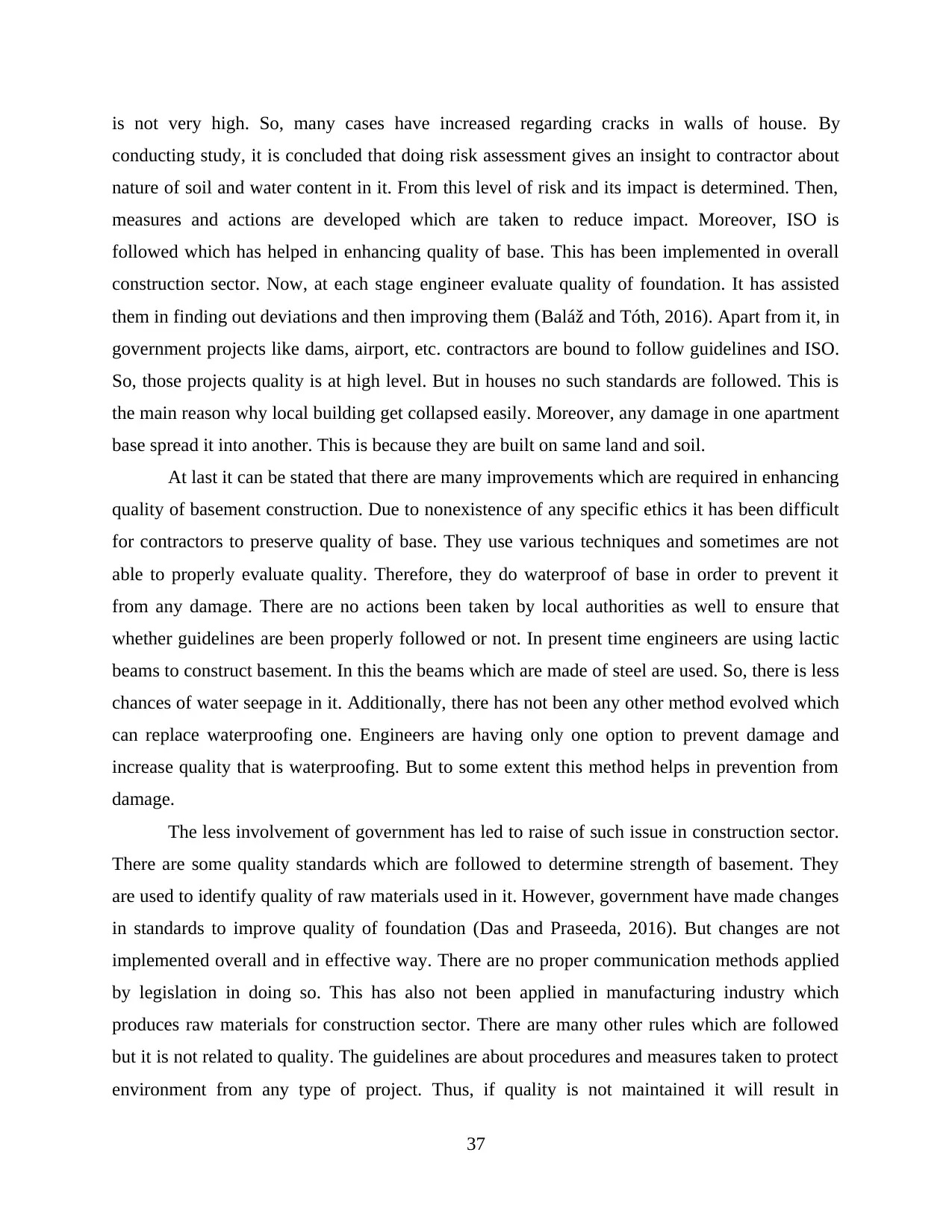
is not very high. So, many cases have increased regarding cracks in walls of house. By
conducting study, it is concluded that doing risk assessment gives an insight to contractor about
nature of soil and water content in it. From this level of risk and its impact is determined. Then,
measures and actions are developed which are taken to reduce impact. Moreover, ISO is
followed which has helped in enhancing quality of base. This has been implemented in overall
construction sector. Now, at each stage engineer evaluate quality of foundation. It has assisted
them in finding out deviations and then improving them (Baláž and Tóth, 2016). Apart from it, in
government projects like dams, airport, etc. contractors are bound to follow guidelines and ISO.
So, those projects quality is at high level. But in houses no such standards are followed. This is
the main reason why local building get collapsed easily. Moreover, any damage in one apartment
base spread it into another. This is because they are built on same land and soil.
At last it can be stated that there are many improvements which are required in enhancing
quality of basement construction. Due to nonexistence of any specific ethics it has been difficult
for contractors to preserve quality of base. They use various techniques and sometimes are not
able to properly evaluate quality. Therefore, they do waterproof of base in order to prevent it
from any damage. There are no actions been taken by local authorities as well to ensure that
whether guidelines are been properly followed or not. In present time engineers are using lactic
beams to construct basement. In this the beams which are made of steel are used. So, there is less
chances of water seepage in it. Additionally, there has not been any other method evolved which
can replace waterproofing one. Engineers are having only one option to prevent damage and
increase quality that is waterproofing. But to some extent this method helps in prevention from
damage.
The less involvement of government has led to raise of such issue in construction sector.
There are some quality standards which are followed to determine strength of basement. They
are used to identify quality of raw materials used in it. However, government have made changes
in standards to improve quality of foundation (Das and Praseeda, 2016). But changes are not
implemented overall and in effective way. There are no proper communication methods applied
by legislation in doing so. This has also not been applied in manufacturing industry which
produces raw materials for construction sector. There are many other rules which are followed
but it is not related to quality. The guidelines are about procedures and measures taken to protect
environment from any type of project. Thus, if quality is not maintained it will result in
37
conducting study, it is concluded that doing risk assessment gives an insight to contractor about
nature of soil and water content in it. From this level of risk and its impact is determined. Then,
measures and actions are developed which are taken to reduce impact. Moreover, ISO is
followed which has helped in enhancing quality of base. This has been implemented in overall
construction sector. Now, at each stage engineer evaluate quality of foundation. It has assisted
them in finding out deviations and then improving them (Baláž and Tóth, 2016). Apart from it, in
government projects like dams, airport, etc. contractors are bound to follow guidelines and ISO.
So, those projects quality is at high level. But in houses no such standards are followed. This is
the main reason why local building get collapsed easily. Moreover, any damage in one apartment
base spread it into another. This is because they are built on same land and soil.
At last it can be stated that there are many improvements which are required in enhancing
quality of basement construction. Due to nonexistence of any specific ethics it has been difficult
for contractors to preserve quality of base. They use various techniques and sometimes are not
able to properly evaluate quality. Therefore, they do waterproof of base in order to prevent it
from any damage. There are no actions been taken by local authorities as well to ensure that
whether guidelines are been properly followed or not. In present time engineers are using lactic
beams to construct basement. In this the beams which are made of steel are used. So, there is less
chances of water seepage in it. Additionally, there has not been any other method evolved which
can replace waterproofing one. Engineers are having only one option to prevent damage and
increase quality that is waterproofing. But to some extent this method helps in prevention from
damage.
The less involvement of government has led to raise of such issue in construction sector.
There are some quality standards which are followed to determine strength of basement. They
are used to identify quality of raw materials used in it. However, government have made changes
in standards to improve quality of foundation (Das and Praseeda, 2016). But changes are not
implemented overall and in effective way. There are no proper communication methods applied
by legislation in doing so. This has also not been applied in manufacturing industry which
produces raw materials for construction sector. There are many other rules which are followed
but it is not related to quality. The guidelines are about procedures and measures taken to protect
environment from any type of project. Thus, if quality is not maintained it will result in
37
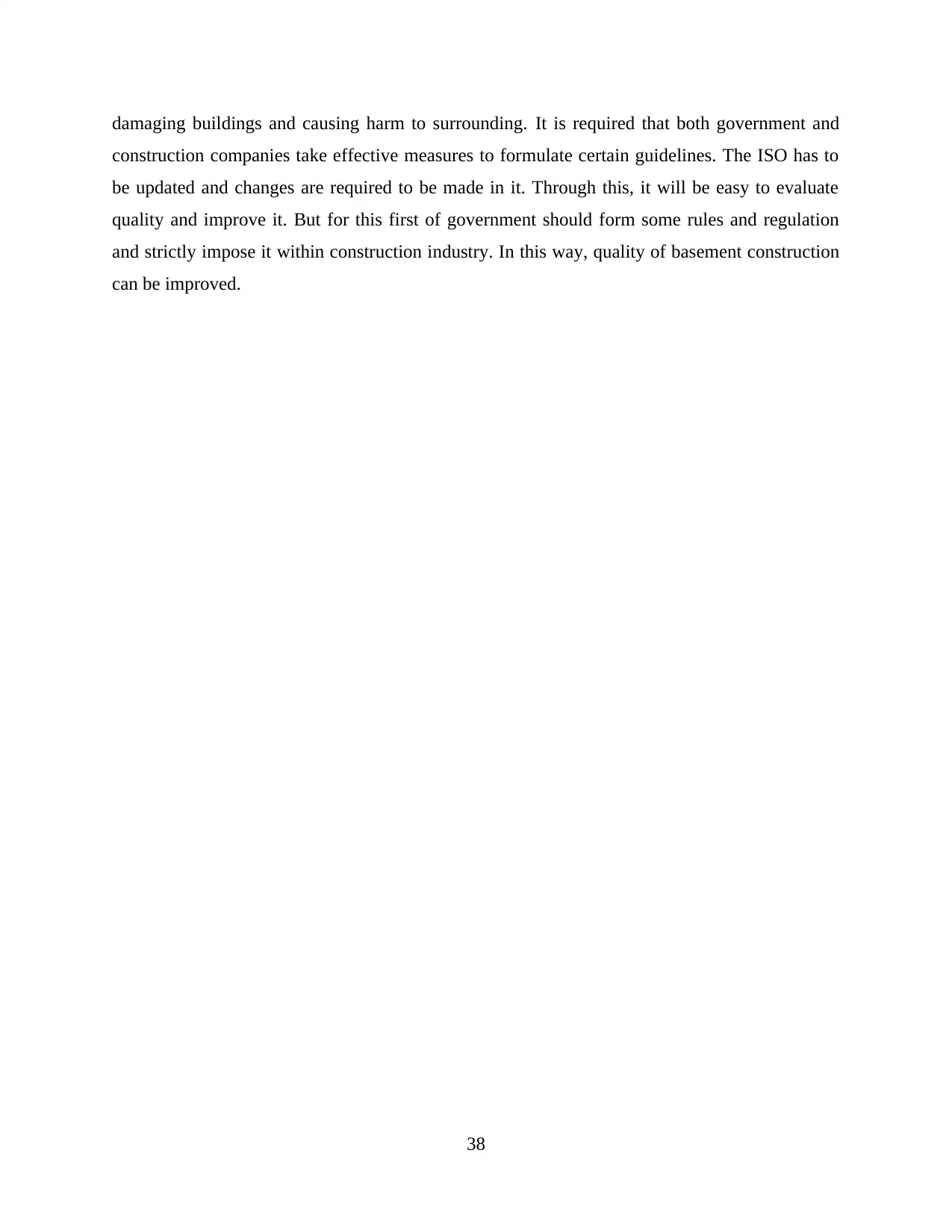
damaging buildings and causing harm to surrounding. It is required that both government and
construction companies take effective measures to formulate certain guidelines. The ISO has to
be updated and changes are required to be made in it. Through this, it will be easy to evaluate
quality and improve it. But for this first of government should form some rules and regulation
and strictly impose it within construction industry. In this way, quality of basement construction
can be improved.
38
construction companies take effective measures to formulate certain guidelines. The ISO has to
be updated and changes are required to be made in it. Through this, it will be easy to evaluate
quality and improve it. But for this first of government should form some rules and regulation
and strictly impose it within construction industry. In this way, quality of basement construction
can be improved.
38
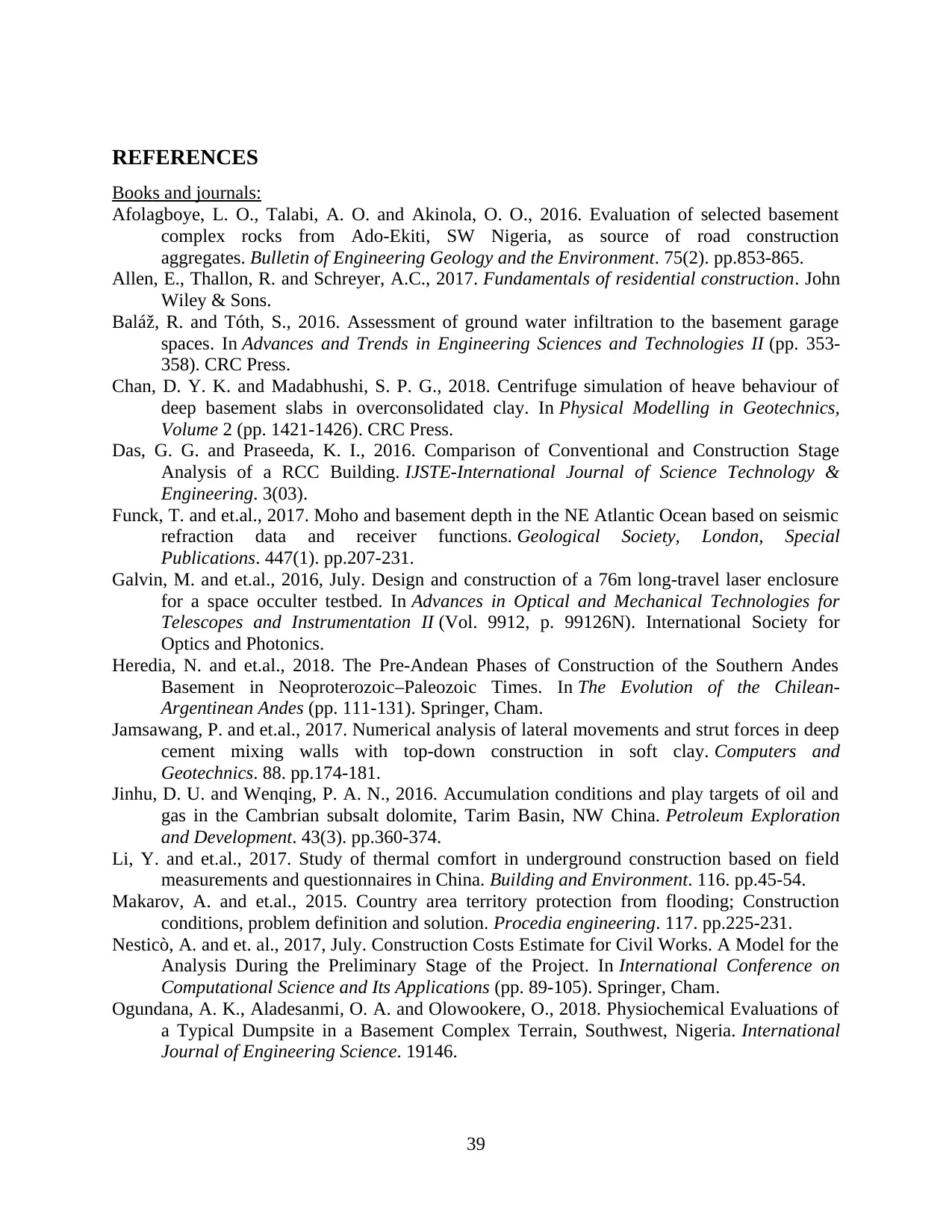
REFERENCES
Books and journals:
Afolagboye, L. O., Talabi, A. O. and Akinola, O. O., 2016. Evaluation of selected basement
complex rocks from Ado-Ekiti, SW Nigeria, as source of road construction
aggregates. Bulletin of Engineering Geology and the Environment. 75(2). pp.853-865.
Allen, E., Thallon, R. and Schreyer, A.C., 2017. Fundamentals of residential construction. John
Wiley & Sons.
Baláž, R. and Tóth, S., 2016. Assessment of ground water infiltration to the basement garage
spaces. In Advances and Trends in Engineering Sciences and Technologies II (pp. 353-
358). CRC Press.
Chan, D. Y. K. and Madabhushi, S. P. G., 2018. Centrifuge simulation of heave behaviour of
deep basement slabs in overconsolidated clay. In Physical Modelling in Geotechnics,
Volume 2 (pp. 1421-1426). CRC Press.
Das, G. G. and Praseeda, K. I., 2016. Comparison of Conventional and Construction Stage
Analysis of a RCC Building. IJSTE-International Journal of Science Technology &
Engineering. 3(03).
Funck, T. and et.al., 2017. Moho and basement depth in the NE Atlantic Ocean based on seismic
refraction data and receiver functions. Geological Society, London, Special
Publications. 447(1). pp.207-231.
Galvin, M. and et.al., 2016, July. Design and construction of a 76m long-travel laser enclosure
for a space occulter testbed. In Advances in Optical and Mechanical Technologies for
Telescopes and Instrumentation II (Vol. 9912, p. 99126N). International Society for
Optics and Photonics.
Heredia, N. and et.al., 2018. The Pre-Andean Phases of Construction of the Southern Andes
Basement in Neoproterozoic–Paleozoic Times. In The Evolution of the Chilean-
Argentinean Andes (pp. 111-131). Springer, Cham.
Jamsawang, P. and et.al., 2017. Numerical analysis of lateral movements and strut forces in deep
cement mixing walls with top-down construction in soft clay. Computers and
Geotechnics. 88. pp.174-181.
Jinhu, D. U. and Wenqing, P. A. N., 2016. Accumulation conditions and play targets of oil and
gas in the Cambrian subsalt dolomite, Tarim Basin, NW China. Petroleum Exploration
and Development. 43(3). pp.360-374.
Li, Y. and et.al., 2017. Study of thermal comfort in underground construction based on field
measurements and questionnaires in China. Building and Environment. 116. pp.45-54.
Makarov, A. and et.al., 2015. Country area territory protection from flooding; Construction
conditions, problem definition and solution. Procedia engineering. 117. pp.225-231.
Nesticò, A. and et. al., 2017, July. Construction Costs Estimate for Civil Works. A Model for the
Analysis During the Preliminary Stage of the Project. In International Conference on
Computational Science and Its Applications (pp. 89-105). Springer, Cham.
Ogundana, A. K., Aladesanmi, O. A. and Olowookere, O., 2018. Physiochemical Evaluations of
a Typical Dumpsite in a Basement Complex Terrain, Southwest, Nigeria. International
Journal of Engineering Science. 19146.
39
Books and journals:
Afolagboye, L. O., Talabi, A. O. and Akinola, O. O., 2016. Evaluation of selected basement
complex rocks from Ado-Ekiti, SW Nigeria, as source of road construction
aggregates. Bulletin of Engineering Geology and the Environment. 75(2). pp.853-865.
Allen, E., Thallon, R. and Schreyer, A.C., 2017. Fundamentals of residential construction. John
Wiley & Sons.
Baláž, R. and Tóth, S., 2016. Assessment of ground water infiltration to the basement garage
spaces. In Advances and Trends in Engineering Sciences and Technologies II (pp. 353-
358). CRC Press.
Chan, D. Y. K. and Madabhushi, S. P. G., 2018. Centrifuge simulation of heave behaviour of
deep basement slabs in overconsolidated clay. In Physical Modelling in Geotechnics,
Volume 2 (pp. 1421-1426). CRC Press.
Das, G. G. and Praseeda, K. I., 2016. Comparison of Conventional and Construction Stage
Analysis of a RCC Building. IJSTE-International Journal of Science Technology &
Engineering. 3(03).
Funck, T. and et.al., 2017. Moho and basement depth in the NE Atlantic Ocean based on seismic
refraction data and receiver functions. Geological Society, London, Special
Publications. 447(1). pp.207-231.
Galvin, M. and et.al., 2016, July. Design and construction of a 76m long-travel laser enclosure
for a space occulter testbed. In Advances in Optical and Mechanical Technologies for
Telescopes and Instrumentation II (Vol. 9912, p. 99126N). International Society for
Optics and Photonics.
Heredia, N. and et.al., 2018. The Pre-Andean Phases of Construction of the Southern Andes
Basement in Neoproterozoic–Paleozoic Times. In The Evolution of the Chilean-
Argentinean Andes (pp. 111-131). Springer, Cham.
Jamsawang, P. and et.al., 2017. Numerical analysis of lateral movements and strut forces in deep
cement mixing walls with top-down construction in soft clay. Computers and
Geotechnics. 88. pp.174-181.
Jinhu, D. U. and Wenqing, P. A. N., 2016. Accumulation conditions and play targets of oil and
gas in the Cambrian subsalt dolomite, Tarim Basin, NW China. Petroleum Exploration
and Development. 43(3). pp.360-374.
Li, Y. and et.al., 2017. Study of thermal comfort in underground construction based on field
measurements and questionnaires in China. Building and Environment. 116. pp.45-54.
Makarov, A. and et.al., 2015. Country area territory protection from flooding; Construction
conditions, problem definition and solution. Procedia engineering. 117. pp.225-231.
Nesticò, A. and et. al., 2017, July. Construction Costs Estimate for Civil Works. A Model for the
Analysis During the Preliminary Stage of the Project. In International Conference on
Computational Science and Its Applications (pp. 89-105). Springer, Cham.
Ogundana, A. K., Aladesanmi, O. A. and Olowookere, O., 2018. Physiochemical Evaluations of
a Typical Dumpsite in a Basement Complex Terrain, Southwest, Nigeria. International
Journal of Engineering Science. 19146.
39
Paraphrase This Document
Need a fresh take? Get an instant paraphrase of this document with our AI Paraphraser
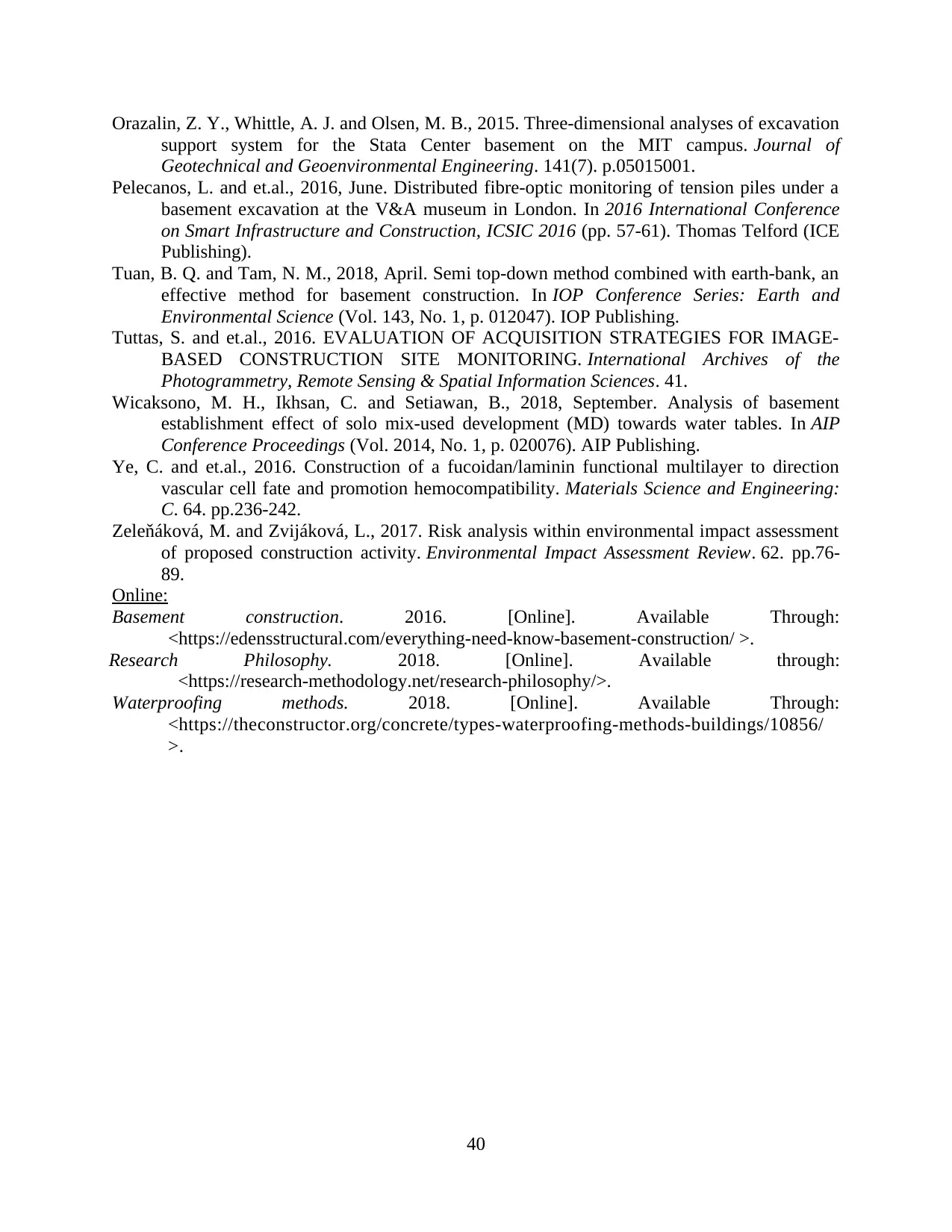
Orazalin, Z. Y., Whittle, A. J. and Olsen, M. B., 2015. Three-dimensional analyses of excavation
support system for the Stata Center basement on the MIT campus. Journal of
Geotechnical and Geoenvironmental Engineering. 141(7). p.05015001.
Pelecanos, L. and et.al., 2016, June. Distributed fibre-optic monitoring of tension piles under a
basement excavation at the V&A museum in London. In 2016 International Conference
on Smart Infrastructure and Construction, ICSIC 2016 (pp. 57-61). Thomas Telford (ICE
Publishing).
Tuan, B. Q. and Tam, N. M., 2018, April. Semi top-down method combined with earth-bank, an
effective method for basement construction. In IOP Conference Series: Earth and
Environmental Science (Vol. 143, No. 1, p. 012047). IOP Publishing.
Tuttas, S. and et.al., 2016. EVALUATION OF ACQUISITION STRATEGIES FOR IMAGE-
BASED CONSTRUCTION SITE MONITORING. International Archives of the
Photogrammetry, Remote Sensing & Spatial Information Sciences. 41.
Wicaksono, M. H., Ikhsan, C. and Setiawan, B., 2018, September. Analysis of basement
establishment effect of solo mix-used development (MD) towards water tables. In AIP
Conference Proceedings (Vol. 2014, No. 1, p. 020076). AIP Publishing.
Ye, C. and et.al., 2016. Construction of a fucoidan/laminin functional multilayer to direction
vascular cell fate and promotion hemocompatibility. Materials Science and Engineering:
C. 64. pp.236-242.
Zeleňáková, M. and Zvijáková, L., 2017. Risk analysis within environmental impact assessment
of proposed construction activity. Environmental Impact Assessment Review. 62. pp.76-
89.
Online:
Basement construction. 2016. [Online]. Available Through:
<https://edensstructural.com/everything-need-know-basement-construction/ >.
Research Philosophy. 2018. [Online]. Available through:
<https://research-methodology.net/research-philosophy/>.
Waterproofing methods. 2018. [Online]. Available Through:
<https://theconstructor.org/concrete/types-waterproofing-methods-buildings/10856/
>.
40
support system for the Stata Center basement on the MIT campus. Journal of
Geotechnical and Geoenvironmental Engineering. 141(7). p.05015001.
Pelecanos, L. and et.al., 2016, June. Distributed fibre-optic monitoring of tension piles under a
basement excavation at the V&A museum in London. In 2016 International Conference
on Smart Infrastructure and Construction, ICSIC 2016 (pp. 57-61). Thomas Telford (ICE
Publishing).
Tuan, B. Q. and Tam, N. M., 2018, April. Semi top-down method combined with earth-bank, an
effective method for basement construction. In IOP Conference Series: Earth and
Environmental Science (Vol. 143, No. 1, p. 012047). IOP Publishing.
Tuttas, S. and et.al., 2016. EVALUATION OF ACQUISITION STRATEGIES FOR IMAGE-
BASED CONSTRUCTION SITE MONITORING. International Archives of the
Photogrammetry, Remote Sensing & Spatial Information Sciences. 41.
Wicaksono, M. H., Ikhsan, C. and Setiawan, B., 2018, September. Analysis of basement
establishment effect of solo mix-used development (MD) towards water tables. In AIP
Conference Proceedings (Vol. 2014, No. 1, p. 020076). AIP Publishing.
Ye, C. and et.al., 2016. Construction of a fucoidan/laminin functional multilayer to direction
vascular cell fate and promotion hemocompatibility. Materials Science and Engineering:
C. 64. pp.236-242.
Zeleňáková, M. and Zvijáková, L., 2017. Risk analysis within environmental impact assessment
of proposed construction activity. Environmental Impact Assessment Review. 62. pp.76-
89.
Online:
Basement construction. 2016. [Online]. Available Through:
<https://edensstructural.com/everything-need-know-basement-construction/ >.
Research Philosophy. 2018. [Online]. Available through:
<https://research-methodology.net/research-philosophy/>.
Waterproofing methods. 2018. [Online]. Available Through:
<https://theconstructor.org/concrete/types-waterproofing-methods-buildings/10856/
>.
40
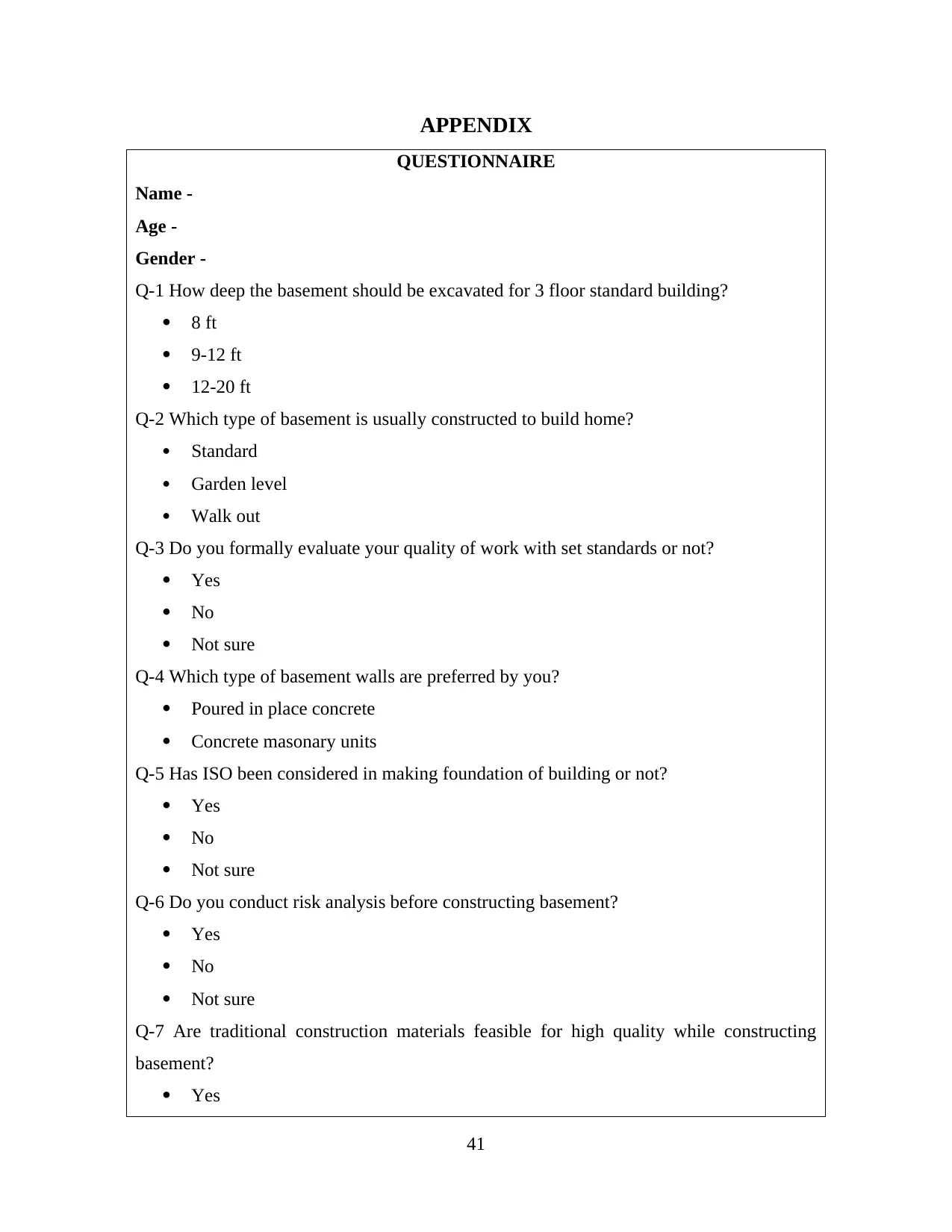
APPENDIX
QUESTIONNAIRE
Name -
Age -
Gender -
Q-1 How deep the basement should be excavated for 3 floor standard building?
8 ft
9-12 ft
12-20 ft
Q-2 Which type of basement is usually constructed to build home?
Standard
Garden level
Walk out
Q-3 Do you formally evaluate your quality of work with set standards or not?
Yes
No
Not sure
Q-4 Which type of basement walls are preferred by you?
Poured in place concrete
Concrete masonary units
Q-5 Has ISO been considered in making foundation of building or not?
Yes
No
Not sure
Q-6 Do you conduct risk analysis before constructing basement?
Yes
No
Not sure
Q-7 Are traditional construction materials feasible for high quality while constructing
basement?
Yes
41
QUESTIONNAIRE
Name -
Age -
Gender -
Q-1 How deep the basement should be excavated for 3 floor standard building?
8 ft
9-12 ft
12-20 ft
Q-2 Which type of basement is usually constructed to build home?
Standard
Garden level
Walk out
Q-3 Do you formally evaluate your quality of work with set standards or not?
Yes
No
Not sure
Q-4 Which type of basement walls are preferred by you?
Poured in place concrete
Concrete masonary units
Q-5 Has ISO been considered in making foundation of building or not?
Yes
No
Not sure
Q-6 Do you conduct risk analysis before constructing basement?
Yes
No
Not sure
Q-7 Are traditional construction materials feasible for high quality while constructing
basement?
Yes
41
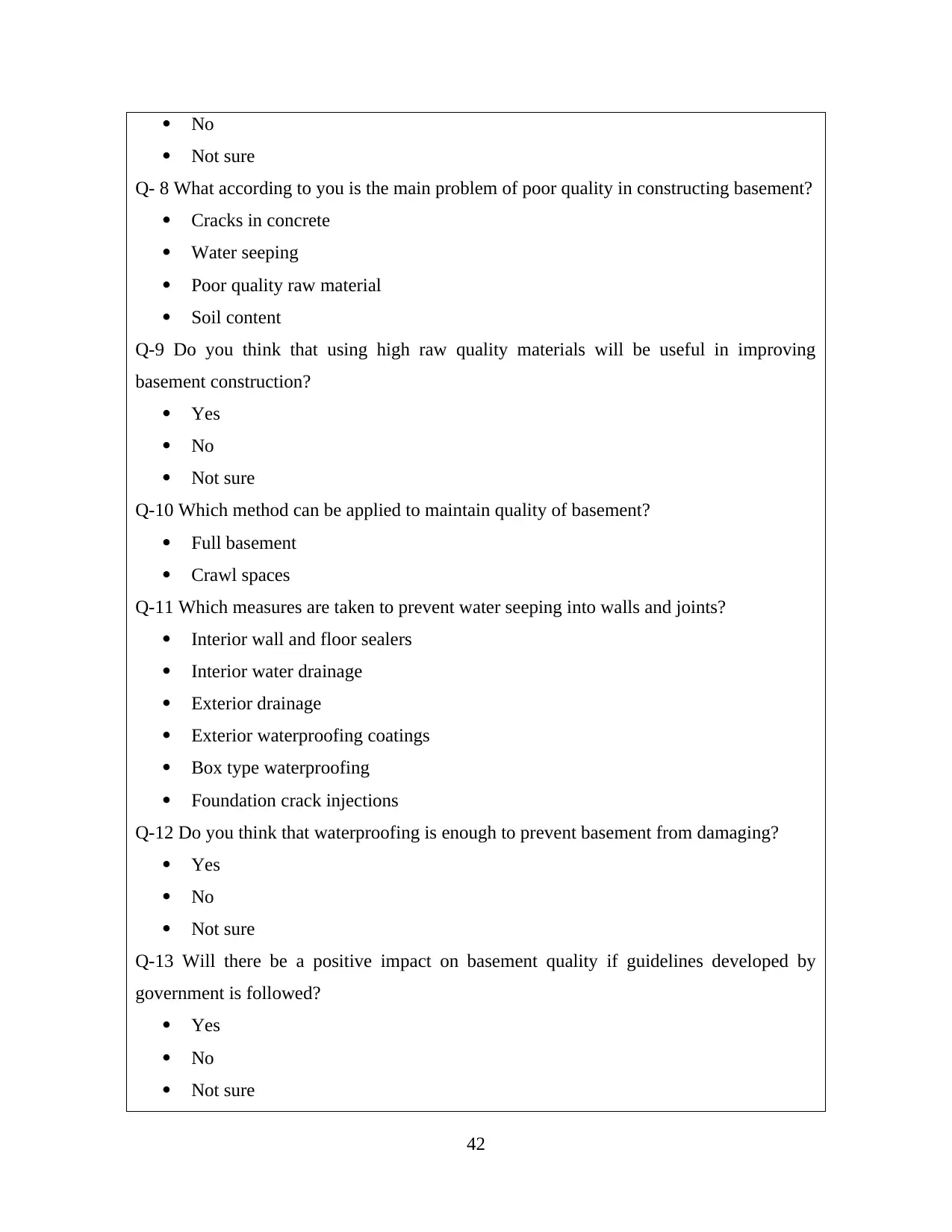
No
Not sure
Q- 8 What according to you is the main problem of poor quality in constructing basement?
Cracks in concrete
Water seeping
Poor quality raw material
Soil content
Q-9 Do you think that using high raw quality materials will be useful in improving
basement construction?
Yes
No
Not sure
Q-10 Which method can be applied to maintain quality of basement?
Full basement
Crawl spaces
Q-11 Which measures are taken to prevent water seeping into walls and joints?
Interior wall and floor sealers
Interior water drainage
Exterior drainage
Exterior waterproofing coatings
Box type waterproofing
Foundation crack injections
Q-12 Do you think that waterproofing is enough to prevent basement from damaging?
Yes
No
Not sure
Q-13 Will there be a positive impact on basement quality if guidelines developed by
government is followed?
Yes
No
Not sure
42
Not sure
Q- 8 What according to you is the main problem of poor quality in constructing basement?
Cracks in concrete
Water seeping
Poor quality raw material
Soil content
Q-9 Do you think that using high raw quality materials will be useful in improving
basement construction?
Yes
No
Not sure
Q-10 Which method can be applied to maintain quality of basement?
Full basement
Crawl spaces
Q-11 Which measures are taken to prevent water seeping into walls and joints?
Interior wall and floor sealers
Interior water drainage
Exterior drainage
Exterior waterproofing coatings
Box type waterproofing
Foundation crack injections
Q-12 Do you think that waterproofing is enough to prevent basement from damaging?
Yes
No
Not sure
Q-13 Will there be a positive impact on basement quality if guidelines developed by
government is followed?
Yes
No
Not sure
42
Secure Best Marks with AI Grader
Need help grading? Try our AI Grader for instant feedback on your assignments.

43
1 out of 47
Related Documents
Your All-in-One AI-Powered Toolkit for Academic Success.
+13062052269
info@desklib.com
Available 24*7 on WhatsApp / Email
![[object Object]](/_next/static/media/star-bottom.7253800d.svg)
Unlock your academic potential
© 2024 | Zucol Services PVT LTD | All rights reserved.





